- Skip to primary navigation
- Skip to main content
- Skip to primary sidebar
- Skip to footer
- KYD Insiders
- Tricia’s Cookbook
- Summer To Remember
- KYD Magazine

Keep Your Daydream
Rv newbie: setup checklist.
When we’re between seasons, it’s the perfect time to focus on creating highly requested videos. Now that we have over 100,000 miles of RVing experience, it was time to update our RV Setup checklist. This video covers the RV basics of setting up in an RV site, but it’s not designed to cover every detail. Rather, we wanted to draw attention to the required steps that must be done in order to set up safely.
What I learned from the comments ????
We create these videos to be helpful and teach but as always, we learn so much from the community. Below are some recommendations that should have been mentioned. We’ll add more as we learn more!
- Check to make sure the electrical and water are working before disconnecting. That will save you from having to reconnect and move sites (good tip!)
- The chocks are the last things to take off and the first things to put on, so keep them at the door to make it harder to forget.
- After connecting the surge protector to the panel to ensure the proper lights, turn the panel off and connect the power cord to your RV. Then turn the panel back on.
- Putting the filter on the RV side may filter any bacteria in the hose from sitting in the sun.
- I used to have a 90 degree elbow to connect the water and put less strain on the RV connection, but I haven’t replaced it yet. It’s a good thing to have.
**This checklist is designed for a travel trailer and may not be complete for your rig. Your RV may have other steps necessary to ensure the safety of you and your equipment.
Click the checklist to download !
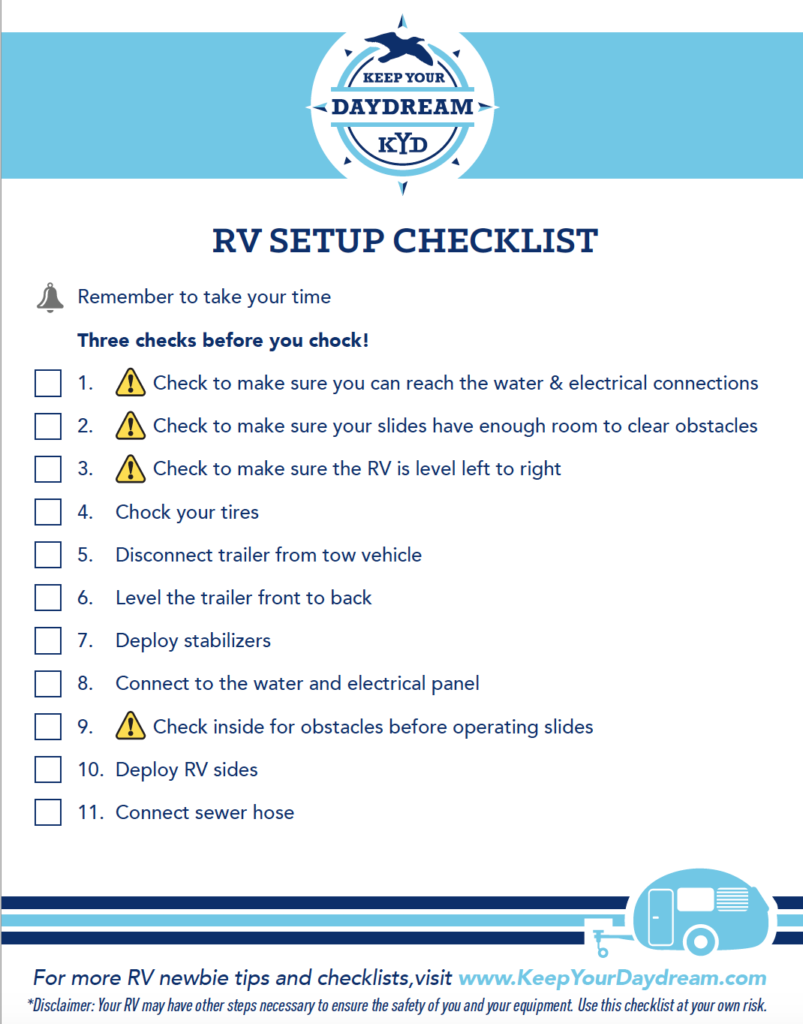
RV Newbie Essential Gear List
If you’re an RV Newbie, the amount of gear needed to get started can feel overwhelming. We’ve added all the essential gear to help you get started and a few non-essential items that will help make RV Life a little easier.
It’s best to first get everything you need for water, electrical and sewer hook-ups (those are truly the essentials) and then take a look at some of the items such as chairs and wagons that are “nice to have”.
Visit the KYD Amazon page and then look for our Essential Gear Catagory.
*We are a participant in the Amazon Services LLC Associates Program, an affiliate advertising program designed to provide a means for us to earn fees by linking to Amazon.com and affiliated sites.
Reader Interactions
December 3, 2018 at 4:19 am
Guys, We just brought home our first travel trailer and first thing we said was we need a checklist for things. I have been watching you guys and love your videos and now I love you guys for doing these checklists.
May 16, 2019 at 12:52 pm
1st time with used camper dont know much abt it. Need check list I’m overwhelmed
September 6, 2019 at 6:53 pm
I have a through detailed one for my Airstream but you can use it! Opening List- Stationery
Turn Water on Air Conditioner ( weather permitting) otherwise refer to step 3 if cool, then open Couch side window and Kitchen window then open the roof vent leave screen door open Set up chairs rinse them all off including the chairs on fire pit Weather permitting ( no rain or heavy wind) Open the awning. Undo the latch(es) get the rod hook the strap pull outwards drop rod when fully extended, hold onto the valence go to end flip the grey latch, make sure it won’t go back up. Take the rafter arm and put on wheel lock it into place repeat on other side. Raise Awning 4 holes on the front side and 3 on the backside. Roll up if rain or wind will be present. Set up the umbrella Set up a table ( it is in the bumper of Airstream.) Clean off some things Set the radio up Get anything needed out of yellow/black storage chest in back ( at night turn on blue led lights outside
PACK UP LIST (STATIONARY) Stack Chairs one by one against the “ Excella Part” of the Airstream ** DO NOT PUT AGAINST THE METAL LEAVE 1 inch of space in between. Clean Up anything Put the front leaning down on fire pit Empty the Ice Chest Put Radio away Put anything that was in yellow/black chest back in it, put back where it was. Put umbrella down put the cover on it ( in the passenger-side storage unit.) Put the awning down. Refer to the setup list do the opposite of that. Do a quick walk around In the Morning make sure to turn the water off. Run the lines clean
Winter Pack Up ( Stationary)
Winterize (refer to the manual for how to do it) Chairs stacked in the very back The umbrella under the trailer The table flipped upside down and put in the back Radio take back home and yellow bucket back home Take all things out of trailer that can be frozen Bring out Woodburner Fill Propane up
Pack Up ( Mobile)
Empty Tanks Empty Water Latch all cabinets TVs on floor ( front) blanket over it Tv backroom put in the very far corner with a blanket over it Antenna down All shampoo, soaps, etc put in sinks or showers Disconnect electric Disconnect water Wheel chocks Outside latch awning Stairs Lube ball and hitch Tire pressure and lugnuts Make sure all compartments are latched shut Disconnect brake secured The main door locked + all curtains shut. Tug Test 15 feet pull ahead
Set Up Mobile
DO THE REVERSE OF EVERYTHING LISTED ABOVE
June 24, 2020 at 1:48 pm
Thank you for the list.
December 3, 2018 at 7:48 am
Thank You for Guidance. My wife and I are just now shopping for a trailer i have 2016 Ford Expedition, factory ready for towing. How can we learn about quality trailer manufacturers. There Are so many, some with major brand names, others we are not familiar with. We would like to have a quality unit. We prefer a unit within a interior the dimention of 25 to 30′ for the 2 of us with one to to slide outs. Your followers from Mesa, AZ
April 20, 2019 at 5:30 am
In our search (mainly my wife) we found that many manufactures have forums. We also went to independent travel trailer repair / supply stores and would inquire about different manufactures. We were fortunate to find an individual that refurbishes trailers and assisted us with our quest. We did purchase a used trailer similar to your requirements; 27RKSS which is 33.5′ total length. One warning! Although extremely pleased and blessed with our first trailer; we discovered that it is a little bit too much for our 1/2 ton (GMC Sierrra w/ heavy duty tow package). Although we were about 3500 shy of the GMC’s towing capacity; in the hills of the Ozarks we really felt the truck struggle. We are planning longer trips so out west so we upgraded to a 3/4 ton truck.
December 3, 2018 at 1:15 pm
Thank you for the newbie setup video. I really like the no kink 50′ hose. I don’t see that hose referenced on your Amazon list. Please share the brand of the hose Thanks Tom
November 15, 2019 at 4:13 am
Same! Could you share a link to the no kink hose?
November 17, 2019 at 6:19 pm
Here you go. It’s in our essential list. https://www.amazon.com/shop/keepyourdaydream
June 19, 2020 at 11:48 pm
I found one at Bed Bath & Beyond
December 3, 2018 at 3:32 pm
What order Does the surge protector, dog bone, and electrical cord go in?
December 5, 2018 at 6:25 am
Thanks, Loved your Set-Up CHECKLIST & Newbie Essential Gear List and video! I really enjoy your positive attitude and the way your lovely family makes the RV lifestyle look like So Much Fun. B-T-W, you may want to check the spelling on Checklist #10 (slides vs. sides, maybe?).
April 6, 2019 at 3:38 pm
how do I find you on Amanon
April 23, 2020 at 7:55 am
This is the link to their RV Essentials list… https://www.amazon.com/shop/keepyourdaydream
April 15, 2019 at 3:01 pm
Have been following and learning with you from the beginning of your adventures. Such great information and experiences! We are on our way now too! Just bought our 1st Home, it is a 2019 Grand Design Reflections 337RLS and LOVE it! Safe travels to you and thank you for the check list. Hope we meet you on the road! Tom and Brittany
April 19, 2019 at 12:17 pm
We pick up our new (and first-ever) Winnebago Micro Minnie 2108ds this weekend. Finding info from experienced travelers like you is so helpful! Thanks much for creating and posting the checklists for gear, setting up, etc.
April 20, 2019 at 5:31 am
May 30, 2019 at 3:37 pm
We are first time RVers and your RV Newbie Set Up Video and Checklist are the best!
Question: can the regulator be attached to water source before the the y-splitter?
June 6, 2019 at 11:43 pm
My wife and I just bought our first RV a week ago. I stumbled across your videos on YouTube and I just wanted to say “Thank You” for all the great videos for newbies !!! You two Rock !!!
June 13, 2019 at 2:09 pm
Question! Is that hose good for drinking water?
September 18, 2019 at 5:23 pm
Hi there: This setup checklist is simple and perfect! Do you have one written for when it’s time to head out?
September 18, 2019 at 5:35 pm
Nevermind: I found it! Fantastic! I figured out to search using “tear down”. Thanks!
September 30, 2019 at 2:21 pm
I’m pretty sure you can download it on the blog. Link in the video description.
October 8, 2019 at 1:24 pm
Thank you for Newbie lists. Much appreciated.
February 23, 2020 at 5:36 am
My husband and I just found you all about two weeks ago and have become addicted as we watch you while shopping for a used rig on-line. Hope to gut an older model (we like that kind of thing…) and hit the road in 2021.
July 9, 2020 at 7:10 pm
what TPMS system do you recommend?
July 12, 2020 at 5:38 pm
we are waiting to get our Trailer. We have been scouring the Interwebs watching all sorts of Travel Trailer videos. We really enjoy and appreciate what you put out. Thank you
August 12, 2020 at 6:15 pm
I didn’t see any reference to the hot water heater on the setup checklist. Is that not an essential item?
January 6, 2021 at 12:18 am
shouldn’t you level the trailer side to side before disconnecting it? Thanks for the helpful videos.
January 6, 2021 at 12:24 am
Just a thought: 3A should be level the trailer side to side before un hooking. Thanks for the fantastic videos.
February 4, 2021 at 11:24 pm
We are renting our first trailer in 3 weeks. I saw you You Tube video for Newbies and have watched it twice; downloaded the checklist and made notes from the gear list. We are going from the Houston area to Big Bend State Park. Will let y’all know how we made out. we will rent for a year or so to be sure we want to buy our own, then if no catastrophes, we will probably buy. Thanks for your help.
February 14, 2021 at 5:41 pm
I really like your FB page, and find it very useful. Although I had a toyhauler TT a while back, I still consider myself a newby, especially since I will start full-timing in the near future.
I found this site because I was looking for a campground setup checklist. I really like the list you have, it helped immensely in building one for my use. I just so happen to have a gooseneck toyhauler, so modified it to meet what I hope are my specific needs. There are some things on here many will not need but Some may. I added checking the power pedestal as one of the first items. Wouldn’t want to backtrack too much it it’s jacked up. Feel free!
Upon Arrival Check to make sure you can reach the water & electrical connections Check to make sure slide(s) have enough room to clear obstacles Check for good, clean power at pedestal. Make sure circuit breaker is off, connect surge protector, and turn breaker on. If surge protector shows good, turn breaker off. If power is unacceptable, contact management Level RV side to side Chock tires Use landing gear to raise trailer from hitch. Watch for side to side shifting Disconnect 7-way connector from tow vehicle Disconnect camera cable from tow vehicle Disconnect safety chains Pull tow vehicle from under trailer Outside Setup Level trailer front to back Connect power cable to surge protector. Turn pedestal circuit breaker on Connect all filters and water hoses. Turn on spigot Connect sewer hose Inside Setup Check for obstacles before deploying slide(s) Deploy slide(s) Check for any loose items that may have been jostled during transit. CLEAN IT UP!
February 23, 2021 at 8:41 pm
We LOVE your videos! We are SUPER RV Newbies and your videos have been such a huge help to us! Thank you so much for your videos. Please keep them coming!
April 24, 2021 at 9:58 pm
we have our first RV Trailer after tent-camping for YEARS. IT is so overwhelming Still sitting in our driveway We hope to get over the first time jitters and actually take it out. Have to figure out how to de-winterize it first. ugh
May 18, 2021 at 12:35 am
Surfing the net looking for a simple set up checklist. And of course the one I immediately liked best was from you guys!!! Thanks for the list and for videos that make learning fun and inspirational. Safe travels and happy camping.
May 19, 2021 at 9:28 pm
We love your checklists and have used them faithfully for 2 years. However, we’ve found we need to add/change some things here & there. Is there any way your checklists can be edited?
August 21, 2022 at 11:29 pm
Export KYD List as a pdf and save to your computer. Open it in a pdf editor.. I like Adobe if you don’t have one (they allow you to modify almost any document, and fill and sign forms digitally!). Edit the list at will, save and print. Update it as often as you need.
July 9, 2023 at 2:54 pm
This is a great checklist for RV newbies!
July 11, 2023 at 10:28 am
April 18, 2024 at 10:54 am
Your updated RV Setup checklist video offers essential guidance for newcomers, emphasizing crucial steps for safe setup. Community feedback enriches the learning experience with practical tips and reminders, making your channel a valuable resource for RV enthusiasts. Keep up the fantastic work!
Leave a Reply Cancel reply
Your email address will not be published. Required fields are marked *
Where Are We Now?
Keepyourdaydream.

- KYD Partners
Popular Posts
- Season 4 Route & Plan
- Ep 100: How We Turned “Someday” Into Today!
- RV Newbie? Top 10 things a new RVer should know!
Looking for something?
Keep in touch, join the kyd community.
You’ll receive the once-per-month “KYD Drop” loaded with inspiration, ideas and stuff to make you smile 😀
- First Name *
- Email Address *
- Email This field is for validation purposes and should be left unchanged.
Ultimate RV Setup Checklist (Printable PDF)
Read this page without ads! Go Ad-Free
Our comprehensive RV setup checklist will guide you step-by-step, ensuring a seamless arrival and setup at your campground.
Tip : Download our Printable RV Arrival & Departure checklists and check off each of these steps as you complete them for a stress-free setup and teardown – no WIFI needed!
Arrival at Your Chosen Campground
Upon reaching your destination, follow these steps:
- Check-In and Get Your Campsite Number : Register at the campground office and get your assigned campsite number.
- Use Discount if Possible : If you have memberships with RV clubs like Good Sam, take advantage of these offered discounts.
- Confirm Campsite Has All Requested Amenities : Double-check that your site is equipped with the amenities you need for your stay, such as electricity, water, and sewage connections.
- Get a Map and Rules List for the Campground : Familiarize yourself with the campground layout and its regulations to ensure a smooth and respectful stay.
- Inquire About Points of Interest in the Area : Ask about local attractions, hikes, or events to make the most of your trip.
Arrival at Your Designated Campsite
Once at your site, run down this campsite setup checklist:
- Visually Confirm Site Has Needed Amenities : Do a quick visual survey of your campsite to ensure it’s equipped with all the necessary facilities, like power or sewage hookups.
- Plan Your Entry Path : Plan how you’ll maneuver your RV into position, be it pull-through or back-in.
- Inspect Campsite for Hazards or Obstructions : Check for potential obstacles like tree branches or rocks that could interfere with parking or setup.
- Park Your RV : Position your RV on the site, allowing enough room for slideouts and the awning. Be sure to keep kids and pets in your vehicle when you park, use a spotter to help guide you safely, and take it slow!
- Turn on Your Emergency Brakes if Driving a Motorhome : Secure your vehicle by engaging the emergency brakes.
- Check to Make Sure You Can Reach Hookups : Verify that your RV’s cords and hoses can comfortably reach the site’s water, electrical, and, if applicable, sewer hookups.
- Level RV : Use leveling blocks or your RV’s built-in leveling system to ensure a stable and even living area.
- Connect to Shore Power : Plug in your electrical cord to the site’s power supply to run your RV’s electrical systems.
- Connect Water Lines : Hook up your water lines to access fresh water.
- Connect Sewer Hose : Attach your sewer hose to properly manage waste.
- Turn on the Propane : Turn on your propane supply to power your gas-powered appliances.
- Roll Out Awning : Unroll your awning, taking care to secure it safely.
- Lower Handrails and Entry Steps : Ensure safe entry and exit by lowering the handrails and steps.
- Campsite Setup : Arrange your outdoor furniture and accessories to create your perfect outdoor living space.
Unhitching (If Applicable)
- Chock Tires : Secure your RV from moving unintentionally by placing chocks around the tires.
- Put Support Blocks Down & Lower Jacks : Establish further stability by using support blocks and lowering the RV’s jacks.
- Disconnect the Electrical Cord from the Tow Vehicle : Detach the electrical connection from the tow vehicle to the RV.
- Disconnect the Breakaway Cable from the Tow Vehicle : Unhook the safety breakaway cable from your tow vehicle.
- Unhitch RV : Detach the RV from the tow vehicle.
Now, let’s prepare the inside of your RV:
- Extend Slideouts : Extend any slideouts your RV has to increase living space.
- Turn on the RV Refrigerator : Start cooling your refrigerator to store food safely.
- Turn on A/C or Heater : Based on weather conditions, turn on either the A/C or heater to maintain a comfortable temperature.
- Open Roof Vents : Promote good air circulation by opening your roof vents.
- Light Pilot on the Oven : If your stove has a pilot light, make sure it’s lit and ready for cooking.
- Turn on the Water Heater : Activate your water heater for warm showers and dishwashing.
- Extend Antenna : Raise your antenna for better TV or radio reception.
- Test Water Lines : Turn on faucets to ensure all water lines function properly.
- Set up Furniture : Arrange interior furniture as desired for your comfort and convenience.
- Unpack Items : Remove items from storage and place them in their designated spots for easy access.
Using these steps as your guide, you can ensure that your arrival and setup at any campground go smoothly and efficiently. Combine this with our RV Departure Checklist , and you’ll have your entire camp setup and teardown process completely covered!
Better yet, we have put all of these steps into a simple-to-follow printable RV setup checklist that you can download, print, and reuse over and over as many times as you want!
These PDF checklists are easy to use and come with blank copies, so you can make them work for you and your RV. Get your RV Arrival & Departure Checklists today and take the hassle out of the setup and teardown process!
Common Setup Issues and Troubleshooting
No matter how well-prepared you are, unexpected issues can arise while setting up your RV.
Wrong Electrical Connection
In some instances, your RV’s electrical system might not match the site’s power source, which could lead to power issues. Always carry adapters for different types of electrical connections. Be aware of your RV’s power requirements to prevent damage to your RV’s electrical appliances and systems.
High-Pressure Water
An unexpectedly high water pressure can lead to damaged plumbing within your RV. To avoid this, always use a water pressure regulator when connecting your RV to a water source. This will ensure that the water pressure stays within a safe range.
Power Cord Doesn’t Reach the Pedestal
In certain situations, you might find that your power cord isn’t long enough to reach the campground’s power pedestal. Always carry an extension cord suitable for your RV’s power requirements to avoid such issues. Be aware that using extension cords can lead to power loss, so use them sparingly and only when necessary.
Uneven Leveling
An uneven RV can lead to unstable walking conditions inside and can even affect the functioning of some appliances. Always carry leveling blocks or consider investing in automatic leveling systems to deal with uneven terrain. Should your RV not appear level even after your initial setup, re-adjust and use your leveling system to correct this.
Water Leakage
Water leaks can cause significant damage to your RV. Always check your water system during the setup process to prevent leakage issues. Ensure all connections are tight and the seals are in good condition. If you detect a leak, turn off the water supply immediately, identify the source, and repair it. For securing the connections, consider using plumber’s tape for a more secure fit.
Slide-out Issues
Slide-out rooms in your RV can occasionally encounter problems. Whether they refuse to extend or retract, such issues can be caused by several factors, like low battery voltage, blown fuses, motor failure, etc. Understanding your slide-out mechanism and maintaining it properly can prevent such problems.
Leave a Comment Cancel reply
We highly encourage discussion on our posts and in our RV Community Forums . The most helpful comments are those that you can learn from or that help others out. Please refrain from insults, complaints, or promotional material. See our community guidelines for more information.
Save my name and email for the next time I comment.
Notify me of follow-up comments via e-mail.

Complete RV Checklists That Works! (For Beginners)
Checklists are the greatest, aren’t they? They make packing and setting up before, during, and after a trip much easier.
In this post, we’ll give you 3 separate checklists.
- One for packing
- one for setting up,
- and one that lists the absolute essentials needed for a successful RV trip.
Table of Contents
Packing List Details Before We Start…
There are many items you’ll need to consider taking when packing for an RV trip. Some of these items are RV or vehicle specific and others are just a part of everyday life. Other items are purely for fun but are still a very necessary part of packing up for an RV trip.
I organized the RV checklists by category so you can go through each checklist in order to make sure you have everything you need.
The Vehicle and Trailer Checklist
The first checklist has all of the items you’ll definitely want to have for taking care of your vehicle and your camper. This list includes emergency roadside items like air compressors and battery jumpers as well as the tools you’ll need to complete these tasks.
It also includes the items you’ll need to successfully set up your RV on-site and while on the road. Forget any of these items and you may not be able to get all of the functionality from your RV. These items include things like leveling blocks, drinking hoses, and electrical adapters.
The adapters you need will vary depending on what type of RV you have. For example, people with a 50-amp electrical system may want to bring a 50-amp to 30-amp plug and people with a 30-amp electrical system may want to bring a 30-amp to 50-amp plug. You may even want to bring a converter that converts these plugs to standard 15-amp electrical outlets.
Daily RV Life Checklist
The next checklist goes over the items that you’ll need on a day-to-day basis. These items include food, water, clothing, medicine, personal hygiene items, and anything else you might use while living in your RV.
I went over the basics with these items and listed items out generically but you should make them more specific to your needs when applicable. For example, if you take two types of medicines each day, instead of listing them as medicine, you might want to write out the name of each specific medicine so you won’t forget either one.
The same idea applies to personal hygiene items as well. If you know you need a WaterPik or some other personal cleaning item then you’ll want to write it in under personal hygiene. I’ll add some of these items under the Daily RV Life Checklist to give you some inspiration.
Fun RV Checklist
Not all places end up being fun. This is especially true when it rains. Just because you end up stopping someplace where there aren’t a lot of fun activities, doesn’t mean you can’t have fun.
I created a short RV checklist of fun items that you might want to bring to keep yourself occupied during short stays at locations without much to do or during prolonged periods of being stuck in the rain.
If you have specific games you like to play then you might want to add them underneath of games. I’ll add some camping equipment suggestions but you may want to add your own specific camping equipment as well.
Checklist for Setting Up
The checklist for setting up will give you a step-by-step guide to setting up your RV. It is a printable RV checklist that you can take with you to help you get set up quickly and easily. Use it at the campsite or even while stopping for a few hours while out on the road.
Do the checklist in reverse when you want to break camp. This checklist is short enough that you can print it out and tape it to the inside of your RV door to use as a reference.
RV Essentials Checklist
The RV essentials checklist lays out the bare minimum you need to have a successful RV trip. Take these items and you’ll at least be able to get to your destination and set up without any trouble.
This checklist includes RV-specific items like leveling blocks, water hoses, and sewer hoses. It also includes the very basics of everyday living like food, water, and medicine. These are all of the items that you’ll want to double-check to make sure you have before you leave for your destination.
For the Vehicle and Trailer
- Roadside emergency kit.
- Chock blocks.
- Leveling blocks.
- Stabilizer jacks.
- Towing equipment.
- Portable battery jumper and jumper cables.
- Extra vehicle fluids. (windshield wiper fluid, oil, etc.)
- Jack and lug nut wrench for changing tires.
- Air compressor.
- Tire pressure gauge.
- Lift mechanism – (for popup camper owners)
- Electrical adapters.
- Drinking water hose.
- Water pressure regulator.
- Sewer hose.
- Black water tank cleaning tools.
- Fire extinguisher.
- Extra light bulbs.
- Bungee cords.
For Daily Life
- Medical equipment.
- Vitamins and supplements.
- Cell phone.
- Animal-proof food storage.
- Generator fuel.
- Kitchen utensils.
- Can opener.
- Bottle opener.
- Trash bags.
- Toilet paper.
- Paper towels.
- Washcloths.
- Personal hygiene items.
- Cleaning tools.
- Sheets, blankets, and pillows.
- Battery chargers.
- An extension cord.
- A first aid kit.
- Flashlights and lanterns.
- Sunglasses.
- Wet-weather gear.
Kitchen Suggestions
- Coffee maker.
- Coffee mugs.
- Coffee filters.
- Water strainer.
- Forks, spoons, and knives.
- Large spoons.
Personal Hygiene Suggestions
- Conditioner.
- Toothbrush.
- Toothpaste.
- Water flosser.
- Moisturizer.
- Campfire wood.
- Camping gear.
- Fishing gear.
- Toys for the kids.
- Sports equipment.
- Games for rainy days.
- Playing cards.
- Televisions.
Camping Equipment Suggestions
- Sleeping pad.
- Sleeping bag.
- Camp stove.
- Hiking boots.
- Water bottles.
- Flotation devices.
- Cross-country skis.
- Make sure the vehicle is parked close enough to the RV hookups. (sewer, water, and electric)
- Level the RV from side-to-side.
- Unhitch your RV.
- Level the RV from front-to-back.
- Place chock blocks behind your tires.
- Stabilize your RV.
- Make sure everything inside is safe and in place.
- Hookup your electrical connections.
- Hookup your sewer connections.
- Hookup your water connections.
- Turn on your propane tanks.
- First-aid kit.
How to Pack for Your Next RV Trip
These lists wouldn’t be any good if you didn’t know how to pack all of the items that we just listed. In this section, I’ll give you detailed information on how to pack everything up. Here is what we’ll cover.
- Where to put your belongings.
- How to store your belongings.
- Securing your items.
Where to Store Your Belongings
An RV needs to be loaded appropriately for it to be safe. For most trailers, this means that 60% of the weight should be in the front half of the RV and about 10% of this weight should be on or near the tongue of the trailer.
Because of this fact, you need to be careful where you put your gear and other items. For example, many people store their batteries and propane tanks on the tongue of their camper. This may not be a great idea as you might end up going over the 10% weight limit for your tongue.
To find out how much weight you have on your tongue, it may be a good idea to buy a hitch scale. These scales help you determine how much weight you actually have loaded up at the tongue.
You have to be careful how you load your camper from side-to-side as well. Too much weight placed on one side of the camper will increase trailer sway. This is true for people with motorhomes as well. You don’t want to drive a motorhome with all of the cargo loaded into one side of it.
For rear-wheel drive motorhomes, you’ll want to place the weight centered on or just in front of the rear axle. This will help give you more traction and will improve your motorhome’s handling.
See my post on “ How to Keep Your RV from Swaying “.
How to Store Your Belongings
One great tip for storing belongings in RVs and anywhere else is to use clear containers. Clear plastic bins give you the ability to see what’s in the bin at a glance. Even better, if the lid for the clear bin is also clear.
You can even place smaller clear bins inside of larger ones to help keep everything organized and in one place. I’ve even seen some larger clear bins with built-in wheels and a handle. Bring along a thick sheet of plywood and you’ll have a ramp to roll your wheeled bin down.
Items placed in the refrigerator may need to be padded. Soft fruits and vegetables might roll around in an RV refrigerator and we all know that bruised fruit spoils faster and doesn’t taste nearly as good as fruit that was well cared for. Wrap your fruits and veggies in paper towels and place them securely in bags so that they don’t move around while in transit.
Securing Your Items
An item placed inside of a camper or motorhome must be properly secured. This is especially true for dangerous kitchen items as well as fragile appliances, dishware, and camping gear.
For starters, make sure everything is in a cabinet, drawer, or bin. Make sure items in drawers and cabinets don’t have a lot of room to move around and secure them inside when necessary. You wouldn’t want to get to your destination only to have everything fall out of your cabinet as soon as you open it would you?
Once everything is securely in place, make sure that the drawers and cabinets will stay shut during transit. In some cases, this may mean you have to tie the cabinets up or place straps around the drawers. Keep them from opening up while driving and you won’t have a mess to clean up when you get to your campsite.
Other Considerations to Think About When Packing
- Dual-purpose items.
Weight Limits
Campers and motorhomes literally allow us to bring everything, including the kitchen sink. However, there weight limits to consider when packing for an RV trip.
Your camper or motorhome will have a GVWR number that you’ll need to abide by. This number includes the weight of your trailer or motorhome so keep this in mind as you tally up final weights to see what you can bring.
Also, keep in mind that every ounce of weight you add to your camper or motorhome will reduce your gas mileage and make your RV more difficult to travel with. Reduce the total weight of your RV and you’ll save money as well as the environment.
Size Restrictions
An RV doesn’t have an unlimited amount of space. Overpack and you may find yourself walking around objects in your RV all day long. This can quickly get frustrating and it can make it more difficult for you to get to the items you actually need.
Only bring the items you’ll actually need for your trip and leave the rest at home. Doing so will save you time, money, and a lot of frustration. After all, you’re on vacation, why not take a break from some of your stuff?
Dual-Purpose Items
A great way to reduce the amount of gear you need to bring with you is to buy items that can serve more than one purpose. On a very basic level, this could be a can opener that also works as a bottle opener. Or a fork that also works as a spoon.
On a more advanced level, you might get a convection oven instead of a toaster and a microwave. An appliance like this will save a lot of space as you’ll be able to completely eliminate the need to have two appliances.
If you need inspiration, look at ultra-light camping gear. I have seen radios that also act as emergency beacons as well as handheld flashlights. A tool like this turns three different pieces of gear into one.
Dual-purpose items save space, reduce weight, and reduce the total number of items you have to pack – it’s a triple win.
What NOT to Bring On Your Next RV Trip
We talked about what to bring when taking an RV trip but there are also items that you shouldn’t bring as well. Here is a quick list of items for you to consider leaving behind. I’ll explain the list in more detail afterward.
- Kitchen equipment.
- Pepper-spray.
- Recreational drugs.
When you first look at this list it might seem crazy not to bring food, water, and other essential items. However, if you’re traveling across borders you may not be able to transport some of these items. Even food needs to be discarded when traveling from the United States into Canada.
Some items can’t even legally be transported across state lines. For example, it is technically illegal to bring alcohol purchased in one state into another state. While you’re unlikely to get in trouble for doing so it is something you might want to consider.
If you’re traveling to another state or country, pick up your food, alcohol, and tobacco products when you get there.
Some items may not even be legal to use in some areas. For example, people living in Colorado can legally use marijuana. In other states, you can get put in jail for having too much of this substance on your person. The same holds true for pepper-spray. It is perfectly legal to carry pepper spray around with you in Pennsylvania but it is illegal to do so in New York. If you’re traveling through New York, it might be a good idea to buy pepper spray when you get closer to your final destination.
In most cases, you’ll want to leave most of your water tank empty as well. Driving with a full water tank puts additional strain on the holding tank and adds significantly to your RV’s weight. Put about 5 gallons of water in each of your tanks and fill the rest up when you get close to your destination. In most cases, you’ll be able to fill-up on-site anyway.
Finally, decide what you’re going to eat before you head out on your trip. This will eliminate the need to take kitchen appliances and utensils that you know you will not be using on your trip.
So now you know what to bring on your next RV trip and what not to bring on your next RV trip. Use these checklists as a guideline and refine them to meet the particular needs of your family and you’ll never forget anything again.
Click to share...

- Find a Location
A Comprehensive RV Setup Checklist for Your Campsite

This checklist begins once you’ve checked into your campground and located your site. Here’s everything you need to think about to get your RV ready for daily living:
- Scout your site. Assess the space to determine whether you can pull through or have to back in. Determine how you want to position your RV to make it easier to level and ensure clearance on all sides (above as well) for your entry steps, slide-outs, and awnings.
- Disconnect your toad or dinghy (Only motorhomes towing a second vehicle).
- Use a spotter to pull in. Even if your RV has a backup camera , your travel companion should know how to guide an RV , be willing to help, and be easily seen by the driver.
- Position your RV within reach of hookups. The lengths of your sewer hose, electrical cord, and potable water hose determine this distance.
- Install leveling blocks as needed. Use leveling blocks under your wheels to raise your RV and level it from side-to-side (for towable RVs) or side-to-side and front-to-back (for motorhomes).
- Chock the wheels. Set these in place to ensure your RV doesn’t shift.
- Disconnect your tow vehicle ( Towable RVs only) . Remove the electrical connection, breakaway cable, safety chains, and any weight distribution hitch components before using the tongue jack to lift your trailer off your vehicle’s hitch ball.
- Pull your tow vehicle away ( Towable RVs only). Allow yourself space to easily unload items from your tow vehicle’s trunk.
- Raise or lower the tongue jack or landing legs to level the unit (Towable RVs only). Use a bubble level to check your work from front to back and side to side.
- Extend stabilizing jacks. Place jack pads or 2”x4” wooden blocks beneath and extend jacks until they make contact. DO NOT OVEREXTEND! Stabilizing jacks are meant for stabilizing your RV, not for lifting it. View our full tutorial on leveling and stabilizing your RV.
- Connect a surge protector and your electrical cord to shore power. Use the appropriate surge protector , electrical cord, and/or adapter for your RV’s electrical system . Check that the breaker on the power pedestal is turned on for your 30 or 50-amp outlet.
- Attach a potable drinking water hose, water pressure regulator, and water filter. Attach the pressure regulator to the water source. Attach the inline water filter to the regulator. Attach one end of your potable water hose to the filter and the other to your RV’s city water inlet. Skip the filter step if your RV has an onboard filtration system. You may consider using a 90° elbow to reduce strain on the hose’s connection to your city water inlet.
- Connect the sewer hose to the sewer drain outlet. Place the downstream end in the sewer drain outlet before attaching the bayonet fitting on the other end to your RV’s sewer outlet. Place a sewer hose support below your hose to create a slope from the RV to the drain outlet.
- Lower your entry steps. Adjust them to ensure safe entry and exit (if applicable). You may need wooden blocks to support your steps if they don’t come with adjustable legs.
- Turn on your refrigerator and switch it to AC power. Ensure your refrigerator is powered on and set to run on 120-volt AC power.
- Turn on your propane supply. Open the container valve(s) and set the position of your LP regulator .
- Unlock and extend slide-outs. Remove any slide-out locks or brace bars before fully extending your slide-outs .
- Turn on your water heater to fill the tank. Turn it off after 2-3 minutes until hot water is needed. Verify tank is full again before operating.
- Return all stowed items to their proper positions.
- Set up kitchen and interior.
- Set up the exterior.
Setting up the Inside of Your RV

Every floorplan is unique , meaning your exact process will differ depending on your RV’s make and model. Here’s a list of all the considerations you might account for when setting up your RV’s interior:
- Open the blinds.
- Plug in the electric kettle and/or coffee maker.
- Set out dish soap and sponge(s).
- Place shower essentials back in the shower from their stored locations.
- Raise the TV antenna. (Only applicable to RVs with a manual antenna).
- Turn on the TV and run a channel scan. Check that your signal booster is turned on if applicable.
- Place bedding/linens on any convertible sleeping areas you’ll use.
Setting up the Outside of Your RV

Some may not apply to your setup, but here’s a comprehensive list of everything you might set up for your RV’s outdoor living area:
- Secure your patio mat .
- Set up camping chairs .
- String up patio lights .
- Unfold your camp table .
- Extend RV awning(s) as desired.
- Find a spot for your portable firepit (if applicable).
- Set up your outdoor grill or griddle .
- Return stowed items in your outdoor kitchen to their proper position (if applicable).
- Turn on your exterior TV and run a channel scan (if applicable).
RV Teardown Checklist

Use this checklist to ensure you’re ready to head home or explore your next destination:
- Stow items in your outdoor kitchen.
- Stow all outdoor camp gear (chairs, patio mats, griddles, outdoor games, patio lights, etc.)
- Retract RV awnings.
- Lower TV antenna (if applicable).
- Stow all interior appliances that can shift during travel.
- Turn off all interior and exterior electronics and lights.
- Close the blinds/curtains.
- Turn off your water heater.
- Retract and secure slide-outs.
- Drain holding tanks and stow sewer hose and hose support.
- Turn off the propane supply.
- Turn off the refrigerator.
- Turn off city water and store the water hose, regulator, and filter. Take the time to blow any remaining water out of the hose and filter before stowing.
- Disconnect the surge protector, electrical cord, and any electrical adapters and stow away.
- Check to ensure all rooftop accessories are in the stowed position.
- Retract stabilizing jacks and entry step(s).
- Raise the tongue jack to prep for connecting your tow vehicle (Towable RVs only).
- Connect tow vehicle and weight distribution hitch (Towable RVs only).
- Remove wheel chocks and stow.
- Check tire pressures and condition.
- Pull forward off leveling blocks.
- Collect and store leveling blocks.
- Lock all compartment doors.
- Use a spotter to guide you out of your campsite.
- Connect your toad or dinghy (Motorhomes only).
- Conduct a final walkaround .
- Verify you have all camping partners. Don’t leave your furry companions either!
- Stop and re-check all hitch connections after moving a short distance.
Are there items on your RV setup or teardown checklist that we didn’t include? Share them in the comments below.
- Comment (17)
Always check for slide room clearance before unhooking tow vehicle.

Great addition!
Pretty good checklist, however, I would like to add one very important step to your departure list. At least it is an important step for us! “Ensure all doors and windows are closed and secured, and toilet seat is down.” We have a motorhome we like to take on extended trips. Even though we have our own checklist to use, we are constantly overlooking at least one drawer or door that has not been fully secured before we pull out. Fortunately, we generally notice/hear the oversite either as we are pulling out of our driveway or within a couple miles of our home.
Especially the shower door. A friend of ours forgot to secure the shower door and it shattered.
This is a great point! And a great addition to the list. Thanks for your insight!
One of us always goes behind the RV while the other turns on turn signals, flashers, taps brakes, turns on all lights—to make sure everything is working before we pull out on the road. If one has a towable, trailer/fifth wheel it’s wise to test the breakaway switch periodically.
Great recommendations Vicki!
One thing I’ve been told is to turn off the circuit breaker before plugging in and before unplugging the power. You don’t want to be doing this in case the A/C or furnace is on and drawing lots of power or you forgot to turn off the refrigerator.
When I turn off the propane I turn on the stove to purge the lines so no gas stays in the unit, then turn off the stove.
I apologize for the delayed reply, as I wanted to get insight from our technical service team on your comment. Here’s their reply:
It is very good advice to ensure that all 120VAC loads are off when changing power sources (none, generator, inverter, or shore power) so that they are not damaged by surges. However, circuit breakers are safety devices, not switches. Every time they are flipped it wears them out a little bit. The appliance switches/controls should be used for turning loads on and off. The furnace runs on 12VDC power, not 120VAC power and is unaffected by this issue.
Purging the LP gas from all lines when not in use will allow air into the system. The oxygen and humidity can cause brass, copper, and rubber to oxidize and fail prematurely. There will be little pressure or volume left behind in the lines when the LP containers are turned off and should not be dangerous. In addition, the chore of purging the air from the system later is inconvenient and may even result in a flame out with an open valve if the system were improperly purged.
Side note: many people turn off the battery disconnect for travel in the interest of safety, but the house battery is required for emergency braking!
This is great! So needed and we can customize it but it gives us a great start. Thank you!
Glad you found it Karen!
ALWAYS turn the electric breaker on the power pedestal OFF before plugging in or unplugging your RV’s electrical service. This prevents arching which damages both the contacts on your power cable and the pedestal outlet. Damaged contacts will cause overheating and eventually an electrical fire.
I was curious to get our technical service team’s thoughts on your comment, which is why my reply is delayed. Here’s their response:
If you’ve shut off all 120VAC loads in the RV when connecting and disconnecting, there will be little or no arcing, making this recommendation unnecessary. Most shore cord damage is actually done when users exceed the capacity of their system, of during a drop in voltage in the park at peak usage hours. A very effective practice to ensure that no damage is done to a shore cord is the use a QUALITY surge protector. The best of these eliminate arcing, prevent operating the RV on poor quality pedestal power, and will not let the user exceed the rated capacity.
Here’s our guide to choosing the proper surge protector for your RV: https://blog.campingworld.com/learn-to-rv/how-to-choose-an-rv-surge-protector/
Tucker You have done a very good job with these check list. I have been raving for 40 years and this is the best I have seen. Thanks for all the newbies who will need this.
Thanks so much Dan!
My Arctic Fox camper model 1150 has a kill switch. I have no idea when I should put the switch in the on or off position. I could sure use some help with this problem.
Sorry for the delayed response, but I wanted to get our technical service team’s thoughts. Here’s their reply:
Although most will refer to this as a Battery Disconnect Switch, Arctic Fox actually does refer to it as a Battery Kill Switch. It is usually located under the bunk step. This company has used 2 different switches, a fixed round rotary switch and a smaller black switch with a removable red plastic key. The switch must be on at all times when the camper is in use or the battery will not be in the system. When plugged in to 120VAC shore power, the converter will be on to provide 12VDC power and charge the battery. The converter does not have adequate output power to satisfy high demand loads, and the battery is there to back it up. The user can know if the switch is on or off by looking at it: the large, round, fixed red knob points an arrow towards the on or off labels. The key style is only removable in the off position, and cannot be removed while in the on position.
I hope this helps, but please let us know if you have any follow up questions!
Leave Your Comment Cancel Reply
Save my name, email, and website in this browser for the next time I comment.
Shop By RV Type

Your Adventure Awaits
Copyright © 2023 cwi, llc all rights reserved.
- RV Glossary |
- Privacy Policy |
- California Privacy Rights |
- Do Not Sell or Share My Personal Information |
- Targeted Advertising Opt Out |
- Terms of Use

- Books & Merch
- Gear We Use
- National & State Parks
- Best RV Campgrounds in New Hampshire
- Best RV Campgrounds in NC Mountains
- Best Florida Beach RV Campgrounds
- South Dakota
- The Great Lakes
- Campers Swear By This Portable Device That Keeps Dogs Safe -The Best Portable Dog Fence for Camping (2024)
- Mosquitos and bugs
- Camping Clothes
- Camping Gifts
- Camping Internet
- 5 Best RV Backup Cameras for RV & Trailer
- 7 Best Screen Tents for Camping (2024)
- Best RV Campgrounds in California
- 5 Best Key West RV Parks
- 9 Best RV Campgrounds in New Jersey
- Camping Reservations
- Campground Comparisons
- Cheap or FREE RV Camping Sites
- Best RV Campground Memberships & Clubs
- Boondocking 101
- Boondocking Adventures
- RV Internet
- What Do Flamingos and Upside Down Pineapples Mean?
- Where to Find FREE or Cheap RV Sites Camping
- RV Winter Camping
- RV Show List for 2024
- 17 Best Camper Vans 2024 (New Class B RVs Available!)
RV Setup Checklist: 15 Tips on How to Setup Your RV
Every rv setup checklist is a little different. but here are the 15 things you need to do to setup camp on your next rv trip….
- 1 Every RV setup checklist is a little different. But here are the 15 things you need to do to setup camp on your next RV trip…
- 2.1 1. Check Campsite Before You Back In
- 2.2 2. Use a Spotter to Back In
- 2.3 3. Set the Emergency Break
- 2.4 4. Secure Your Pet
- 2.5 5. Hook up Electricity
- 2.6 6. Connect Water
- 3.1 7. Coil Hoses & Conceal Sewer Hose
- 3.2 8. Level Your RV
- 3.3 9. Turn On Hot Water Heater
- 3.4 10. Roll Out Your Awning
- 3.5 11. Setup Your Outdoor Living Space
- 3.6 12. Tend to Your Trash
- 3.7 13. Know Where You Are!
- 4 Nifty RV Setup Checklist System
- 5 Explore Florida's Gulf Coast with our RV Adventure Guide
When you arrive at camp, the last thing you want to do is waste too much time setting up camp. That's why it's important to have a solid RV setup checklist that outlines everything you need to do when you arrive at your campsite.
By having a system in place, you can ensure that everything gets done every time and that your trip goes smoothly.
In this blog post, we'll discuss some tips for setting up your RV when you arrive at camp. Stay tuned for our next post, where we'll talk about breaking down your RV before leaving!
If you buy something through our links, we may get a small commission at no extra cost to you. It helps keep our lights on so we can continue to provide helpful resources for RVers. Read our full affiliate disclosure here.
RV Setup Checklist
Like what you see in these videos? We'd appreciate it if you would Subscribe to our YouTube Channel ( easy to do right here ) and consider “ringing the bell icon” to be notified of any new video from us. 🙂 Thanks!
When you first start RVing, you can feel overwhelmed by how much you need to setup when you arrive. Don't worry, it gets easier and faster with time and practice.
This RV setup checklist will help you get started.
**By the way, if you want a free packing list, you can sign up for our newsletter at the end and we'll send you one!

1. Check Campsite Before You Back In
Before you back into your site, look up! Make sure there are no low-hanging branches or other obstacles that could damage your RV.
Then take a walk around to make sure there are no nails, glass, or other sharp objects that could puncture your tires.
2. Use a Spotter to Back In
Use a spotter to help you back in. Station them off the back corner of your RV so you can see them in the side mirror. Make sure they stand to the side, not behind the RV!
If you're new to backing up, check out our “Backing Up an RV” Learner's Kit: Everything You Need .
I also have 14 RV Pro Tips for Backing Up a Travel Trailer .

3. Set the Emergency Break
Always set the emergency brake as soon as you park!
If your RV or travel trailer doesn't have an emergency brake, use wheel chocks on both sides of the wheels.
4. Secure Your Pet
I recommend making sure you secure your pet as soon as you park. It's very easy to leave your RV door open or lose sight of your pet when you're running around setting up camp.
Confine them inside your RV, leash them to a shaded area, or put up their portable fence.
Check out the 10 Best Dog Accessories for Camping or 10 Purrfect Cat Travel Accessories to help.

5. Hook up Electricity
Once parked, we recommend hooking up the electricity first. If you're staying at an RV park with full hookups, this will be easy. If not, it's a good idea to have a portable generator on hand.
Make sure you check the receptacle for the correct amps for your RV. If your RV runs on 30 amp shore power but there's only a 50 am plug, you can use an adapter.
Old electrical receptacles or bad connections can damage your RV and appliances. I recommend using a surge protector, like the Southwire Surge Guard, model 34930 .
If you're boondocking, be sure to conserve your battery power. Use a solar panel or generator to recharge your batteries as needed.

6. Connect Water
If your campsite has water hookups, go ahead and connect your hose. If not, you can fill up your fresh water tank before you leave or bring along a portable water container.
If you're boondocking, be sure to conserve your water usage. Use it for drinking, cooking, and washing dishes only.
We recommend that you always use a water filter between the spigot and the freshwater hose that connects to your RV. We use a system called Clear20 that consists of an inline water filter and the Dirtguard pre-filter that removes the sediment and particulates before they go through the inline filter.
Mike and Jennifer's Summer T-Shirts for your next adventure

7. Coil Hoses & Conceal Sewer Hose
Coiled hoses look nicer but that's not the only reason I recommend this. When you keep them coiled, you'll “train” them to stay coiled for easy storage.
Concealing the sewer hose is for your neighbor's sake. Sewer connections are often right next to your neighbor's outdoor living area. It's actually one of the RV Park Deal Breakers RVers complain about most.
So, do your neighbor a favor and conceal the sewer connection. That'll help improve their RVing experience.

8. Level Your RV
We are big fans of our automatic leveling system but not every RV has one. If your RV doesn't have an automatic system, you'll need to level it manually.
You can use leveling blocks or ramps. Just make sure they're big enough to support your RV. Do not use cinder blocks!
If you have a bigger RV, like a fifth wheel, you might need to use leveling jacks or stabilizing jacks.
Here are some helpful articles:
- How to Level a Pop-Up Camper
- Should We Level First & Then Do Slide Outs, or Vice Versa?
- Leveling Blocks and Campervans
*Note that when you extend slide outs depends on your manufacturer. You'll need to consult your owner's manual to see when you should extend and retract your slide outs.
9. Turn On Hot Water Heater
It's better to do this sooner rather than later so you can take a hot shower after setting up camp.
If your RV has an electric/propane switch, make sure it's in the “propane” position.
If you're boondocking, you might want to turn off the water heater when you're not using it to conserve propane.

10. Roll Out Your Awning
Now that your RV is level, it's time to roll out the awning.
If you have an electric awning, extend it all the way. If you have a manual awning, extend it about halfway.
Make sure the awning is locked in place and that the arms are secured.
If you have an awning topper, put it on now. It'll help keep your awning clean and provide some extra shade.
11. Setup Your Outdoor Living Space
Everyone has their own setup for the outdoor living space, but I do recommend a few things for everyone.
First, lay out a large outdoor rug . This will cut down on the amount of dirt and mud you and your pets trek inside.
Second, set up your portable camping grill (if you have one) and your foldable tables and table accessories , too.
Then, it's time for your favorite camping chairs .
Lastly, you can set up you portable camping fire pit , if you have one and want to use it this trip.

12. Tend to Your Trash
You never want to leave trash lying around your campsite. Of course, this is especially important if you're camping in bear country .
Locate where and how you can dispose of trash .Some campgrounds pick it up each morning. Others expect you to take it daily to the garbage bin or dumpster.
13. Know Where You Are!
This is a VERY IMPORTANT SAFETY MEASURE that most people overlook. You need to write down the official name of the campground, its address, the office phone number, and your site number.
I recommend noting this all on a paper that you stick to your fridge or easily accessible place.
In an emergency, having this information within reach is a huge help. It'll help emergency services reach you quickly and find you easily.
Be sure that everyone traveling with you also knows where the RV fire extinguishers and first aid kit are located.
And since we're talking about safety measures, read about the Biggest Pitfall of Splitting RV Duties Down the Middle . Dividing your RV setup checklist is efficient, and how you'll setup camp most the time.
However, it's important that you and your travel companion know how to do everything on the RV setup checklist.
Nifty RV Setup Checklist System
Ever drive off from a campsite forgetting to close the vent lid? Or leaving outdoor chairs behind? Or the TV antenna up? Well follow the foolproof reminder system Sharon shows Jennifer in this RV Quick Tip and those problems will be a thing of the past.
Explore Florida's Gulf Coast with our RV Adventure Guide

We RVers may wander far and wide, but it’s true for most of us that we end up with some favorite “Go-To” places – places that draw us back again and again.
Stretching from the Gulf Islands National Seashore near Pensacola to the west and going all the way up along to Clearwater, Naples, and beyond – this is an area of contrasts.
There are more upscale shopping centers, fine restaurants, and busy little chic boutiques along the Gulf Coast than you will find just about anywhere else.
But just off those main drags and highways are quiet, tranquil places and the most glorious sugar-sand beaches we’ve found anywhere in America.
And, of course, the ocean water. Crystal-clear, turquoise, and emerald-colored. In some places, it looks like you are in the Caribbean.
We’re confident you’ll find a little slice of paradise here to call your own.
This guide is a seven-day guided exploration of Florida’s Gulf Coast!
Published on 2022-09-20
Mike Wendland is a multiple Emmy-award-winning Journalist, Podcaster, YouTuber, and Blogger, who has traveled with his wife, Jennifer, all over North America in an RV, sharing adventures and reviewing RV, Camping, Outdoor, Travel and Tech Gear for the past 12 years. They are leading industry experts in RV living and have written 18 travel books.
2 Responses to “RV Setup Checklist: 15 Tips on How to Setup Your RV”
September 20, 2022at7:54 am , Ron Yanuszewski said:
The biggest mistake I see people make is not leveling side to side before they unhitch. I try to remember to do that first.
September 21, 2022at12:51 pm , Team RV Lifestyle said:
Good thing to stress – thanks for sharing, Ron! Team RV Lifestyle
Leave a Reply Cancel reply
Your email address will not be published. Required fields are marked *
Related Posts

45 Dos and Don’ts of Snake Safety While Camping

How to Drive a Class A Motorhome (10 Tips from REAL RVers)

When to Replace RV Tires (Advice from Real RVers)
Most popular camping cities
Most popular camping states, best camping near me, rv hookup dos and dont’s: a beginner’s checklist.

- September 19, 2023
- Campground , camping , campsite , RV
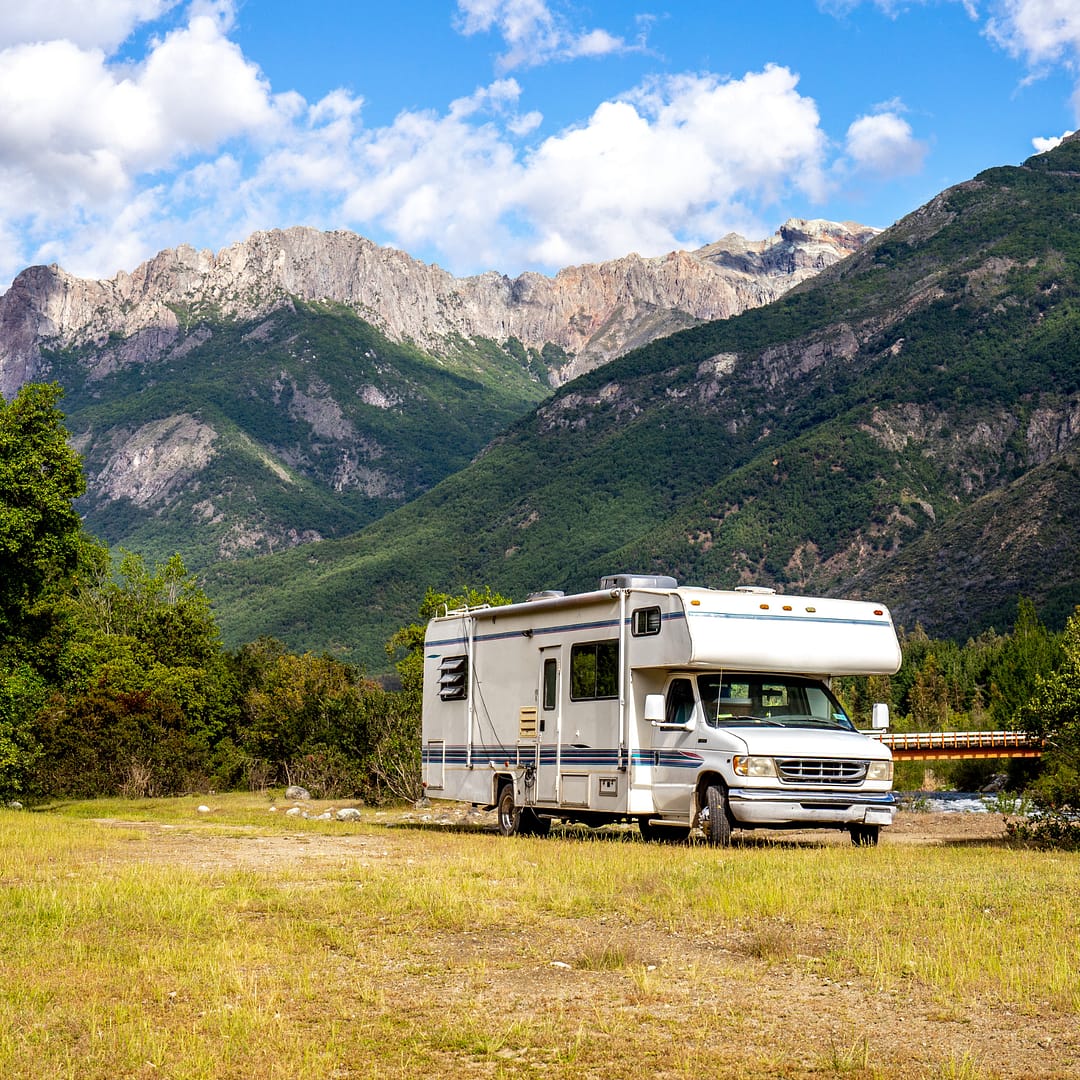
RV hookups are essential to enjoying the comforts of home while on the road. Whether you’re a seasoned RV enthusiast or a beginner, understanding how to connect your vehicle to external resources properly is vital. This comprehensive article will serve as a beginner’s checklist, providing valuable dos and don’ts for a successful RV hookup experience. From essential equipment to safety precautions, maintenance tips, and an exploration of different hookup types, this guide will equip you with the knowledge necessary to navigate the world of RV hookups confidently.
In this article:
Essential Equipment for RV Hookups
Power Cords and Adapters
Water Hoses and Regulators
Sewer Hose and Connections
Dos for Properly Connecting RV Hookups
Conducting a site inspection.
Before setting up, inspect the campsite for the location and condition of the hookups. Look for hazards such as low-hanging branches or uneven ground that could affect your RV’s clearance or stability.
Properly Plugging in the Power Cord
Ensure your RV is turned off before connecting the power cord. Plug the cord into the campground’s electrical pedestal, then connect the other end to your RV. Double-check that the connection is secure and that you use the correct amperage for your RV’s electrical system.
Connecting to Water Supply
Connect your drinking water-safe hose to the campground’s water supply, ensuring it’s tightly secured. Open the water valve gradually to avoid sudden water pressure surges that could damage your RV’s plumbing.
Hooking up the Sewer Hose
Attach the sewer hose to your RV’s waste outlet, ensuring a tight connection. Then, connect the other end to the campground’s sewer hookup. Make sure both ends are properly sealed to prevent any leaks or odors.
Don’ts and Common Mistakes to Avoid
Overloading electrical connections.
Don’t overload the electrical system of your RV or the campground ‘ s supply. Be mindful of the appliances you’re using simultaneously, and switch off unnecessary electrical items to avoid tripping circuits or causing damage.
Mixing Up Water Sources
Avoid connecting your drinking water hose to non-potable water sources like the sewer hookup. This can lead to contamination and health hazards. Always use separate hoses for different purposes and clearly label them.
Incorrectly Handling Sewage Disposal
Never dump your waste tanks anywhere other than the designated sewage hookup. Improper disposal can harm the environment and create unsanitary conditions. Follow the campground’s rules and regulations regarding waste disposal.
Ignoring Weight and Balance Guidelines
Don’t overlook weight and balance guidelines for your RV. Properly distribute weight inside and when towing to maintain stability on the road. Overloading your RV can lead to poor handling and potential accidents.
Safety Precautions for RV Hookups
Understanding electrical safety.
Regarding RV hookups, electrical safety should be at the top of your priority list. Before plugging in your RV, ensure you understand your vehicle’s power source and electrical requirements. Using the right adapters and surge protectors is crucial to prevent any damage to your RV’s electrical system. Remember, a burnt-out electrical system is not the souvenir you want to bring back from your camping trip.
Water Safety and Filtration
Water is an essential part of any RV adventure, but ensuring it’s safe for your use is important. Before connecting to a water source, consider investing in a water filtration system to remove impurities. This will give you peace of mind and keep your RV’s plumbing tip-top shape. Don’t forget to pack a water pressure regulator to prevent unexpected water pressure surprises. Nobody wants a shower that feels like standing under a waterfall!
Handling Sewage Properly
I’ll spare you the details, but let’s say that dealing with sewage isn’t the most glamorous part of RV life. However, it’s a necessary evil if you want to enjoy all the comforts of home on the road. The golden rule here is always to use designated RV dump stations or hookups to dispose of your waste properly. Nobody wants a neighborhood scandal involving your RV and a rogue sewage hose. Trust me on this one.
Maintenance and Troubleshooting Tips
Regular inspection and cleaning.
Like any other vehicle, your RV needs regular TLC to keep running smoothly. Take some time to inspect and clean your RV’s hookups regularly. Look for wear and tear, loose connections, or leaks. A little maintenance now can save you from major headaches down the road. Plus, it gives you an excuse to wear a cool-looking tool belt and pretend you’re a fancy RV inspector.
Troubleshooting Common Issues
Despite your best efforts, your RV hookups can sometimes go wrong. It’s like they have a mind of their own. But fear not; troubleshooting common issues doesn’t have to be a nightmare. Check your circuit breakers, fuses, and GFCI outlets if you’re experiencing electrical problems. For water issues, check for air bubbles in the water lines or clogs in the filters. And if you’re dealing with sewage woes, double-check your valves and connections. Just be prepared to get a little dirty, metaphorically and possibly literally.
Understanding Different Types of RV Hookups
Full hookups vs. partial hookups.
When it comes to RV hookups, not all campsites are created equal. Some offer full hookups, which include electricity, water, and sewage connections, while others only provide partial hookups. Understanding the difference between the two can save you from disappointment on arrival. Remember, nothing ruins a camping trip like dreaming of a long, hot shower and realizing you’ve got nothing but a bucket and a prayer.
Differences in Amp Service
Amps might sound like something out of a sci-fi movie, but they’re an important part of your RV hookup experience. Different campsites offer varying amp services, usually 30 amps or 50 amps. Make sure you know which one your RV requires and what the campground offers. Trust me, you don’t want to be left in the dark, quite literally, because your RV is thirsty for a higher amp service.
Dry Camping and Boondocking
If you’re feeling adventurous and want to venture off the beaten path, dry camping, and boondocking might be right up your alley. Dry camping refers to camping without hookups, while boondocking involves camping in remote or undeveloped areas. While these options offer freedom and solitude, they require careful planning and self-sufficiency. Just be prepared to embrace your inner survivalist and live off the grid for a while. Don’t worry; your favorite reality TV show won’t be filming your adventures (unless you count your own GoPro footage).
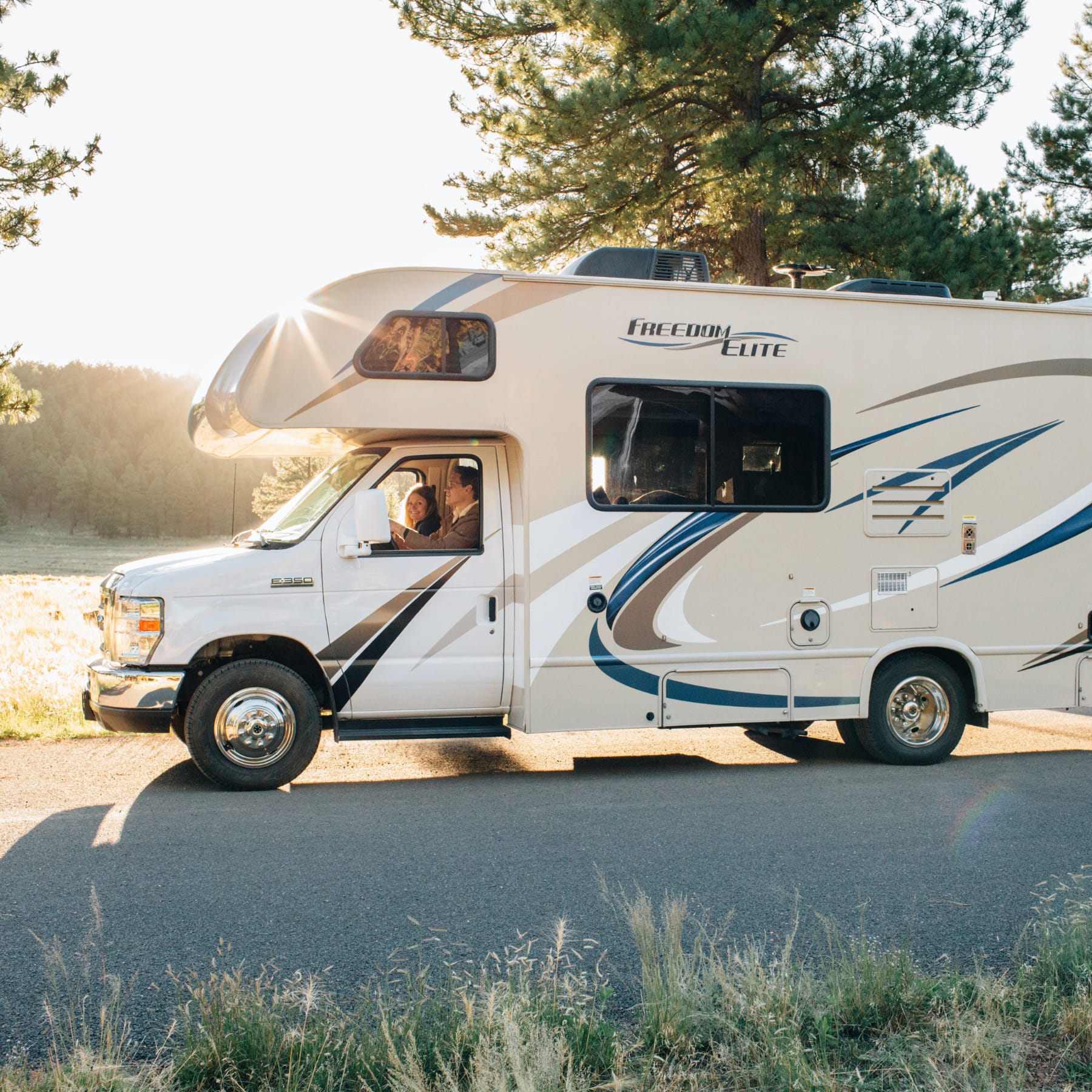
Final Tips for a Successful RV Hookup Experience
So, you’re almost ready to embark on your RV hookup adventure? Fantastic! Here are some final tips to ensure a successful experience:
- Always carry extra hoses, adapters, and extension cords. You never know when you’ll need that extra length or a different connection.
- Don’t be shy about asking your fellow campers for advice or help. RV enthusiasts are a friendly bunch and love to share their wisdom.
- Be mindful of campground rules and etiquette. Nobody wants to be the noisy neighbor or the person who leaves their empty potato chip bag floating around the campsite.
- Finally, embrace the unexpected and have a sense of humor. RV life is full of surprises and unplanned adventures. Embrace the quirks, the mishaps, and the unexpected detours. After all, that’s what makes the journey memorable.
About the author

BookOutdoors Staff
Camping options near me.
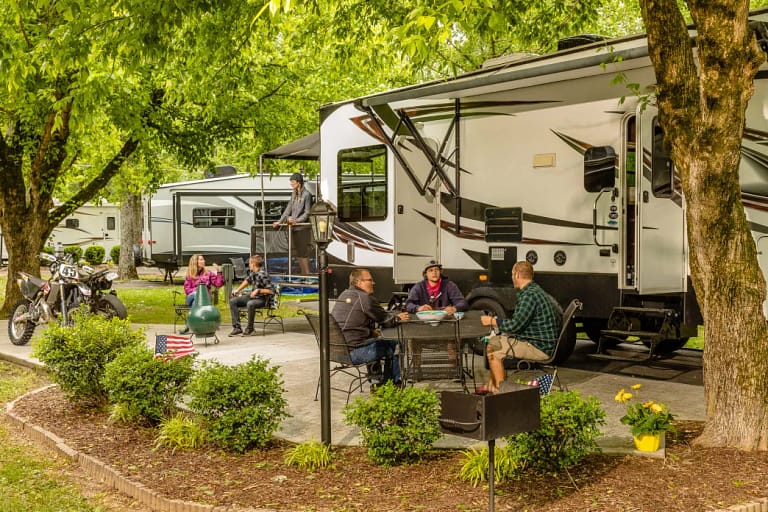
RV Parks Near Me
Discover and book the best RV campsites near you
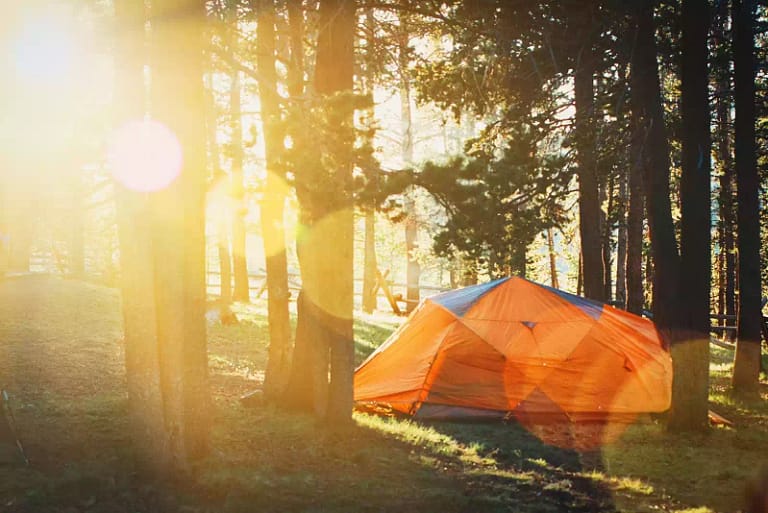
Tent Camping Near Me
Find the best campgrounds to pitch a tent
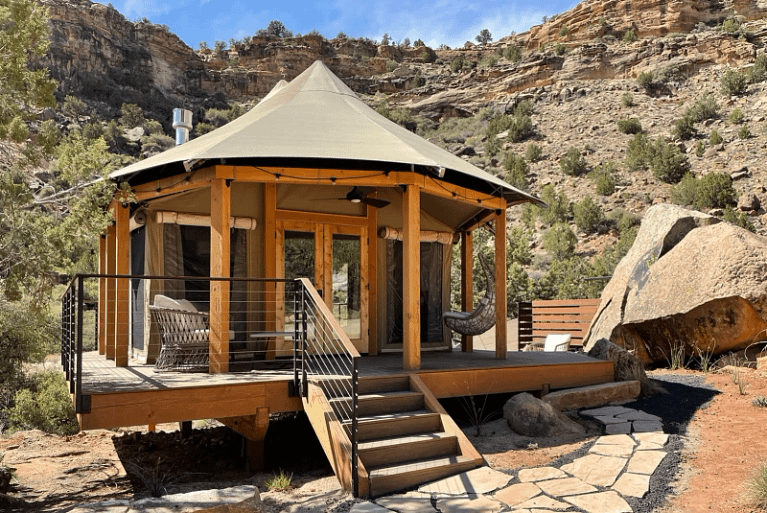
Glamping Resorts Near Me
Luxury camping options near you
Related Posts
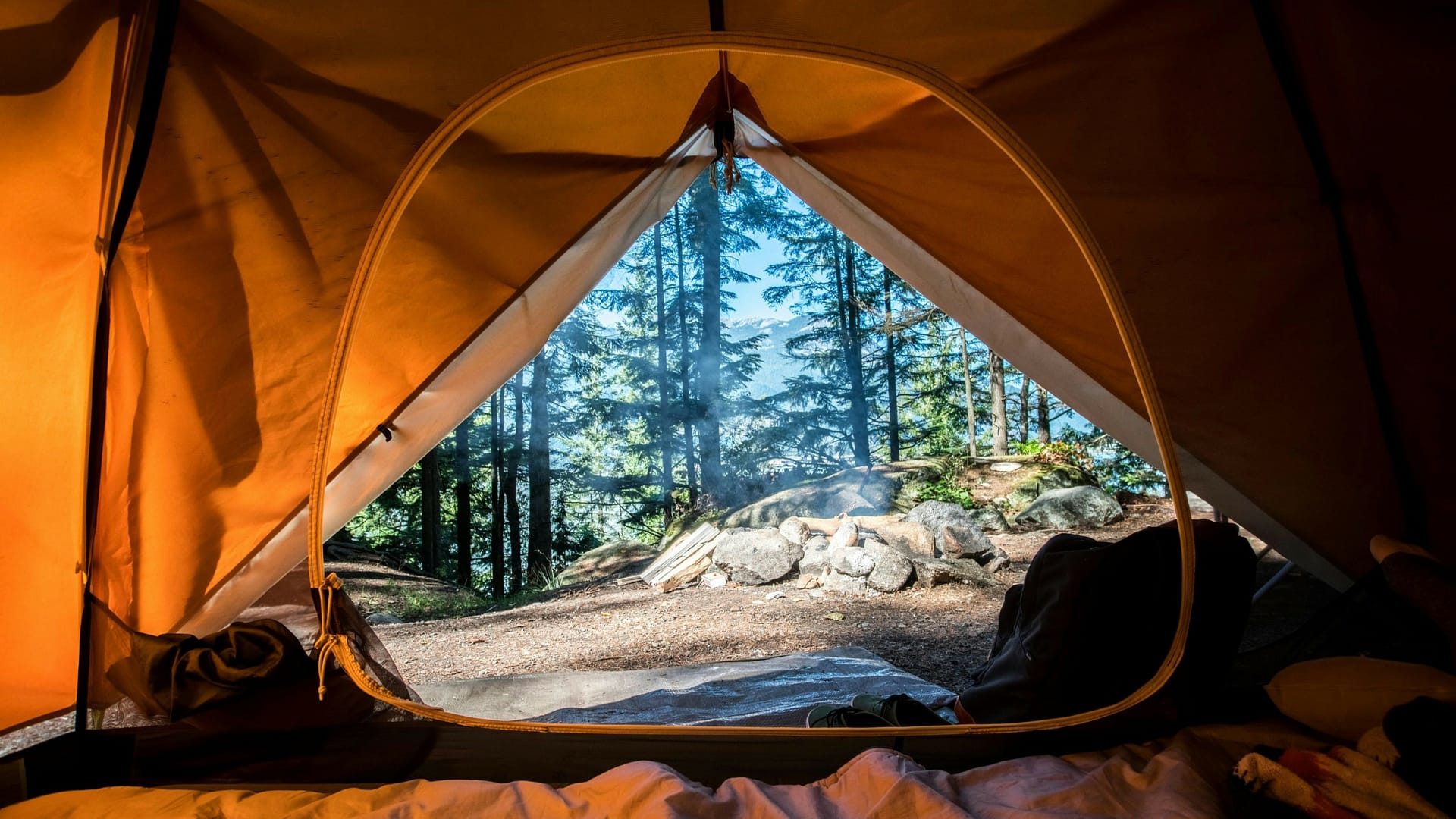
Camping Tips For First-Timers: An Easy Guide
So, you’re looking online for camping tips because you’ve never done it before. You’re educating yourself so you can enjoy
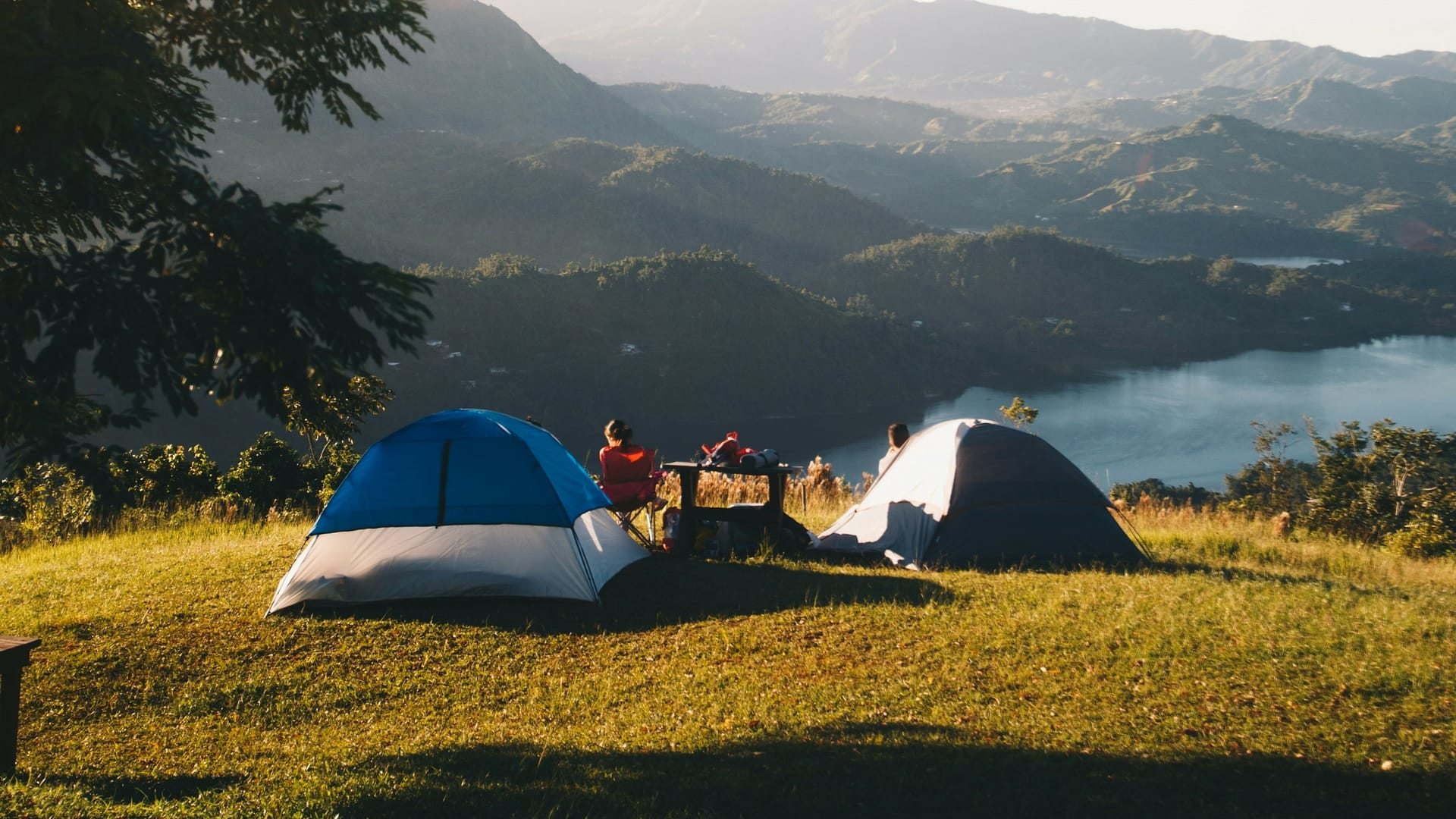
Camping Etiquette: The Unwritten Rules We Follow
Camping etiquette, let’s talk about it. Camping is a cherished activity across our planet, and for good reason. This particular
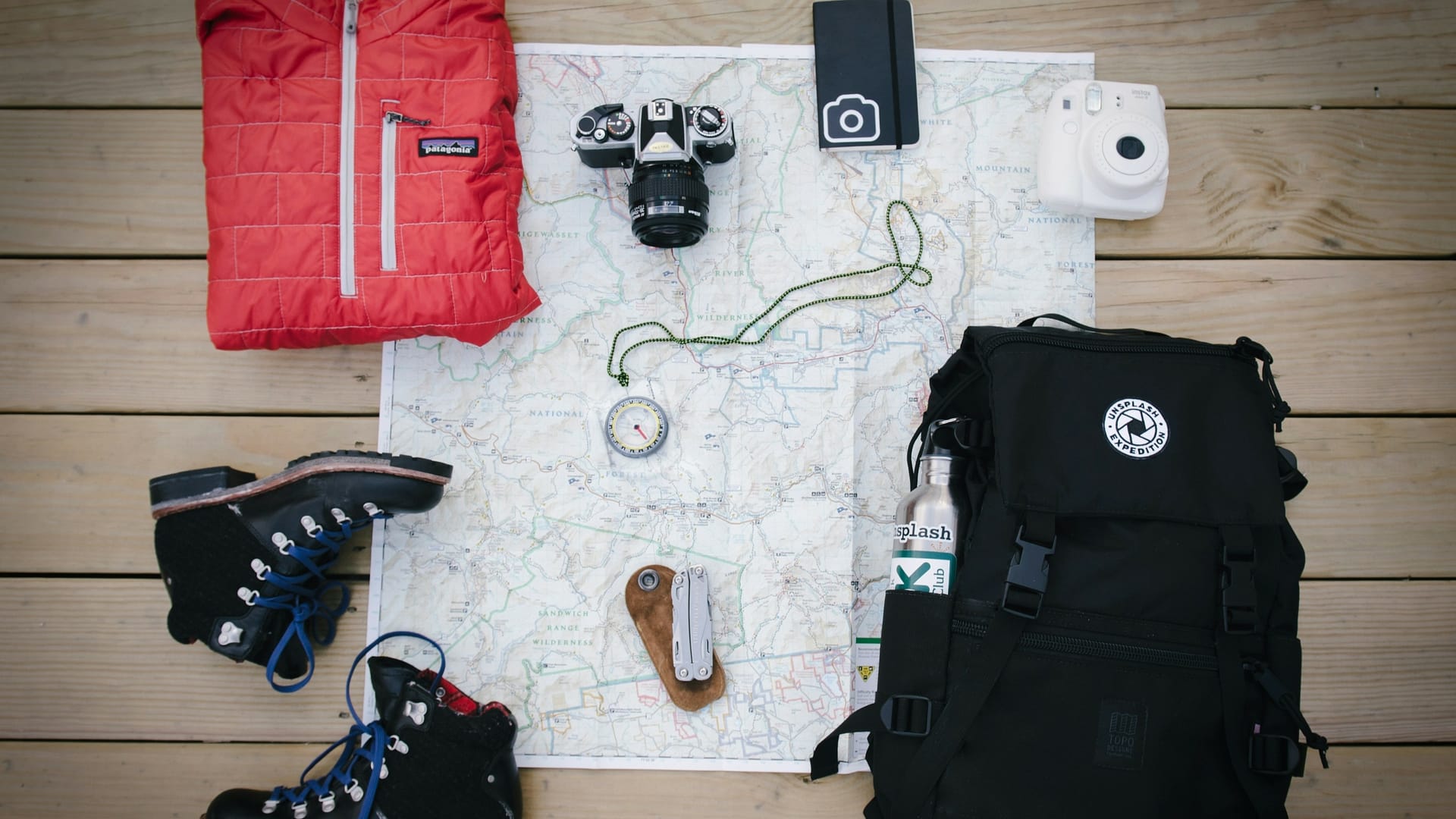
Camping In Zion National Park: A Fellow Traveler’s Guide
Interested in camping in Zion National Park? Good for you! While there are tons of great options to explore Utah’s
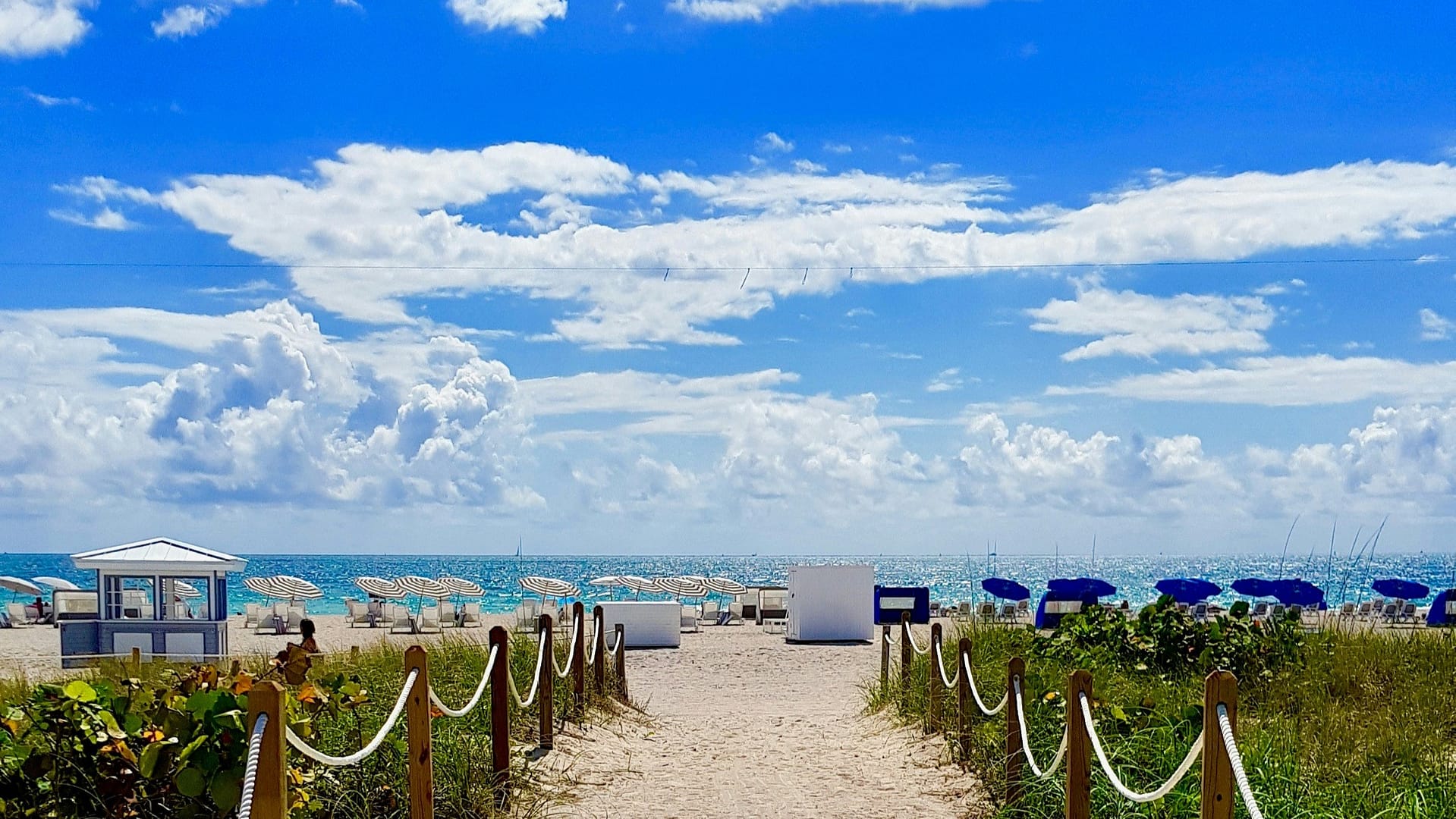
RV Sites In Florida: The Affordable Ones!
If you’re one of the many adventurers seeking affordable RV sites in Florida, you’re in luck. This guide from the
Join our newsletter to get the latest!
© 2023 Outdoor Ventures, Inc. All rights reserved.
- Skip to primary navigation
- Skip to main content
- Skip to primary sidebar

- Maintenance
- Campsite Reviews
Join Us On Social Media
Setup checklist.
Published: Sep 6, 2023 Note: This site is a participant in the Amazon Associates Program, an affiliate advertising program designed to provide a means for the site to earn fees by linking to Amazon and affiliated sites.
Sharing is caring!
There's a lot going on with RV setup. Use a printable RV & Travel Trailer setup checklist to help you setup in a fast, efficient manner.

In this article you'll find the details for customizing your own printable RV & Travel trailer setup checklist for setting up when you arrive at a campground. Check out our other articles for an RV Departure Checklist , great for packing out for a trip or leaving your campground.
A list is a great tool to use whether you're an RV newbie, RV full-time, or anywhere in between.
It might be tempting to assume it's the same checklist backwards, but it's not! When you're setting up at a campground you don't have to worry about how things are stowed, for example.
Can I Just Have the RV & Travel Trailer Setup Checklist Already?
I'd love to give you the list right here, right now and say you're good to go. I'm all for efficiency.
Unfortunately, I think you'd be disappointed. I'd have to do one of two things: I could create a generic list of items that aren't very specific and are only marginally helpful.
Otherwise I could list every possible option on there. It would be an overwhelming page of items that don't apply to your situation.
Customize your own checklist - I'll help you!
You should build you own printable RV & Travel Trailer setup checklist for camp site setup, or at least modify mine, to suit your own specific needs. I'll walk you through setup as a aid. It's easy to forget things!
One of the key points that I want to make is that order matters. It's important that your list is in the order that you generally set up.
Without being in order, it'll be chaos. You'll need to go looking to check off items you just did. You might miss things.
Order also makes things efficient. Perform tasks while you're in the same zone and you'll speed things up.
I'm going to walk through the order as I do them. See if they make sense to you. Feel free to copy, feel free to change.
Logical sections make for rapid scanning!
The next key point is to indent logical sections. It makes it much easier to view it as a series of small projects, versus a pile of little tasks.
This also makes it easier for you to have logical modules. As an example, you might have a water pressure regulator and a water filter already hooked up.
The simple act of hooking up the hose to your water input checks off water pressure regulator, water filter, and hose hookup.

It's still a good idea to list each of these out. In the spring you can scan your list and remember to order new water filters!
I'm going to walk through the different areas, which will benefit new RVers as well as those that are used to the RV lifestyle or even a full-time RVer.
Everything here applies to an RV checklist of any type. 5th wheel travel trailer, bumper pull pop-up, or perhaps a Class C RV Motorhome like ours.
Ok, where should we start the setup checklist?
Camping doesn't begin when you park in your spot. First you have to get there!
RV Arrival - As you enter the campground
First things first, check in! Have your license plate(s) memorized or written down. I have my plate numbers on a label on the back side of my phone, inside the case.
Don't forget to get a map, signage at some camp sites are not adequate.
Next up is water and dump. Do you need to fill your onboard water tank in your travel trailer? Do you need to go to the dump station before you head to your site?
As we pull up close to our RV campsite, we unhook the car we tow. We can't back into the site with the car hooked up. Pull-through sites might have enough room but making tight corners is difficult.

Since the car is a manual transmission, I apply the emergency brakes first. While I'm in the car I remove the breakaway braking system and bring it to the trunk.
Since I'm at the trunk I put the tow lights away. Next I walk to the front of the car.
I unhook the safety chains from the car and the tow vehicle, breakaway cable from its switch, and wiring harness. Next I remove the tow bar and store it in the back seat of the car – it's just a bit too big to fit in the trunk.
At this point, take a quick look at your customized RV & Travel Trailer checklist to make sure all steps are done. Do this at the end of each section. This prevents you from having to go back or missing something entirely.
RV Setup - Utilities
The first thing I do when I park at an RV campsite is hookup the utilities. When it's hot I want that A/C churning away right away so I begin with electricity.

It might not be “roughing it”, but there's definitely a reason we went with a motor home as opposed to a pop-up trailer or tents.
I've Got the Power!
RV surge protectors are a great investment, now is the time to plug that in if you have a separate unit. Our unit is a hard-wired electrical management system (EMS) at the electrical panel, so we can just plug in our power directly.
Water hookups at camp sites are great!
Next I hook up the water line , if our site has it available. Many of the provincial parks we visit do not have full hookups.
We don't use a water pressure regulator , but this would be the time to install it. So far we haven't had issues with too much water pressure.
Sewer lines if available
If the site has sewer connections, now is when I'll put on disposable gloves and hook up the sewer hose . A sewer hose support is popular to provide good flow.
It seems to be common for all campers that I've seen to setup the sewer hook-ups right away. You don't really need to though, you shouldn't leave the valves continuously open. You want your tank like a toilet – strong flush action to get rid of everything.
If you left the valves open, solids will build up and you don't want that. This would occur quickly in the black tank, but could also occur in the gray tank.
Gray water can have small amounts of solids from dish cleaning and such. Side note, drain the black water first, then the gray tank water will flush the hose.
Level and Stabilize your Travel Trailer
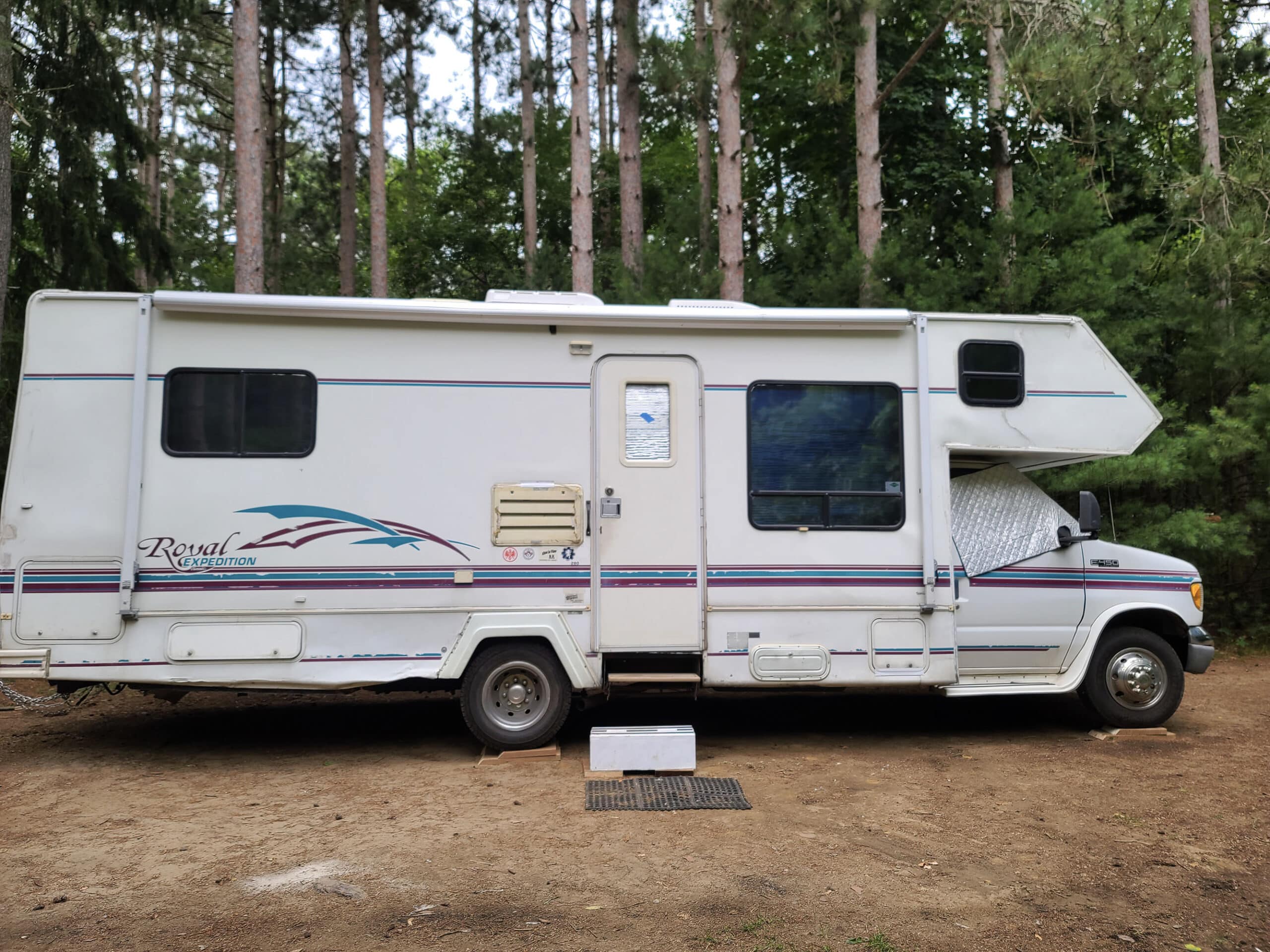
I think that levelling and stabilizing is one of the most important things for setup. It really makes a big difference.
I use a small bubble level on the floor just inside of my side door. If it's only off a little bit, I'll use the stabilizer jacks to level it out.
Major tilt requires more than just a tweak
If it's off a significant amount, I'll use the 2x10 boards to level them out. I've cut them at an angle to make it easier to drive up them.
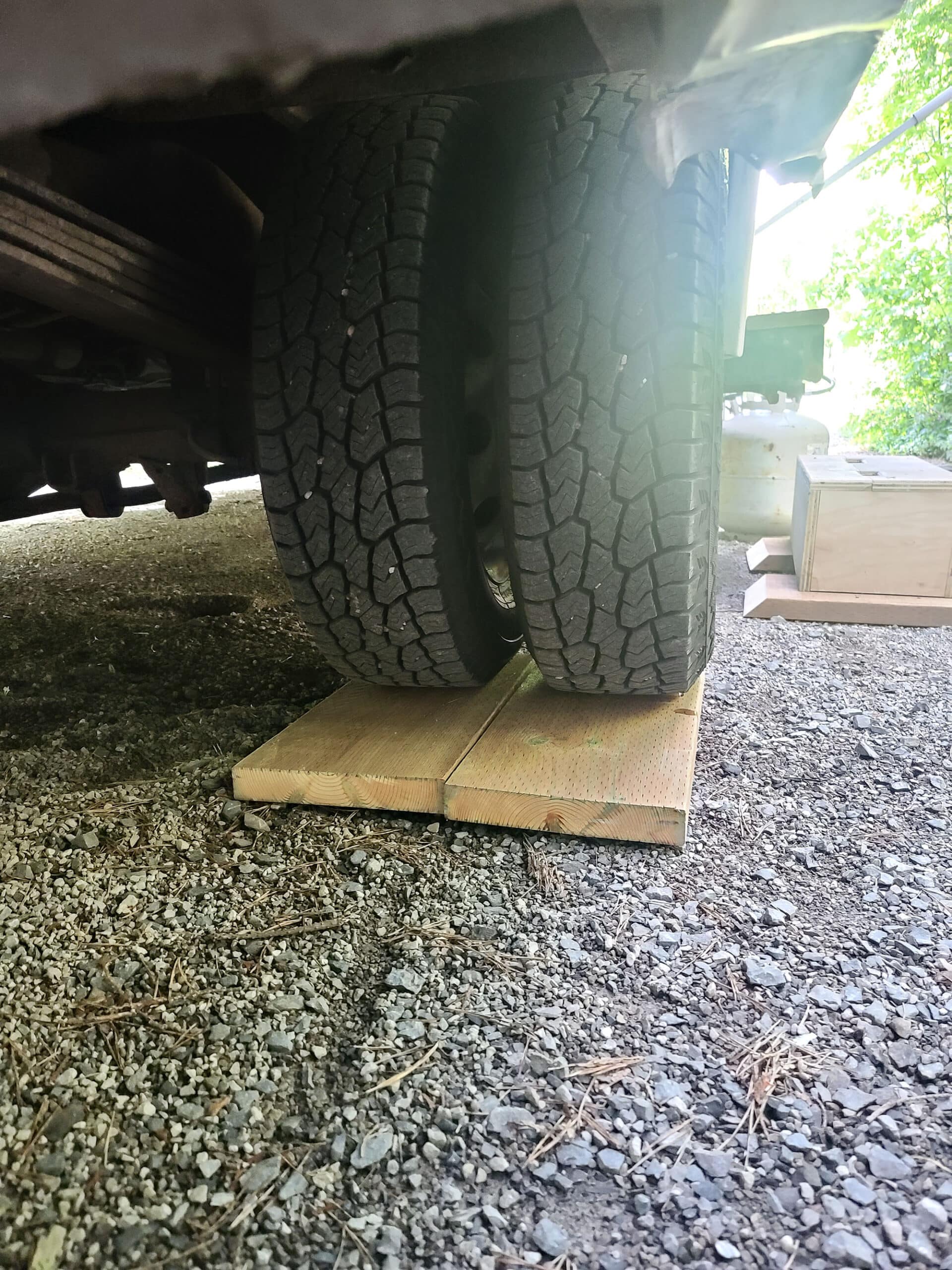
Stabilizer jacks can level things out
Don't lift the motorhome with the jacks, just push up to level and make sure the RV doesn't move around nearly as much.
If your RV doesn't have built-in jacks, or marked locations for jacks, find good spots on the frame to support the RV. Serious damage could occur if you stabilize from somewhere other than the frame.
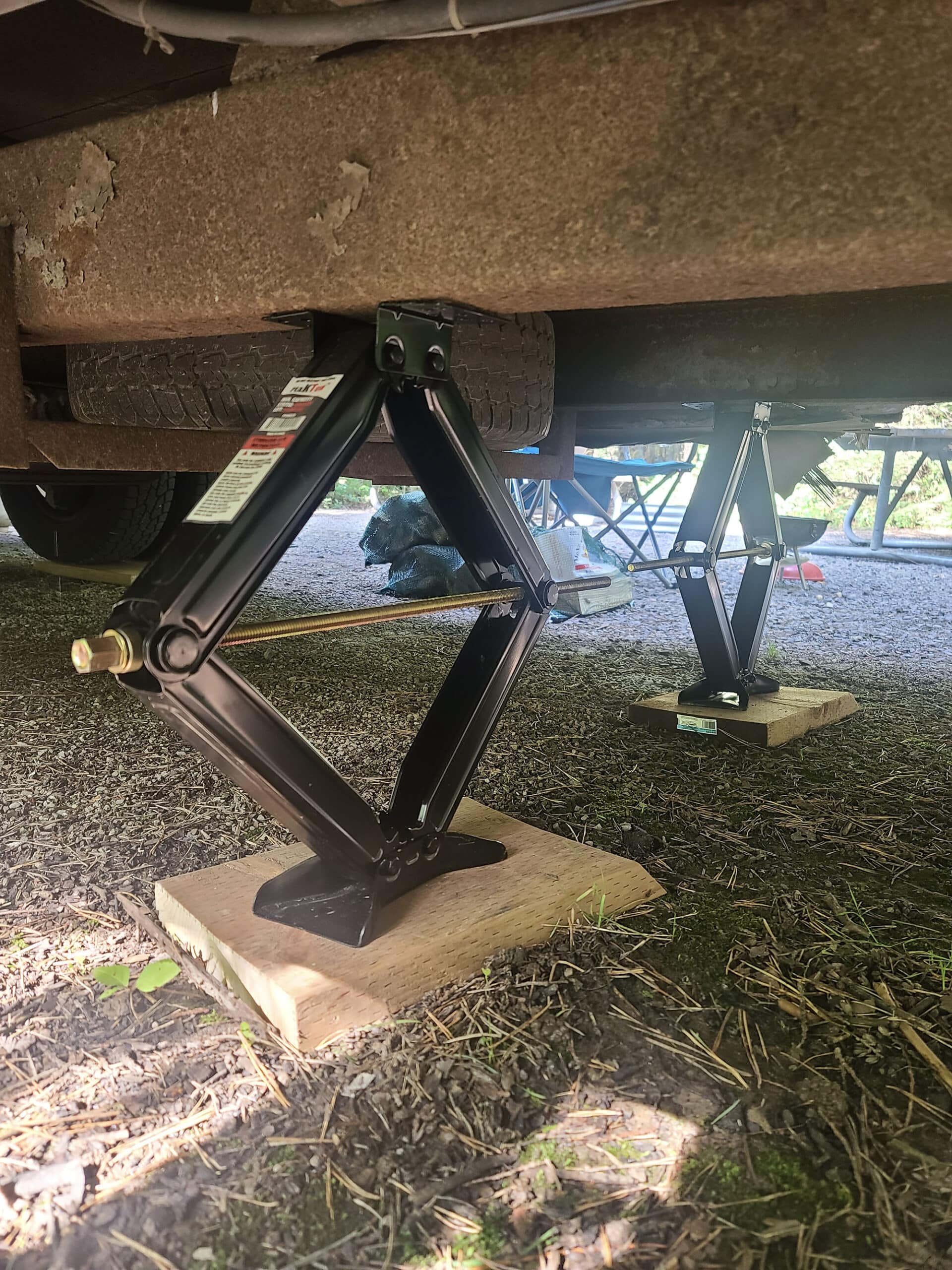
If you have a trailer, make sure your tongue jack or fifth wheel jack stabilizer is in place.
RV Setup Checklist – The Rest
Finally here's a list of the final steps that are needed or wanted to really make things good to go. I'll go through this one quickly.
I set up a barbecue propane tank and lock it at my onboard propane tank connection. This allows me to easily swap out tanks and I rarely have to fill the onboard tank. A propane tee adapter kit was installed to make this an option for me.
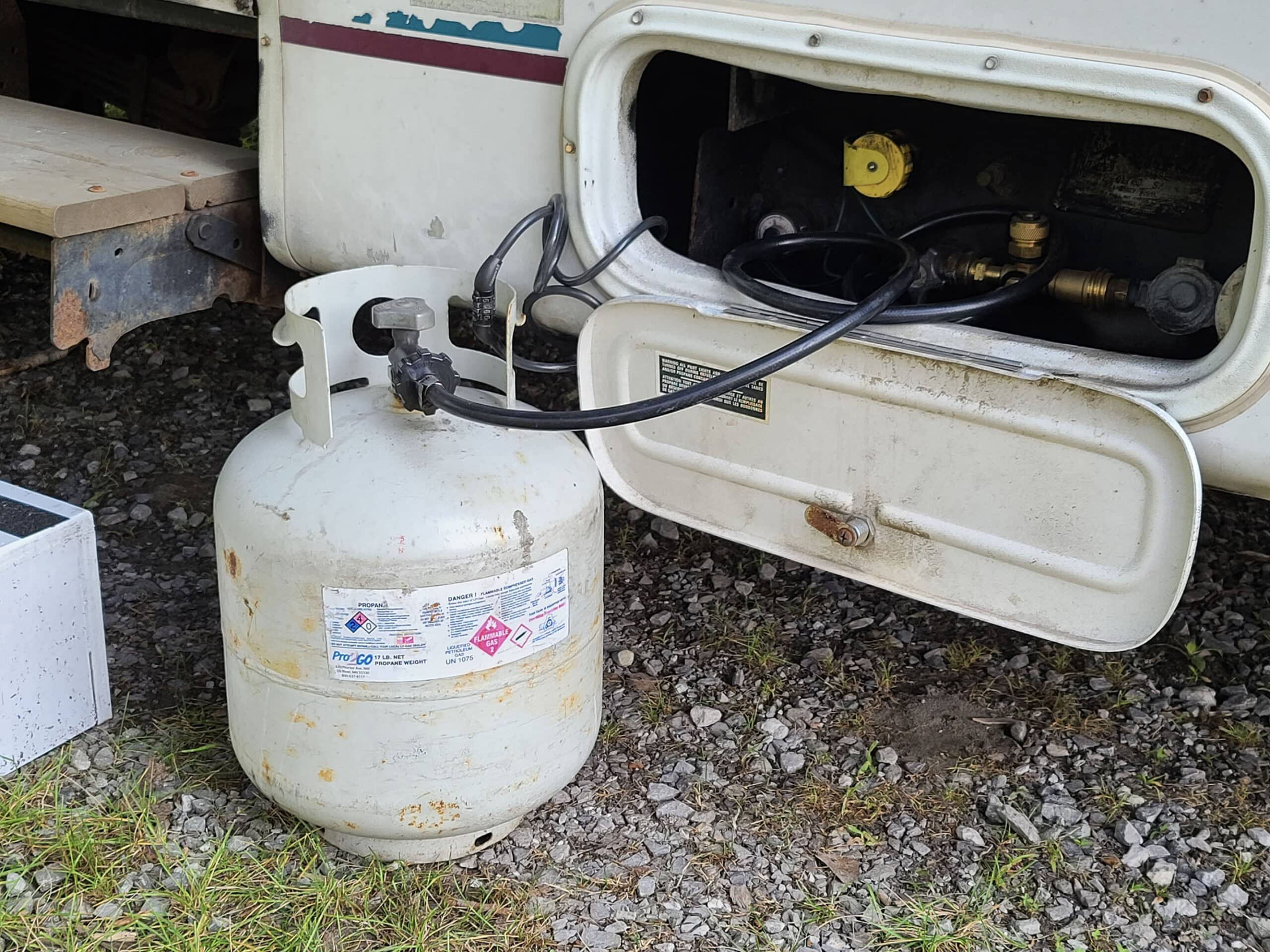
I have manual pull-out steps, and one is missing. I swing out the first level and I place the homemade step below that. Commercial options are also available for RV steps .
Next I put out the rubber mat – this really helps reduce dirt from coming in. I see a of lot folks use a large outdoor rug for their patio area. We don't have one yet, but are considering it. Pull out the awning if the weather isn't too severe. If it's really windy I don't risk it, I just leave it closed.
Do a quick run through the inside to make sure everything is on an operating correctly
Inside the RV, turn on the water heater and light any pilot lights needed. If you're on shore power, make sure your battery switch is ON. My motorhome only charges the onboard batteries when the switch is on.
I like to double check that the fridge is still on, and I turn on the RV fridge fan. Check out our RV fridge fan article to see buying one is worth it for you.
Open any windows you'd like open. It's a good idea to leave the bathroom window open if the temperatures allow it, since there isn't much circulation in there.
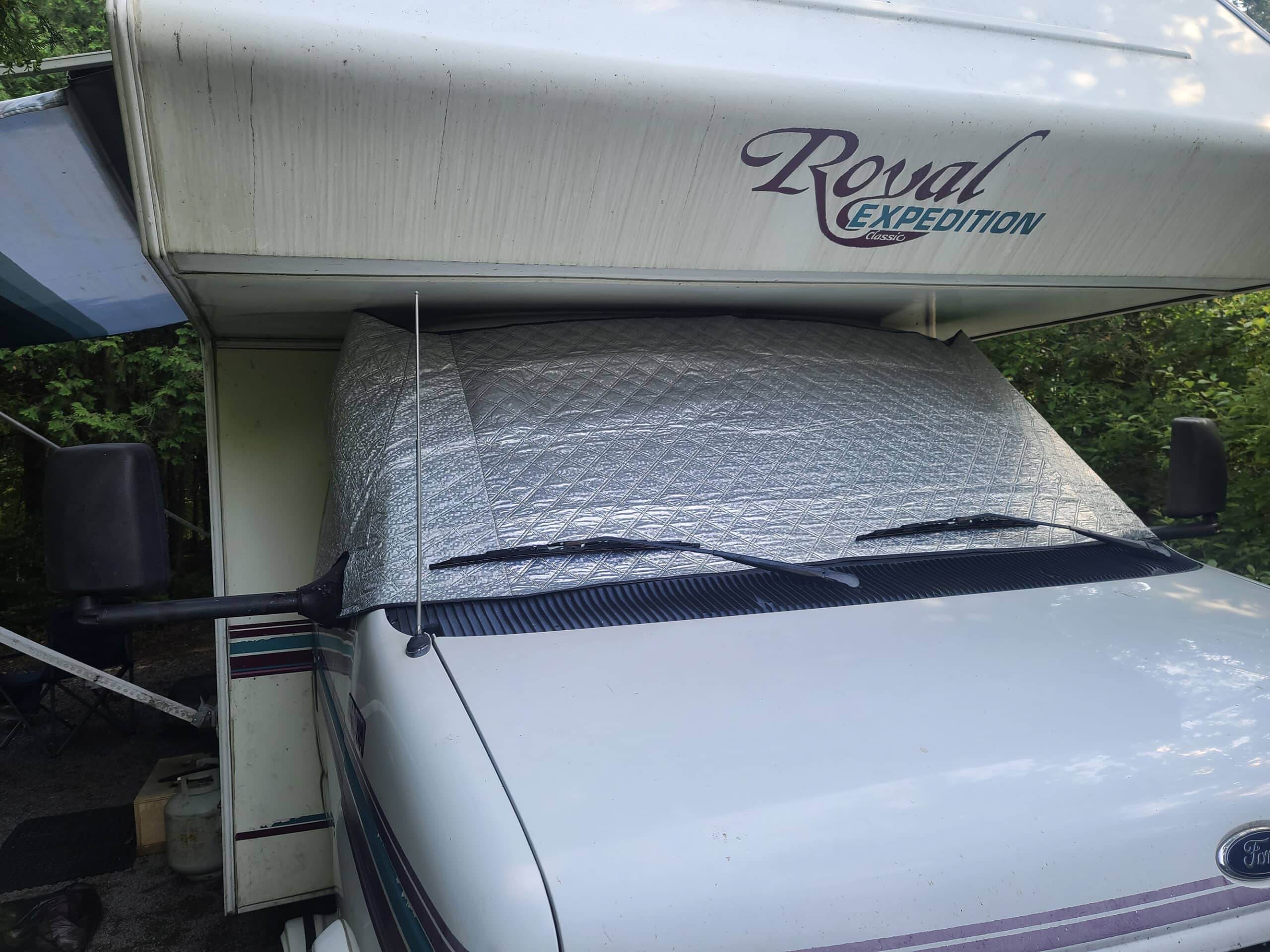
Final Verification!
Now scan over your entire RV & Travel Trailer setup checklist to make sure all steps are complete. All done? Looks like you're ready to start the fun!

Share the Love!
If you’ve cooked one of our recipes or used one of our tutorials, be sure to take some pics of your handiwork! If you post it, be sure to tag us - @2NerdsInATruck on Instagram, and on TikTok , or post it our Facebook Page - so we can cheer you on!
Also, be sure to subscribe to our free email newsletter, so you never miss out on any of our nonsense. Well, the published nonsense, anyway!
Finally, if you love this post, please consider leaving a star rating and a comment, and/or sharing the link on social media!

Reader Interactions
Leave a reply cancel reply.
Your email address will not be published. Required fields are marked *
Save my name, email, and website in this browser for the next time I comment.
This site uses Akismet to reduce spam. Learn how your comment data is processed .
Halloween at the Campsite! Add Some Spook to Your Site!
A quick guide how to empty rv waste holding tanks, luxury gifts & gear for campers, glampers & travel enthusiasts.
- Children & Family
- Cookout Gear & Accessories
- Maintenance & Repair
- Products & Accessories
- RV & Campsite Setup
- Storage & Organization

RV Arrival and Setup Checklist
This post contains affiliate links, meaning I get a commission if you decide to make a purchase through my links, at no extra cost to you. Please read my disclosure and privacy & terms for more info.
ew to RVing or not, checklists help start vacation in the right direction.
Follow our RV arrival and setup steps for a smooth entrance and safe setup process at the campsite!
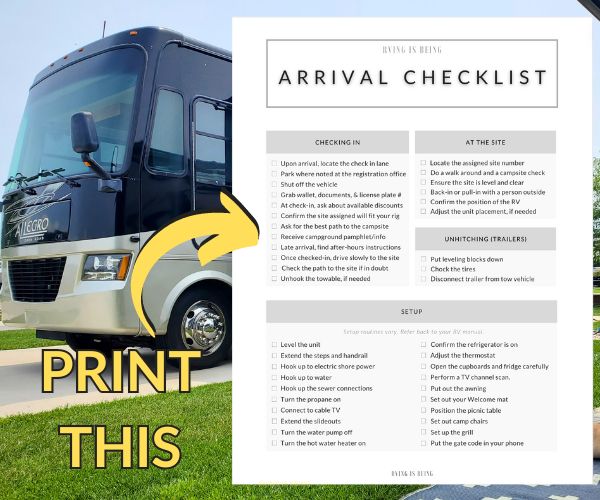
Checking In
1. Before arriving, first confirm that the GPS directions are correct and big rig accessible, if need be. Take a look at the route and view the campground entrance on the Google Maps app so that you know exactly what to watch for.
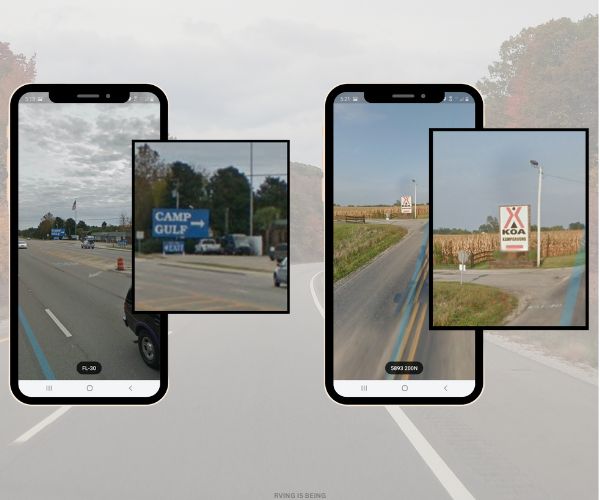
2. Arrive at the campground.
3. Slowly maneuver into the Check-In lane while not blocking other lanes. Stop where noted at the registration area.
4. Throw ‘er in park and shut off the vehicle . DO NOT leave your motorhome running during the short check-in process. It can roll if the brake is not pulled or if a pet jumps on the driver’s seat and bumps it (like below). Park and shut it off!
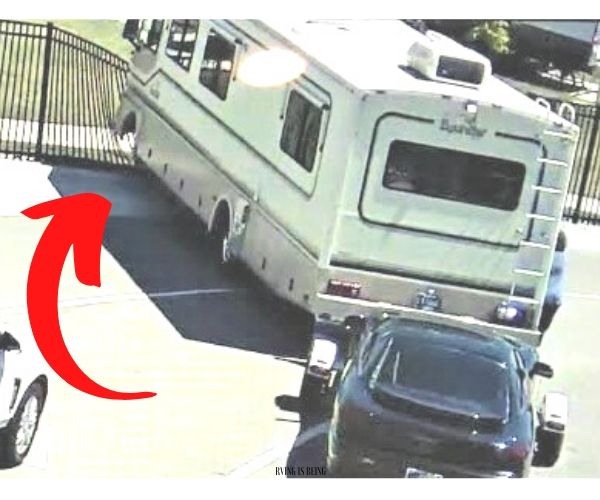
5 . Grab your wallet, confirmation documents, dog records, and snap a picture of the license plate on the way into the office.
6. At check-in, ask about available discounts such as Military, Good Sam, First Responder or any other camping club discount.
7. Verify that the site assigned will fit your rig and requirements (correct amperage, water, sewer, etc.)
8. If you have a large RV, ask if the route to the campsite is big rig accessible or what’s the best way to get there. If you’re unfamiliar with the campground or are arriving late at night, it’s not a bad idea to scout out the path and site you are assigned. Remember, it’s so much harder to turn around or back up if you get stuck down too sharp or narrow of a path! If in doubt, scout it out!
9. Ask if the campground has an area to unhook your tow vehicle.
10. If the campground does not offer full hookup, determine where the dump station and fresh water fill is to visit on your way to the site.
11. Receive your check-in pamphlet with directions to the site, campground information, gate codes, rules and regulations, and Wi-Fi password.
12. If arriving after the office is closed, look for after-hours check-in instructions.
13. Slowly drive to your designated campsite as noted on the park map.
14. If you have a toad (tow vehicle) unhook it at the designated unhook/hookup area.
At the Site
15. Locate your assigned site number.
16. Before driving into the site, take a quick look to ensure the site is level and that trees, limbs, picnic tables, fences, etc. are far enough away from the roof, exterior, and slideouts. Also, doing a campsite check is best to do now , to make certain the site accommodates your RV and works for you and your family– rather than get parked, set up, and THEN have to switch sites. Look for anything that could be a potential issue during your stay. Are there overhanging limbs that could damage your roof? Is it built for rain runoff so after a hard rain your rig won’t get stuck ? Is it too unlevel? Etc.
17. Back-in or pull-in accordingly. It always helps with an extra pair of eyes outside the RV.
18. Once parked onsite, do a walk around to confirm the position of the RV is in reach of the hookups (water, sewer, and shore power) and that the unit is clear of limbs and obstructions even after the slides, satellite and awning are extended. Be sure to put it in park or pull the air brake before jumping out to check. Better yet, turn the motorhome off. (Can’t stress this part enough for motorhomes! We’ve seen multiple incidents where drivers’ failed to pull the air brake, and their motorhome started rolling off!)
19. Adjust the trailer or motorhome placement if needed.
Unhitching (trailers)
20. Put leveling blocks down and chock the tires.
21. Disconnect the trailer from the tow vehicle.
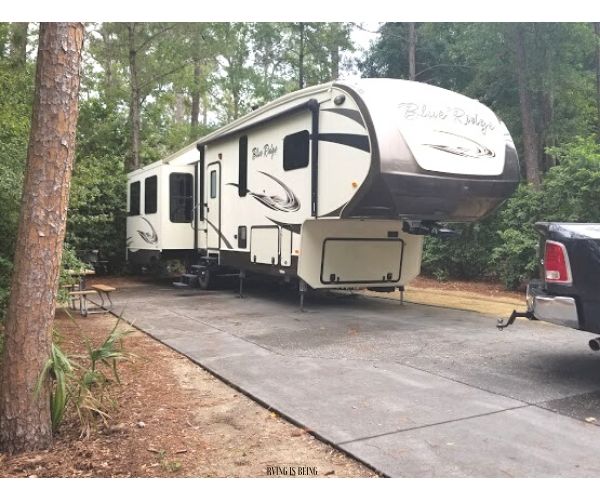
Setup procedures will be different as dependent on your make and model. For example, our motorhome manufacturer states to deploy the slideouts first, then level, so that it doesn’t twist the full wall slide. However, others level first and then put the slides out. Likewise, trailer unhitching and leveling procedures vary between units. At the same time, some RV owners prefer to hookup to electric, sewer, and water first, before they put their slides out– not only increasing voltage for better slideout operation but also preventing them from ducking under and nailing their head on the slide! OUCH! Either way, carry out a routine you find suitable as well as refer back to your RV manual for correct setup steps.
22. Level the unit manually or with an automatic leveling system.
23. Extend the steps and handrail.
24. Connect to electric shore power. First, make sure that the breaker is off. Connect electric to the camper then plug into the shore power receptacle. Remember a surge protector ! Then, flip the breaker back on.
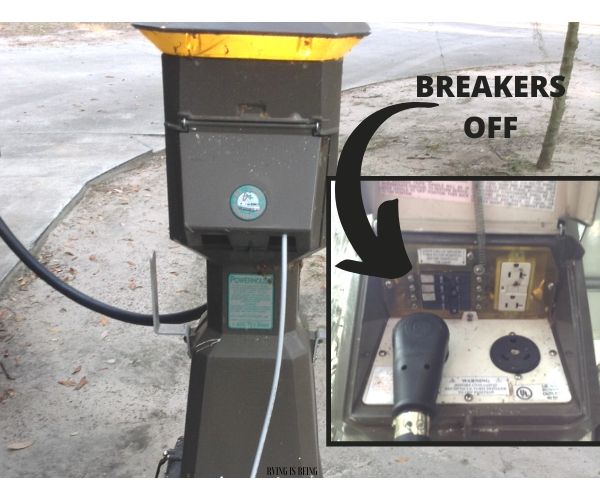
25. Connect to water with your fresh water drinking hose . Don’t forget a water pressure regulator !
26. Connect the sewer hose between the RV and the campground sewer inlet.
27. Turn the propane on.
28. Connect to cable TV (if available).
29. Extend the slideouts.
30. Turn the water pump off.
31. Turn the hot water heater on.
32. Confirm the refrigerator is on (and running on electric).
33. Adjust the thermostat.
34. Open the cupboards and fridge carefully for fallen objects during travel.
35. Turn on and raise the TV antenna or satellite dish if you have one. Run your channel program.
36. Put out the awning.
Personalize Your Site!
- Plop down your welcome mat .
- Position the picnic table to your liking.
- Get out the camp chairs.
- Set up the grill.
- Remove your bikes from the rack. (Be sure to lock them up when you’re not at the campsite!)
Tip : Before you head out and have some fun, grab the campground pamphlet and snap a picture of the map, phone number, address, and gate code. Although the pamphlets are very helpful, they often get left behind in the camper when out and about. Odds are your phone will always be with you so you’ll have the info when needed!
Help prevent costly mistakes with RVminders ! Slap against the steering wheel to remind you of important step-by-step arrival or departure tasks.
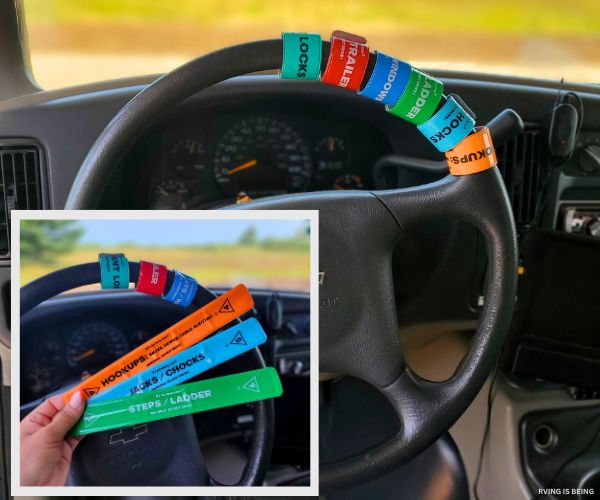
Be sure to check out the RV Tear Down and Departure Checklist !
RVING IS BEING setup and ready for some fun!
RV Tear Down and Departure Checklist
Let’s Talk about Seasonal Camping!
Related posts, the rundown on renting an rv with rvshare, liven up your rv living room with these decorative (plus useful) accessories, renting rvs vs. buying rvs | let’s look at the pros & cons, kids woodland wilderness rv bunks, rv camping | last minute memorial day must haves, leave a reply cancel reply.
RVING IS BEING would love to hear from you!
Save my name, email, and website in this browser for the next time I comment.
This site uses Akismet to reduce spam. Learn how your comment data is processed .
Today's pick
10 apps worth installing for your rv adventures, motorhome stuck in the mud, rv road trip keep these items a reach away, the best baby gear for your rv, ultimate rving mistakes, 25 questions for the rv campground reservation desk.
Disclosure: This website contains affiliate links, meaning we will get a commission if you decide to make a purchase through the links, at no additional cost to you. Additionally, this website is an Amazon Associate. As an Amazon Associate, the owner of this website earns a commission as a result of certain qualifying purchases. CERTAIN CONTENT THAT APPEARS ON THE SITE TO WHICH THIS SITE LINKS ARE AFFILIATE LINKS. THIS LINKED CONTENT IS PROVIDED “AS IS” AND IS SUBJECT TO CHANGE OR REMOVAL ANY TIME. Please read this Site’s disclosure and privacy policy & terms for more information.
- Children & Family (15)
- Cookout Gear & Accessories (6)
- Holidays (10)
- Maintenance & Repair (10)
- Printables (4)
- Products & Accessories (39)
- RV & Campsite Setup (23)
- Shop Page (36)
- Storage & Organization (2)
- Travel (24)

Follow us on Pinterest
Username or Email Address
Remember Me
Registration is closed.

Travel Trailer Setup Checklist: Setting Up an RV Campsite for Beginners
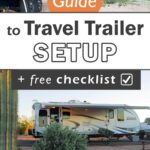
As an Amazon Associate, we earn from qualifying purchases. We also earn from other affiliate websites. See our full disclaimer .
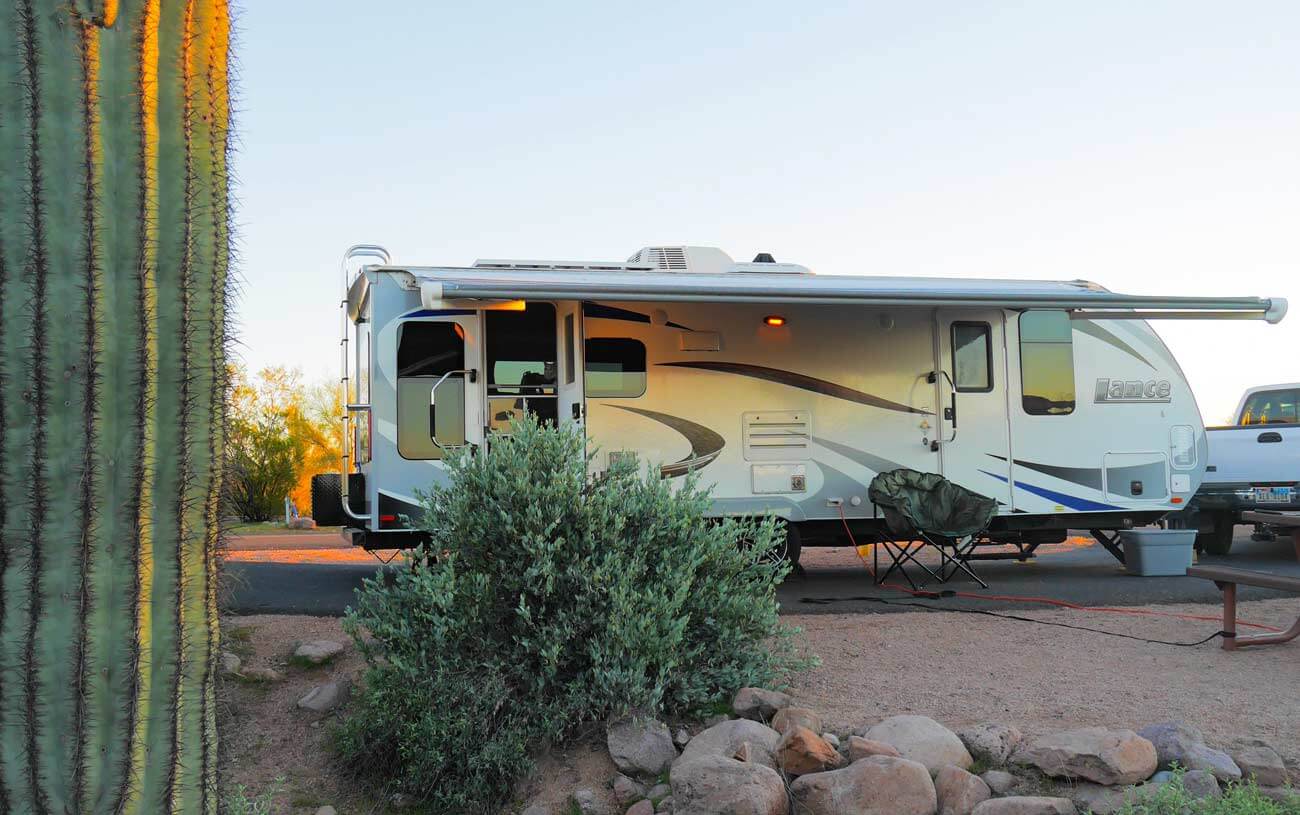
When setting up your RV travel trailer as a beginner, it’s essential to take your time and do it correctly. You don’t want to rush through the setup procedure and wind up with an RV that isn’t set up safely or prepared for an enjoyable camping experience.
We’ll cover everything you need to know – from unhitching the trailer to RV hookups, and give some helpful tips that took us a while to learn!
Below we’ll take you through a step-by-step travel trailer setup, so you are fully prepared to take your RV to a campsite. You can also download our travel trailer setup checklist below.
Arriving at Your Campsite
The first thing you want to do before pulling into a site is to inspect it. If you can choose your spot, drive around until you find one that suits you and ask yourself these three questions.
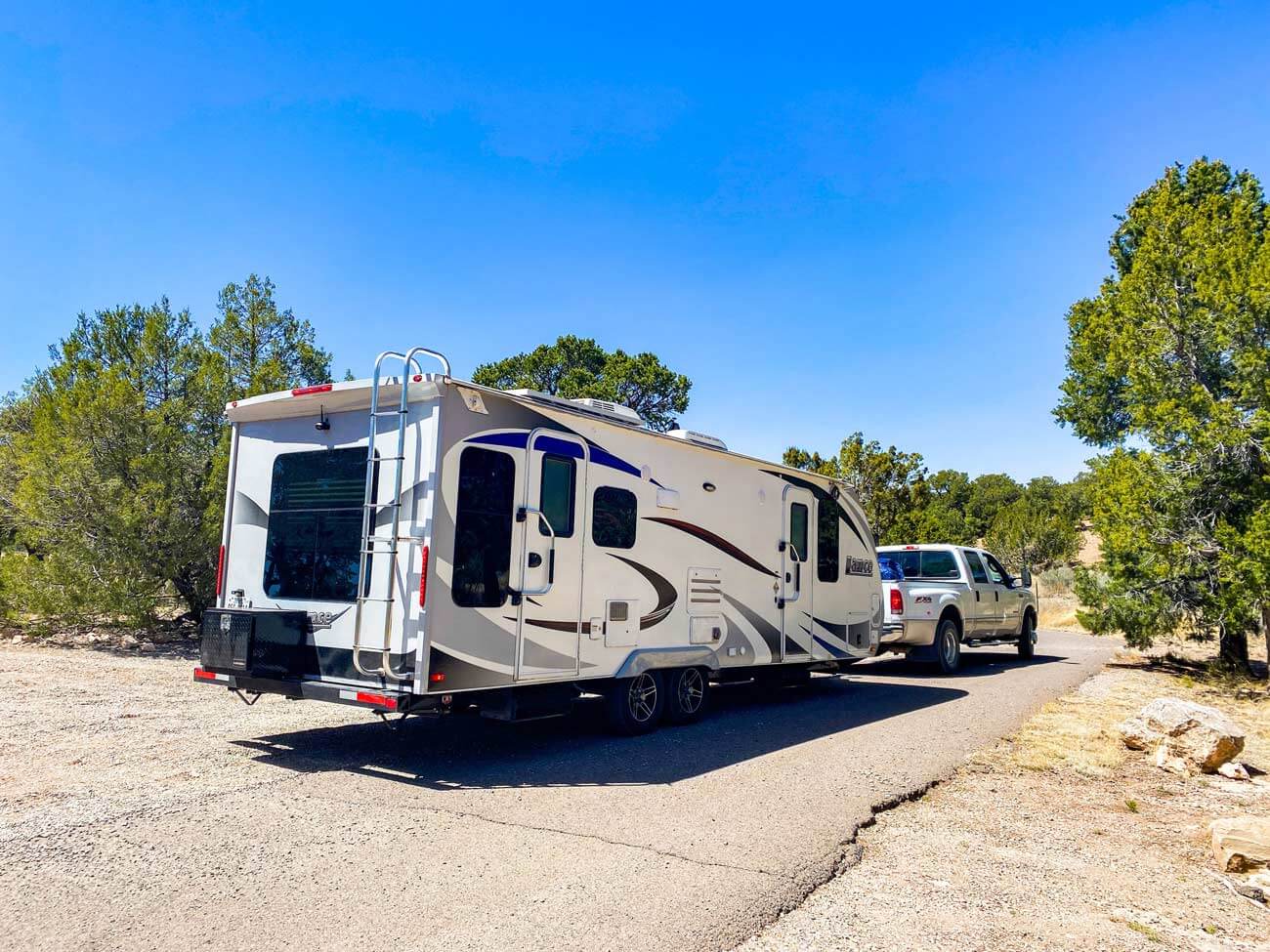
- Is it level?
- Does it have any obstructions for backing in, putting out the awning or slide outs, or using the solar panels?
- Where are the hookups?
You can usually inspect the site from the driver’s seat on a flat, pull-through, concrete pad campsite. However, getting out and surveying the area on foot is best for anything more complicated. We still follow this process at almost every site. It doesn’t pay to be in a rush.
Let’s break down what to look for when answering the above questions.
Is the Campsite Level?
Picture where your RV camper will be in your mind. Take note of sloping and where you might need leveling blocks. Look for bumps and dips to avoid. If a campsite is too crooked, it may be best to drive on or ask the campground if you can be reassigned to a different spot.
Obstructions
Trees, large rocks, camping tables, hookup pedestals, or any other obstructions make it hard to get into a site and can damage slide-outs and awnings. Trees cast shade that can help keep an RV cool but also significantly reduce the output of solar panels and dirty the RV’s roof.
Hookup Locations
Ideally, a campsite will have water, electrical, and sewer hookups on the driver’s side of the RV centrally located where you will park. The passenger’s side is left with room to set up camping gear.
In reality, there isn’t consistency with hookup layouts between campgrounds or even campsites within some campgrounds. Sometimes the hookups can be spread out so far that extra hoses or electrical extensions are needed. We have experienced campgrounds with water and electricity on the driver’s side and the sewer right in the living space on the passenger side.
Try to line up the RV’s sewer connection with the campsite’s. Sewer hoses tend to be the shortest hookups and the most cumbersome to set up. Bends in sewer hoses accumulate particulates and make them harder to keep clean.
RV Leveling and Unhitching
Once you’ve pulled or backed into your campsite, it is time to continue the RV checklist by leveling.
A device like the Levelmate Pro can speed up the leveling process by telling you exactly how many inches one side needs to be raised in real-time, but an RV level or a level from your toolkit can do the job with some patience.
Leveling Side to Side
If you have a towable RV such as a fifth wheel or travel trailer, it is crucial to level the rig side to side across the wheelbase before unhitching.
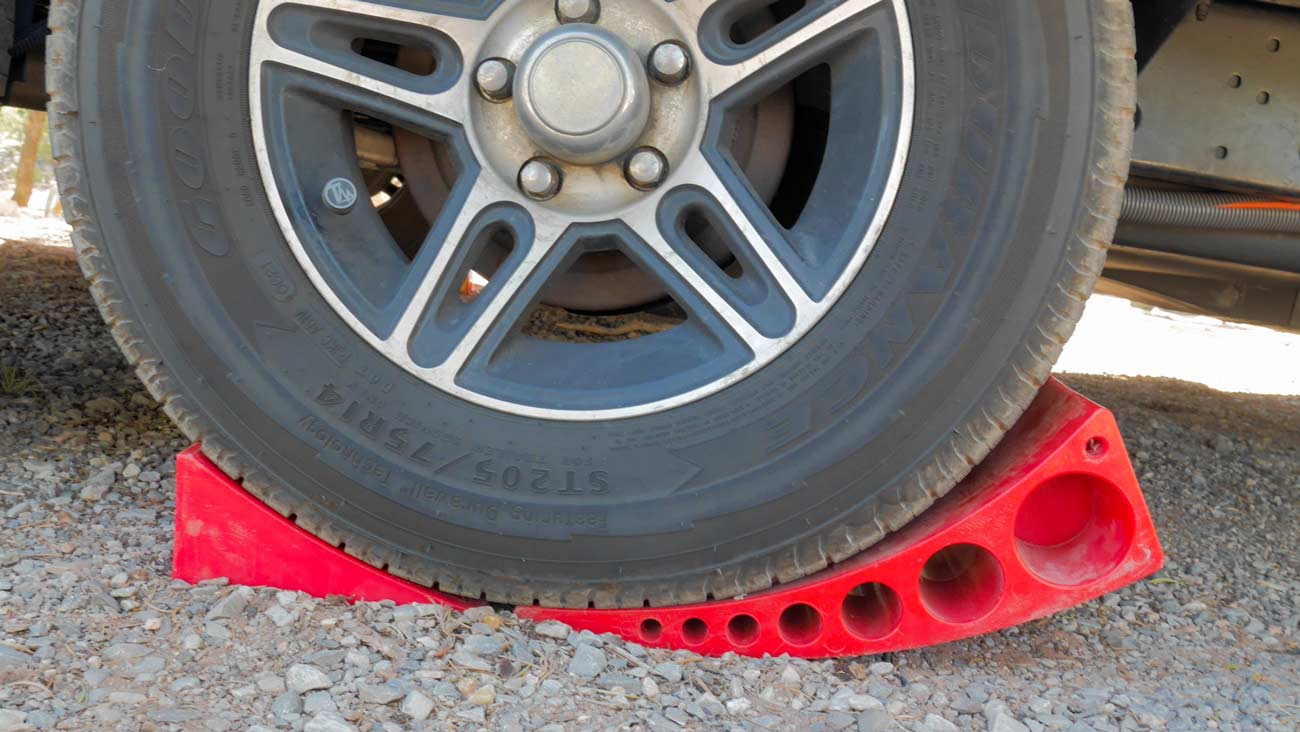
Looking at your leveling device, determine which side needs to be lifted, and place a lifting device such as Lynx Levelers or an Anderson Leveler under the downhill wheels.
Pulling the RV onto Levelers in 3 Steps
- Ensure your vehicle has its parking brake on before getting under the tires.
- Pull forward or reverse onto the leveler slowly. (This is where a spotter comes in handy to let you know when you are on the blocks.)
- Check your level and add or remove blocks until level.
Chock Wheels
Before unhitching, it is imperative to place wheel chocks under the RV wheels. The potential of an accident from a moving RV is not worth skipping this step that only takes a few seconds.
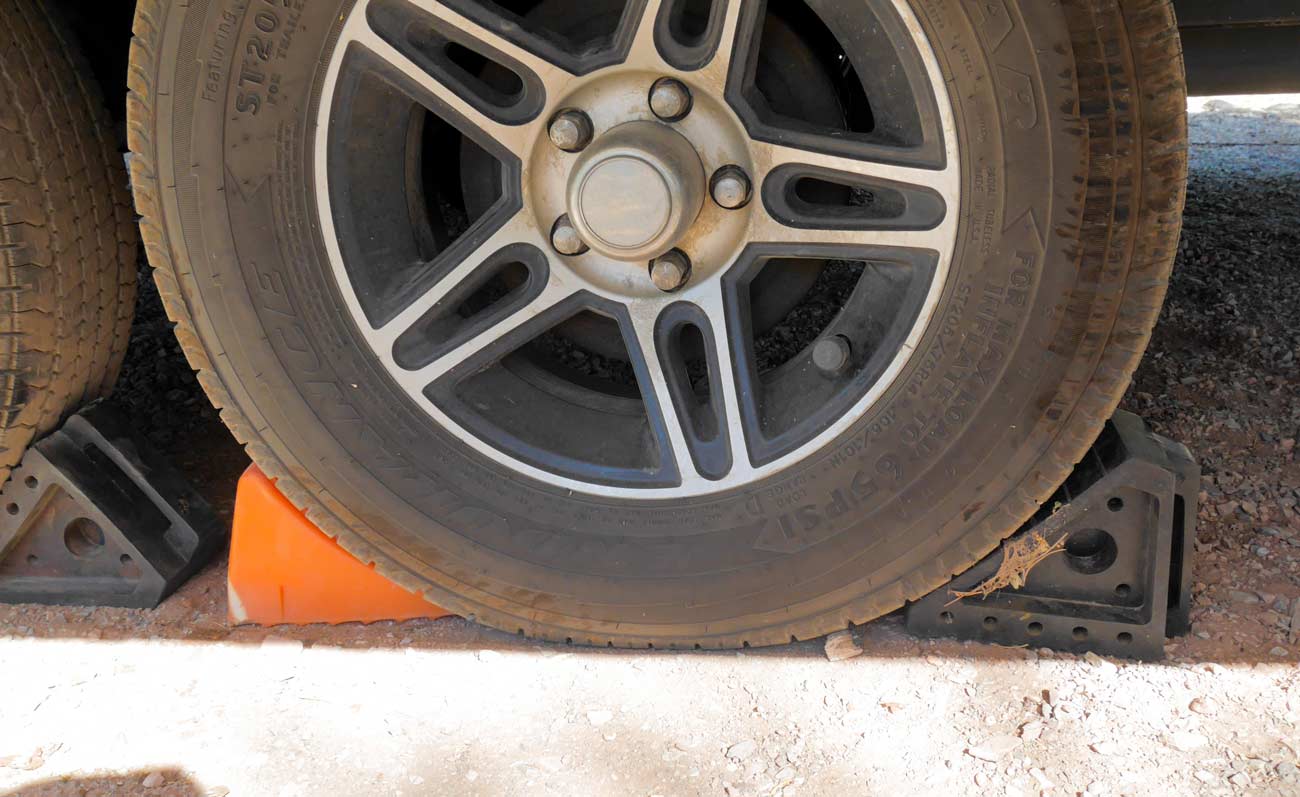
The heavy-duty rubber chocks are more sturdy and grip well. Two sets are recommended on extreme slopes or wet/soft ground conditions.
Unhitch RV and Level Front to Back
Now that your RV is level side to side, it is OK to unhitch the RV from the tow vehicle. Follow these five steps to unhitch and finish leveling your travel trailer.
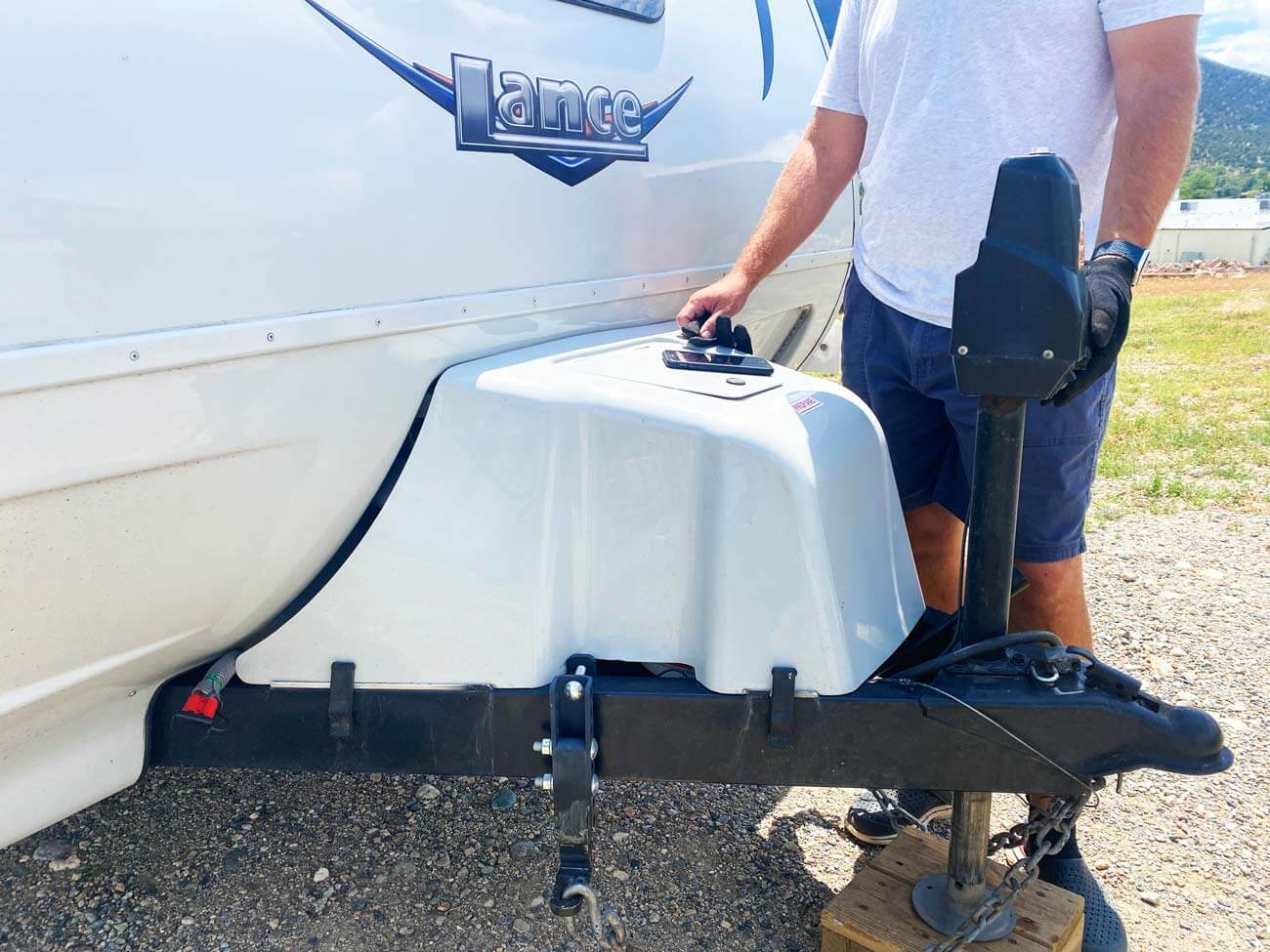
- Extend the tongue jack until pressure begins to be taken off the hitch ball. (Use a tongue jack stand or support block to protect the pad of your jack and reduce the amount of extension required.)
- Unplug the 7-pin electrical connector.
- Remove all equipped weight distribution or sway stopping devices, emergency breakaway brakes, and safety chains.
- Release the hitch ball lever and extend the tongue jack until the tow vehicle can be safely pulled forward.
- Using your leveler again, extend or retract the tongue jack until the RV is level front to back.
Put Down Stabilizers
When level, the stabilizer jacks (sometimes called scissor jacks) are extended to reduce the rocking that occurs in RVs from walking, wind, and other shaking. Stabilizers minimize strain on the frame of an RV when a slide out is moved in or out. Always put the stabilizers down before putting the slide out.
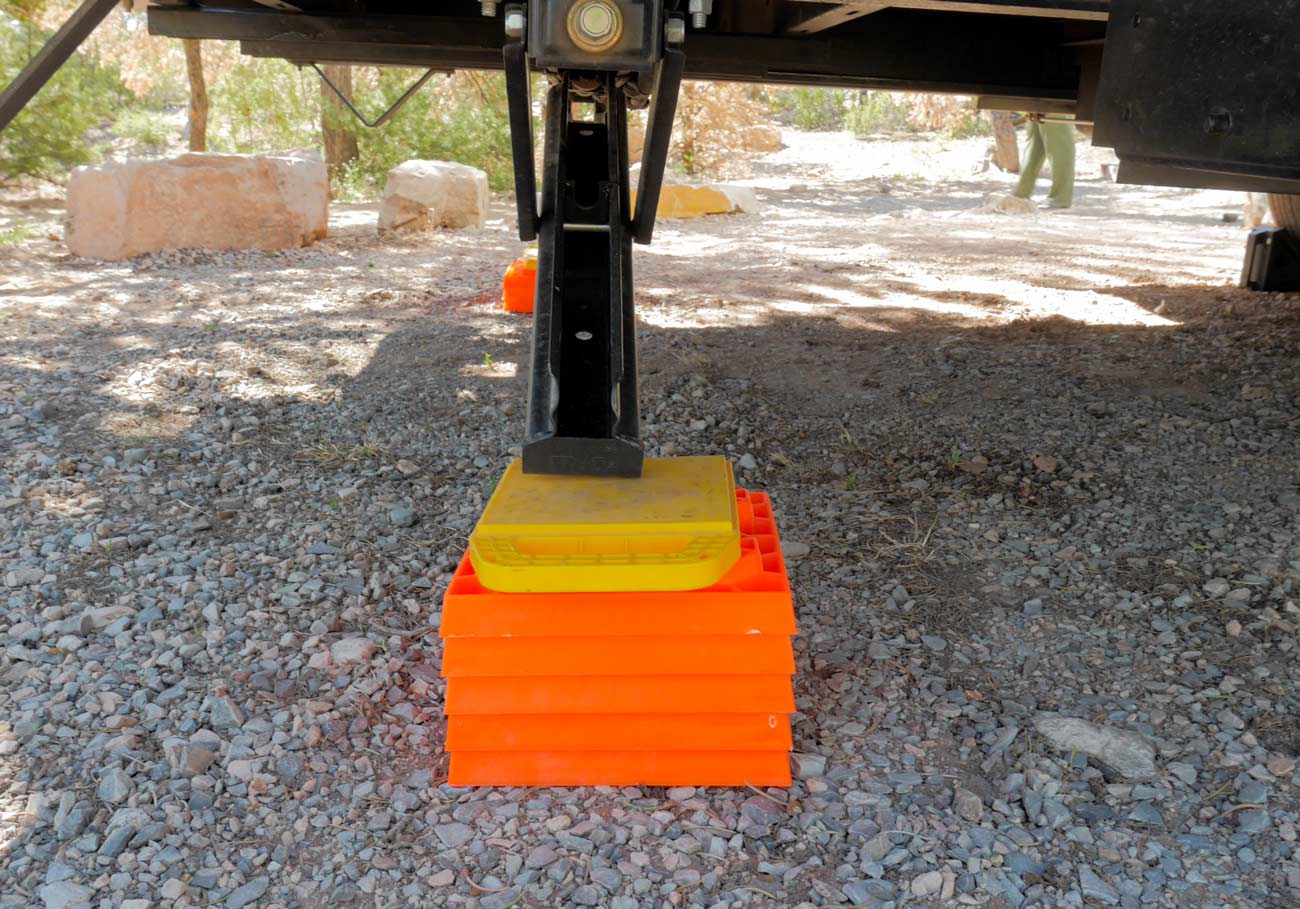
It is important to note that these are not the same as the automatic leveling systems in some motorhomes. If the stabilizer jacks are lifting the RV, you risk damaging the jacks and the RV. Stabilizing jacks support the RV by being pressed firmly to the ground, and no more.
Many RVs come with electric stabilizers that can be raised or extended with a switch. Manual jacks use a turn handle, but this drill adapter makes it less strenuous and speeds up the process. Jack pads are recommended to keep jacks from sinking and reduce exposure to dirt and moisture.
Connect Power
The electrical power cord is usually the first on the list to get attached. Often the slide needs to go out, or the air conditioning needs to come on. Plugging into electrical keeps those bigger loads from hitting the batteries.
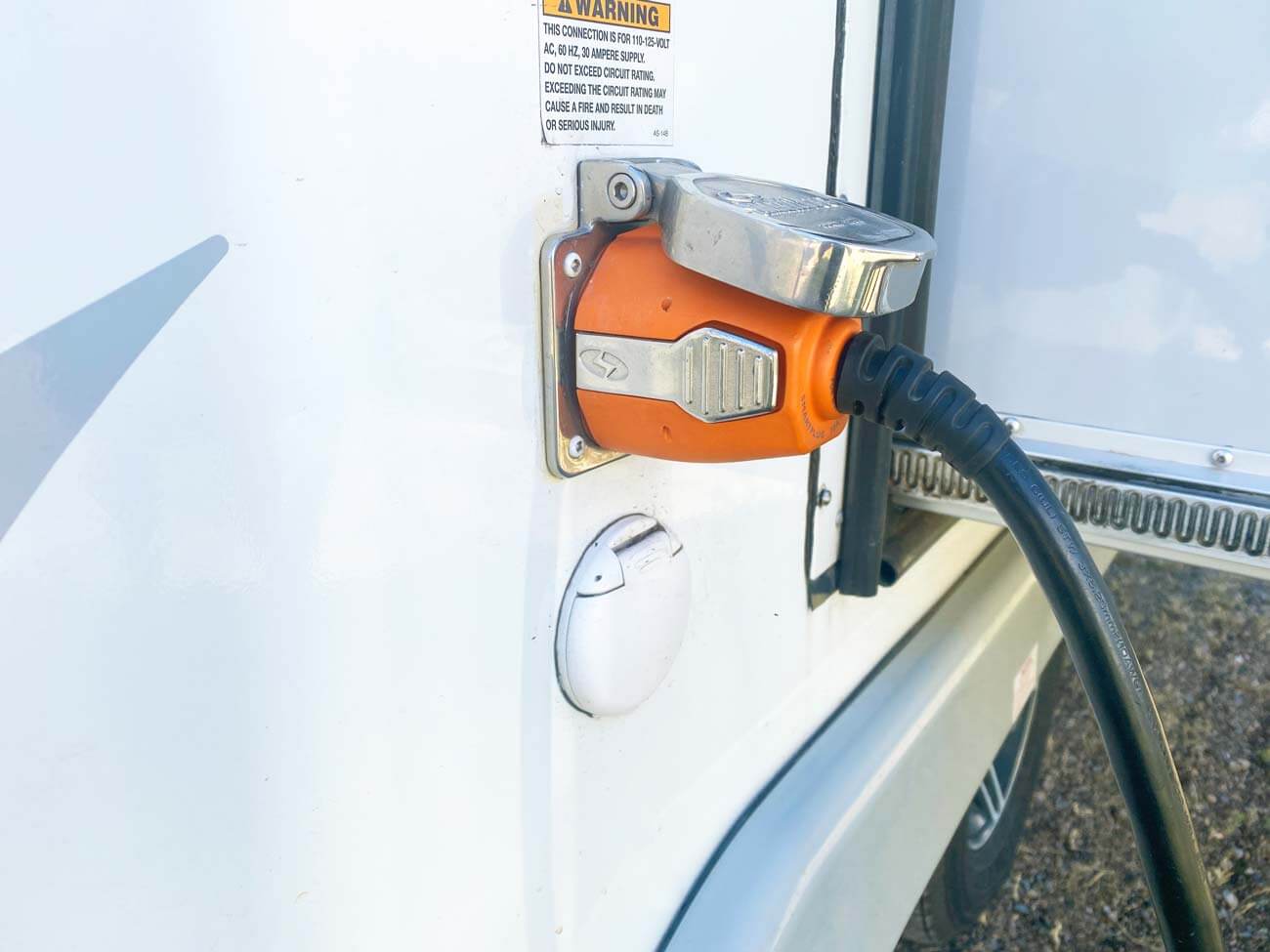
Your RV will require 30 or 50 amp service, but the campground may not have a site with your particular circuit. The good news is that an adapter easily connects a 30 amp plug to a 50 amp outlet or a 50 amp to a 30 amp , allowing you to stay in any available electrical spots.
Using a Surge Protector
You also will want to protect your RV from electrical disturbances with an RV surge protector. There are several types of surge protectors. A basic model surge protector plugs into the power pedestal and is the most affordable. Other versions of surge protectors are installed permanently in the RV , so you don’t need to set up anything at camp.
The pedestal’s breaker should be off until the RV is plugged in securely. Once the breaker is on, the surge protector will take a few seconds to examine the incoming power for problems like bad wiring before allowing electricity to flow. If there is a problem, the surge protector will display an error code and block the electricity.
Connect Water
If your site has a water spicket, a hose can plug directly into the RVs city water inlet or fill up the water tank. Use a hose rated for drinking water . Green water hoses have dangerous chemicals like lead, so skip those.
High water pressure can burst an RVs plumbing. Protect your RV with a water pressure regulator . A basic one does the job but can leave you with poor water flow. An adjustable water regulator set around 45 PSI protects most RVs and keeps the shower flowing nicely.
PRO TIP: Adding a Y-adapter at the spicket is a good tip for several reasons. One, it gives you a place to quickly wash your hands or hook up a black tank flush hose. Second, the lever is much more convenient to turn off and on when filling the water tank.
Water filtration.
Water filtration is a big topic and can be approached in many different ways. At a minimum, protect yourself with an inline one-micron water filter to reduce harmful contaminants, reduce odor and improve the taste. Add a pre-filter for two-stage filtration to reduce sediment, rust, and other particulates.
Advanced Water Filtering
It is debated if water passed through only inline filters is suitable for drinking. There are more advanced and expensive water purification systems if you plan to regularly drink from the RV water tap.
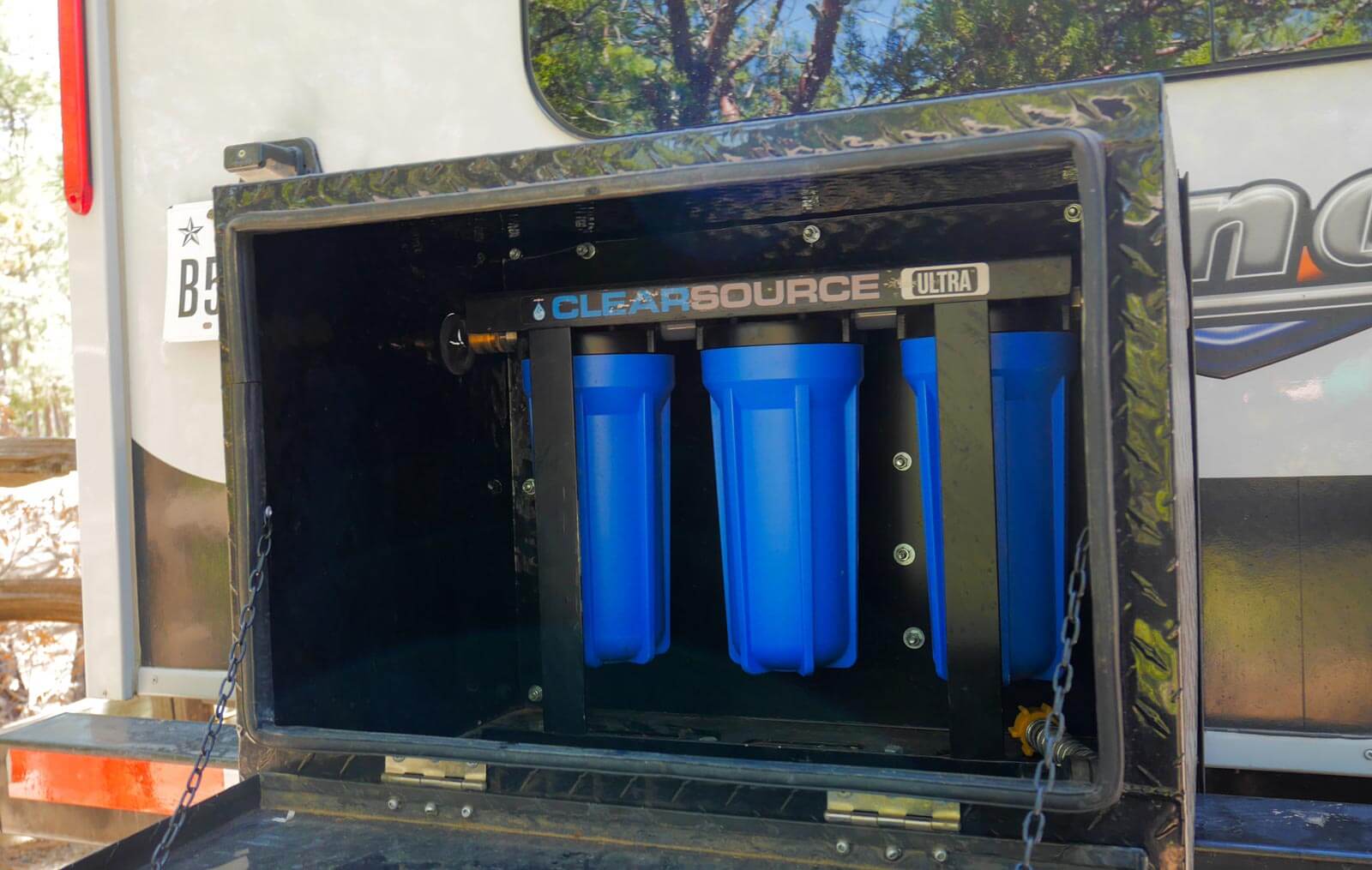
- If you have the countertop space, many people swear by the Berkey system .
- Advanced water filtration systems that can be installed in storage areas are available from companies like Clearsource .
- Acuva systems use UV light to kill bacteria and viruses and are more compact and mount under the sink.
Connect Sewer Hose
Connecting the sewer at arrival can be a convenient way to dump as needed. If your sewer connection significantly intrudes on another camping spot, try to be courteous and wait until you’re not disturbing your neighbor. A pair of waterproof gloves is recommended to use while setting up your sewer connection.
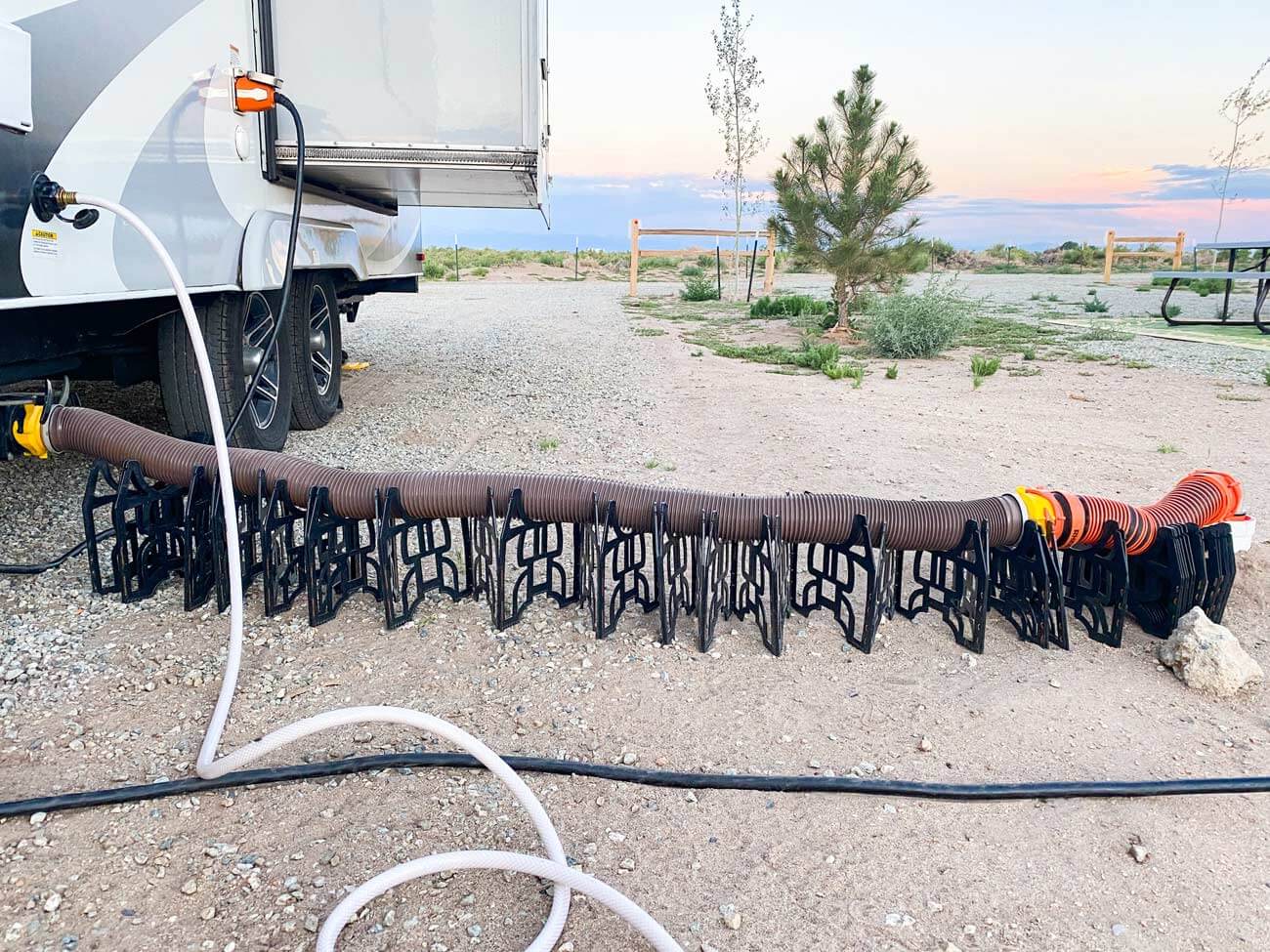
Setting Up the Sewer Hose Support
Use a sewer hose support to slope away from the RV to keep things moving and prevent build-up in the sewer hose. Lay out the support evenly, avoiding low spots and turns in the hose to make things clean when it comes time to disconnect.
Connecting the Hose
Attach the hose to the RV first, then lay the hose across the support. Remove the cap from the ground drain, quickly screw a clear elbow adapter into the threads that held the cap, and connect your hose to the adapter.
You’re ready to dump your tanks!
READ NEXT: For a complete list of travel trailer equipment to outfit your RV for travel, check out this list of travel trailer must-haves .
Finish setting up your camper trailer.
There may be items specific to your RV to complete your setup. You may have a slide that needs to come out, a satellite TV to set up, or an internet antenna.
Make your RV campsite setup feel like home with tables, chairs, lights, etc.
If you use your RV’s stove, you’ll also need to open the exhaust vent cover outside the RV.
We hope this guide and checklist will help you feel confident setting up your site. Now, sit back, relax, and enjoy your campsite, knowing it is ready to go!
Want more beginner tips on RVing and how to get started?
Check out our guide to preparing for full-time RV living, including info on choosing an RV, pros and cons of the lifestyle, RV gear lists, downsizing for RV life, and more.
Like this post? Save it on Pinterest for later.
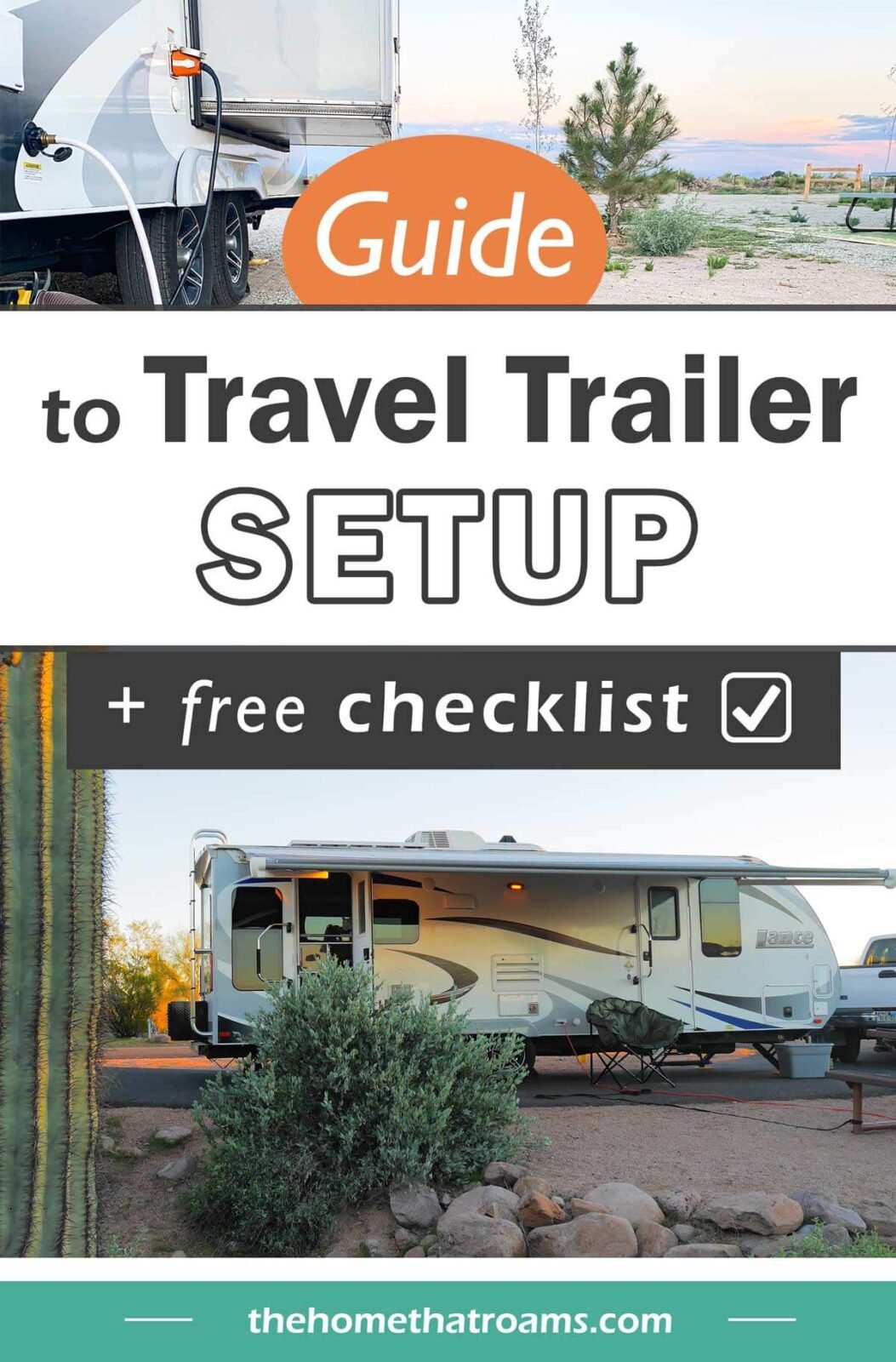
Morgan, the founder of The Home That Roams, has been living nomadically for over five years. She began her journey traveling across the U.S. in a motorhome and cruising on a liveaboard sailing catamaran. Currently, she lives full-time in a travel trailer, sharing resources on RV living and boat life to help others downsize their lives and thrive in an alternative lifestyle.
Leave a Reply Cancel reply
Your email address will not be published. Required fields are marked *
Sign Me Up!
Learn how to live in an rv.
Get weekly tips on how to start traveling full-time in an RV.
View our privacy policy .
Privacy Overview


RV Set-Up Checklist For Newbie or First Timers
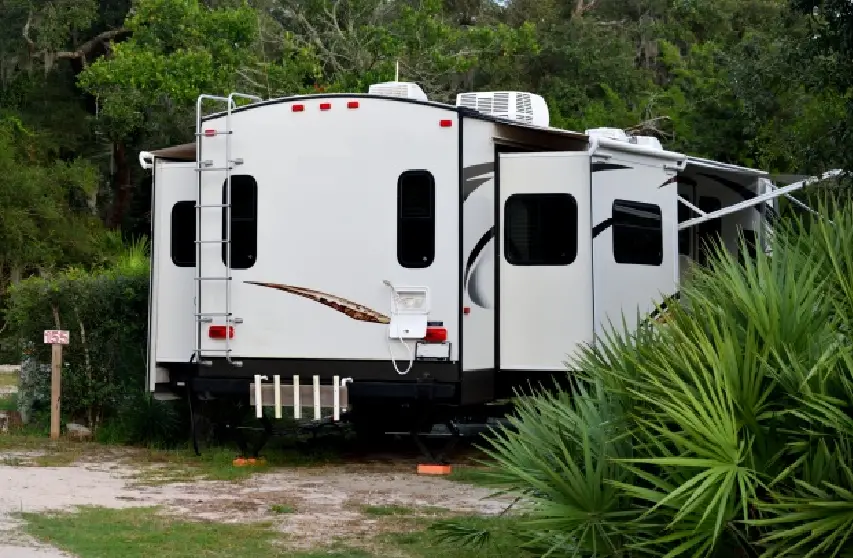
- BEGINNERS GUIDE
A checklist Is an essential thing in everyday life. It can be used when packing or planning meals for a trip. An RV checklist ensures that you have an easy time camping. For that reason, for a successful trip, you need to plan well.
An RV setup checklist will help you have a smooth and easy start after buying a new RV trailer. Different RVs have different makes and models that is why you need a set-up checklist to assist you in understanding your RV.
Here is what you need to do before you start your trip in the new Rv. Ensure that you check on the following;
Setting up RV at a campground or boondocking site
The first thing you need to do is ensure that find an ideal location on the campground and you park right. When packing the RV ensures that there is enough space for all slide-outs.
Bring out the slides and check for any obstacles like trees and poles or any other RV packed next. That way, you will avoid crushing or damaging your slides. You should also ensure that you park your RV in a safe place.
This is the next thing you need to do after packing your RV. It is very essential because if not level you will have a rough time sleeping, using the refrigerator, and cooking too. Poor leveling can also cause the tires to wear out too soon.
Things can roll back and forth in the camper making it uncomfortable to relax in the RV. It will also be a hassle using the toilets and bathroom too. Leveling on a concrete slab is easier than on a campground.
You need to use a level to check how leveled the ground is. Some people use Bluetooth vehicle leveling to help them save on energy. The Bluetooth vehicle leveling also helps them in finding a level spot.
There are also different ways to level your RV. You can use the RV leveling block system that uses the plastic blocks underneath the RV or under the stabilizers to lift the RV. You can also use the easy hydraulic leveling system. You use hydraulic jacks to lift the RV from the ground.
Another way is to use the stabilizer jacks that come in hand with the RV and can be used to make the RV stable.
Tires and pressure
Tire pressure for RVs is the most difficult thing to comprehend for most first-time RV users. Tire pressure should be put to the maximum found on the sidewall and not on the chassis plate.
If it is a hassle to find the right inflation pressure for your RV, You should contact the manufacturer who will guide you. if you end up putting less pressure on the tires, the RV might deflate before you complete your journey.
The tires might not serve you long before you need more pressure. To avoid the hassle of finding pressure while at the camping site, before you start your journey, ensure that you put maximum pressure on the RV tires.
Kitchen set up
This is the essential and center place of the RV. It is where you will spend most of your time cooking and eating.
You need to set up the kitchen to ensure that you can cook as soon as possible and enjoy your camping meals. Have a meal plan. You will need to know what you will cook for the days you will be in the RV.
That way, it will be easy to know what foodstuffs you will need to carry. Good food will also help you create memories. Also, check on the utensils, dishes, and cups too. They will help you in serving and preparing your meals. You should also carry cleaning products like soaps and shampoos for washing the dishes and floor.
This will ensure cleanliness while traveling. Another thing you should never forget is to set up your outdoor kitchen. Ensure that you have the best grill to give you a wholesome experience grilling your meat.
A good outdoor kitchen will also accommodate more people and will tend to be more spacious. Store the foodstuffs in the refrigerator to avoid them getting spoilt. You can also test the microwave and any kitchen appliance to ensure that they are properly working and suit your purpose and needs.
Bathroom and toilet set up
You need to ensure that your bathroom has soap, shampoo, deodorants, toilet paper, and toothpaste. This will ensure that you have an easy time using the toilet or bathroom. Also, ensure that your toilet jas enough water to wash hands after use and also flush down waste.
Water hose set up
You never want to run out of water in the RV. Water is essential for use in the RV like showering, drinking, and washing the dishes. Ensure that the water hose pipes are well fit.
You also need to choose water hose pipe measurements that ensure good connectivity from the water source. Choose water hose pipes that will last longer without having to call a plumber to fix them. Getting hose systems that wear out is only going to be an expense for you.
Also, ensure that there are different pipes that direct water to the kitchen, bathroom, and toilet. That way, you will ensure water efficiency in the RV. The water hose connection should have filters to ensure water is filtered for good hygiene.
Water pressure regulator
Always have an RV water regulator just in case water pressure is too high. In case water pressure is low, you will not need to have a water pressure regulator.
Too much water pressure can damage the water pipes and systems. For that reason, ensure that you monitor water flow in the RV to help you gauge if you need a water pressure regulator.
Sewer hose set up
Ensure that the sewer system pipes are correctly connected. That way, you will avoid replacing them more often. You should connect a loft sewer hose to a successful connection.
The first step when connecting a sewer hose is to put a sewer adapter on the RV’s tank drains. Then you measure the distance between the ground and the bottom of the adapter and minus 2 inches and cut.
To the end of the sewer hose adapter add a rubber with 3 inches diameter and put it together. Ensure that the connections are tight and no leaks.
Electrical outlets set up
Plug in the RV power source and use a surge protector or an RV auto former. This will help you safeguard sensitive and expensive appliances in the RV.
The surge protector will also help you save up on some money. The electrical system will be used for overhead lighting, cooking, refrigerator, and hot showers. You do not need to be an electrician to fit up your new RV electrical system. RVs have a 12 volt battery that can run the electric equipment in the trailer.
For an efficient electricity supply, you need to understand the basics of electrical wiring, voltages, and plugs. That way, it will be easy to understand if anything in the camper goes wrong. It will also be easy to fix electrical issues to avoid damage and fire in the RV.
Propane tank set up
The propane tank is the most essential thing in the RV. It is like the nerve center of the RV. It is used for cooking, refrigeration, and hot water showers. The propane tank serves the main functions in the RV.
That is why before you start your journey, you need to ensure that your propane tank is well fit ad functional. You also need to understand the two types of propane tanks that are the ASME tanks and the Dot cylinders. That way, it will be easy to tell which propane tank your RV has. Also, you need to fill your propane tank.
You can do this by taking your RV to the nearest propane dealer. Ensure that you choose a certified dealer to ensure that you have the best propane. You will also note that some dealers will allow you to use your propane while others will require an employee to pump it for you.
In case you are short of propane while at the campground, you can consult the campground as some of them have propane refills. Propane expands when subjected to heat and that is why it is only put at 80% capacity. Propane tanks come in different shapes, sizes, and different uses.
You will also note that the size of your RV determines the size of the propane tank. Check where your RV propane tank is located because RVs have different propane tanks locations. Another trick to first-time RV users is that refilling an existing propane tank Is cheaper than buying a new one for exchange.
Everybody needs to rest after a long day of work. the same case applies to RVs after a long that or week of camping. They need proper storage to ensure that they serve you longer. Storing the RV will also help you prepare it for the next camping adventure.
You need to look for a good storage location for your RV. If you have enough space at home, then you can opt to store it there. Choose a place that the RV will not get direct sunlight, rain, or extreme harsh weather conditions. That way, you will ensure that your location is climate-controlled.
You need to look out for this because you do not know when you will be using it next. You might also require put it in a storage facility that is close to you. Before storing it, you will need to do a deep clean. Ensure that you clean up everything in the RV. Remove any dirt to prevent it from building up when in the storage room.
Be sure that where you store your RV there are no pests. That way, you will be sure that the RV is safe for the next travel. You will also need to drain all fluids in the camper. Ensure that you drain water and sewer pipes before storing them. This will ensure that there are no clogs in the pipes.
Restroom set up
You will need to establish an aerial connection for the RV TV and Radio. This is what will entertain you while in the RV. Set up your satellite dish in a place that allows a good connection. Switch on the TV or Radio and start watching or listening to your favorite channel.
You will also need to check on the beds to ensure that they are in good condition. You can also set up the furniture according to how you want them to look. That way, you will ensure comfortability while watching, resting, or reading your novel.
Also, extend any slide out to establish more sleeping or resting space in the RV.
Hitch, connection, or towing car
When towing cars to an RV you will need to ensure that you have the right equipment. You will begin by parking on leveled ground. Ensure that when parking you leave some space for your car.
Towing will require some extra practice to ensure that you it correctly. You also need to prepare the car that needs to tow. Ensure that you follow the manufactures guide on how to tow the car. Ensure that the car’s steering is locked by inserting the ignition key and turning it to ACC and leaving the key in the ignition.
Buying an RV for your next camping or vacation trip is one of the best things you can do. You will need to ensure that you know how to use the RV before the planned travel date. That way, you will ensure that you have a smooth trip.
Have a checklist for all the equipment set up. This will help you identify a problem in case anything stops working. Familiarize yourself with everything to help you use the RV for the first time.
You Might Also Like
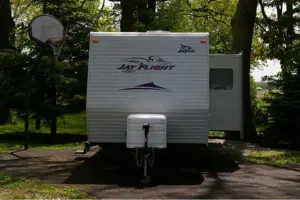
Do i Need RV Slide out Topper (Pros and Cons)

Pop Up Camper Tips and Tricks (Organize, Mods, Ideas And Hacks)

Can a Toyota 4Runner Tow a Travel Trailer?
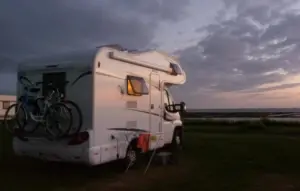
19 RV Camping Mistakes to Avoid For Beginners Or New RV Owners
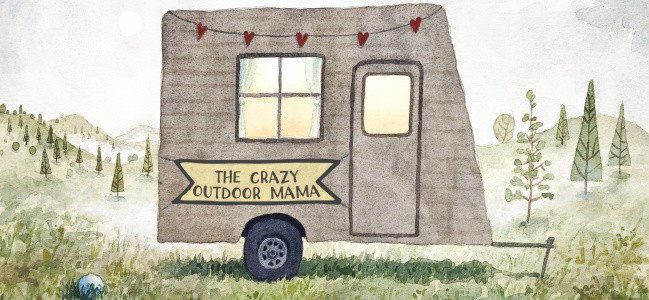
The Ultimate RV Camping Checklists for 2024 [9 Free Printable PDFs]
If you just bought an RV and are now looking for a checklist of everything you need to go camping, you might be a little intimidated… but don’t worry! I’ll break down everything you need to get to camping!
Not going to lie, this RV checklist can seem pretty big, but the good news is that once you get everything in place, you shouldn’t need to buy new things for your RV very often!
We personally bought ALOT of stuff used. This helped us save a lot of money on the basics such as kitchen and organizational items. That way we could have more for travel or for buying the things that were important to us or more of a “luxury”.
I will include my premade RV camping checklist you can print as well as each list item. That way you can copy and paste what you want and make your own RV camping lists!
9/5/21 NEW “RED-y” RV Checklist Set (see picture below!) available now

Before we start – here’s a fun way to use your checklists!
If you’re someone who likes to keep organized in all aspects of your RV life, then you may be interested in creating and binding your own custom camp journal – complete with a layout design planner to make things easier!
Not only are there the standard RV checklists, but also options to add in things like journal entries, travel logs, maintenance, milage logs and more!
P.S. If you’re tent camping, I created a tent camping specific checklist packet here !
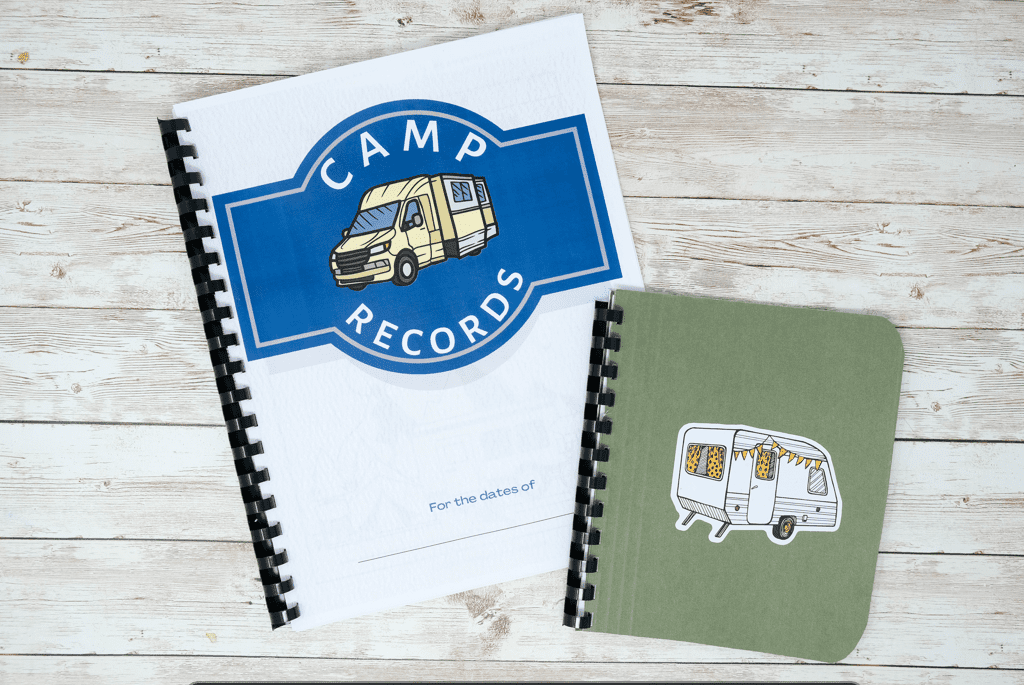
Trailer Hook-Ups RV Checklist
This is probably the only checklist RV owners will have to buy new, and pretty darn quick – a lot of these items are necessary for RV travel.
- ⬜ Sewer hose
- ⬜ Freshwater hose
- ⬜ Power cord adapter
- ⬜ Black/dark color hose for black tank
- ⬜ Rv Manual (You won’t have internet access everywhere should you have a question!)
- ⬜ Water pressure regulator
- ⬜ Wheel chocks
- ⬜ Rubber gloves
- ⬜ Water filter
- ⬜ Wye fitting for hoses
- ⬜ Emergency brake cable
- ⬜ A connector to reduce 50 amp to 30 amp and vice versa
- ⬜ Jack and/or ramp
- ⬜ Tire iron
- ⬜ Tire Gauge
- ⬜ Leveling Blocks
- ⬜ Spray bottle with bleach water (for hooking up to fresh water)
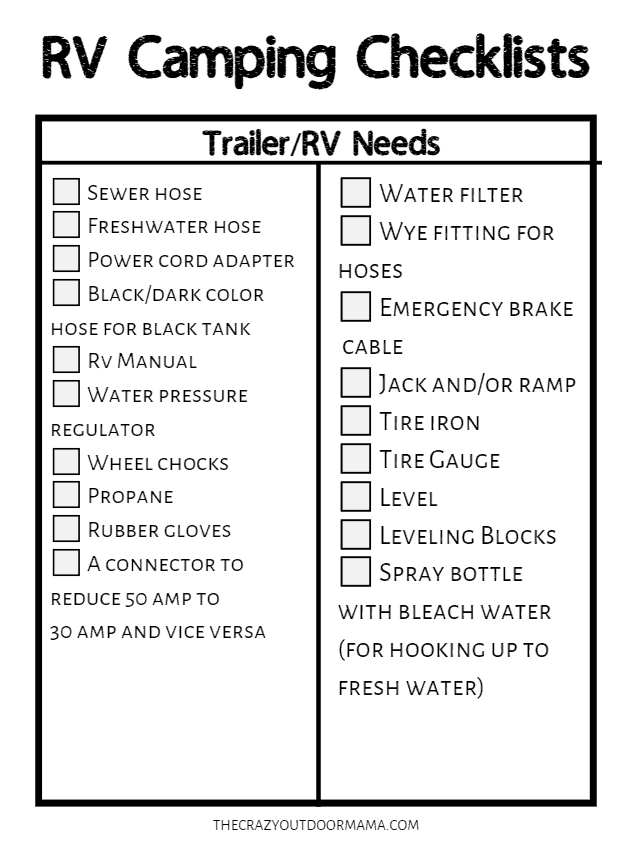
RV Tools to Keep on Hand
Probably one of the most important RV checklists that you won’t realize the importance of until something breaks! This is especially true if you plan on full-timing or traveling long distances since there isn’t always cell service or a repair place nearby (that won’t cost you an arm and a leg!)
Check out this article to see all of our exact RV tool recommendations (with links!) We have three little kids, so we definitely are sure to be very safe and prepared in the tool department!
- ⬜ Screwdriver w/multiple tip sizes and types
- ⬜ Needle nose pliers
- ⬜ Electrical tape
- ⬜ Duct tape
- ⬜ Hammer/saw/hatchet
- ⬜ Bungee cords/ratchet straps
- ⬜ Folding shovel
- ⬜ Small step stool/ladder
- ⬜ Extra extension cords
- ⬜ Torque wrench
- ⬜ Tire plug kit/rv tire jack
- ⬜ Flashlights
- ⬜ Extra hitch pin
- ⬜ Extra fresh water tank cap
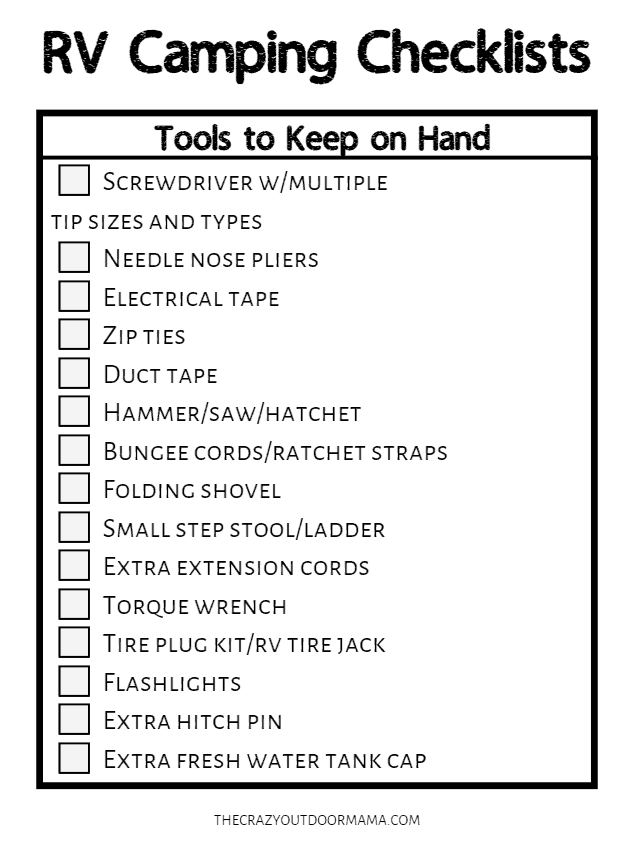
Outdoors Camp Gear
All you really need are some chairs and a way to start a fire… but these are all nice to have if you want to slowly add on to your collection!
I compiled a list of RV outdoor gear upgrades here if you want to see some deluxe stuff!
- ⬜ Entry mat
- ⬜ Camp Chairs
- ⬜ Charcoal/lighter fluid/lighter
- ⬜ Bug Spray
- ⬜ Citronella Candles/Insect Repellent
- ⬜ Patio Lights
- ⬜ Outdoor extension cord
- ⬜ Portable grill
- ⬜ Sunscreen
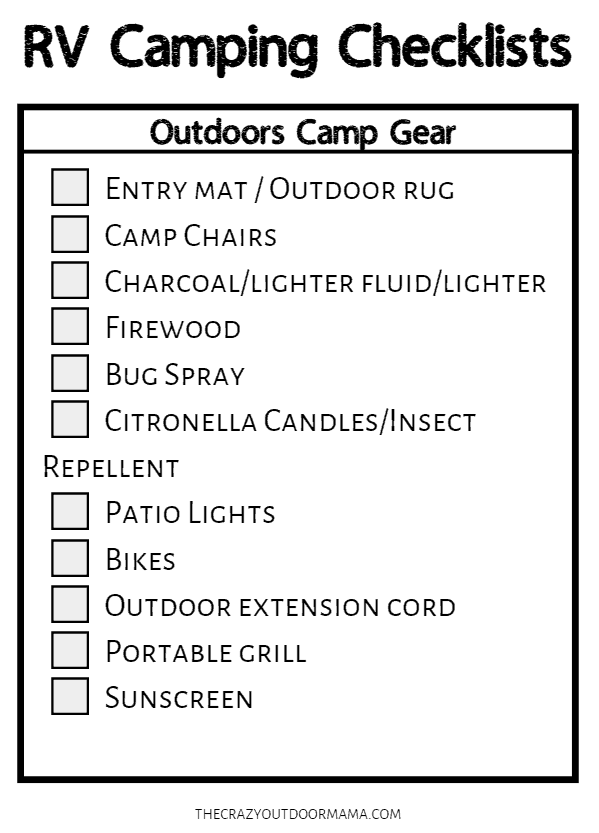
RV Kitchen Checklist
- ⬜ Crock pot or Insta pot
- ⬜ Cast iron
- ⬜ Coffee pot
- ⬜ Trash bags
- ⬜ Dish soap
- ⬜ Ice chest
- ⬜ Food/Drinks
- ⬜ Can opener
- ⬜ Pots/Pans
- ⬜ Silverware
- ⬜ Dish towels/Dish Rags
- ⬜ Plates/Bowls/Cups
- ⬜ Paper plates
- ⬜ Picnic table cloth
- ⬜ Small trash can
- ⬜ Paper towels/napkins
- ⬜ Foil/Ziplock bags
- ⬜ Wine bottle opener
- ⬜ Bottle/can opener
- ⬜ Can/bottle koozies
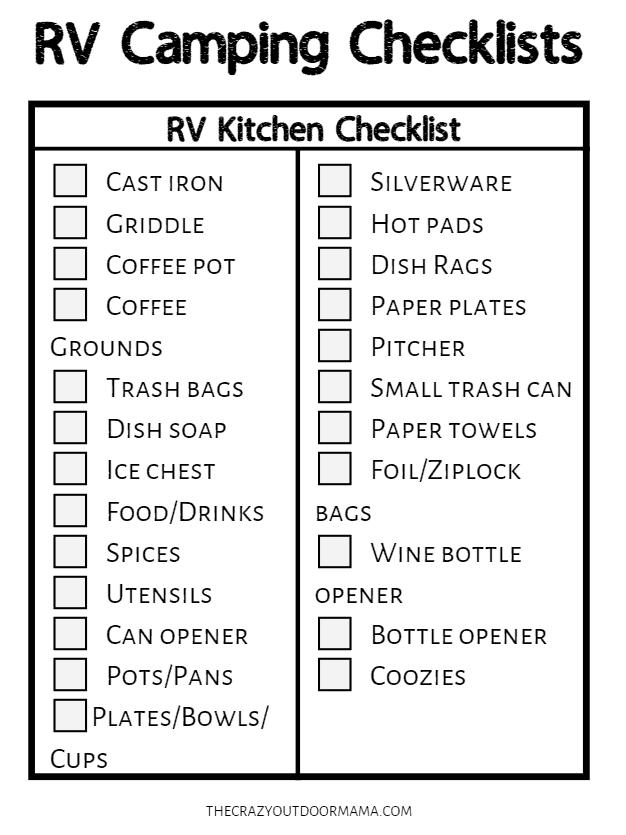
RV Bathroom Checklist
Depending on how far you’re going and if you’re going to use the shower in your RV, this RV camping checklist should be pretty easy!
We don’t often use our shower for short camping trips, and on long trips we try to pepper in some hotel showers as an excuse to explore town. If you plan on using yours often though, make sure you got the basics (+ some medical items!)
- ⬜ Toilet Paper
- ⬜ Toiletries
- ⬜ Sun screen
- ⬜ Band Aids
- ⬜ Eye Drops
- ⬜ First Aid Kit (make sure to include Benadryl)
- ⬜ Feminine Hygiene Products
- ⬜ Extra hair ties / pony holders
- ⬜ Any personal medications
- ⬜ Copy of insurance cards
- ⬜ Tote to carry items to shower
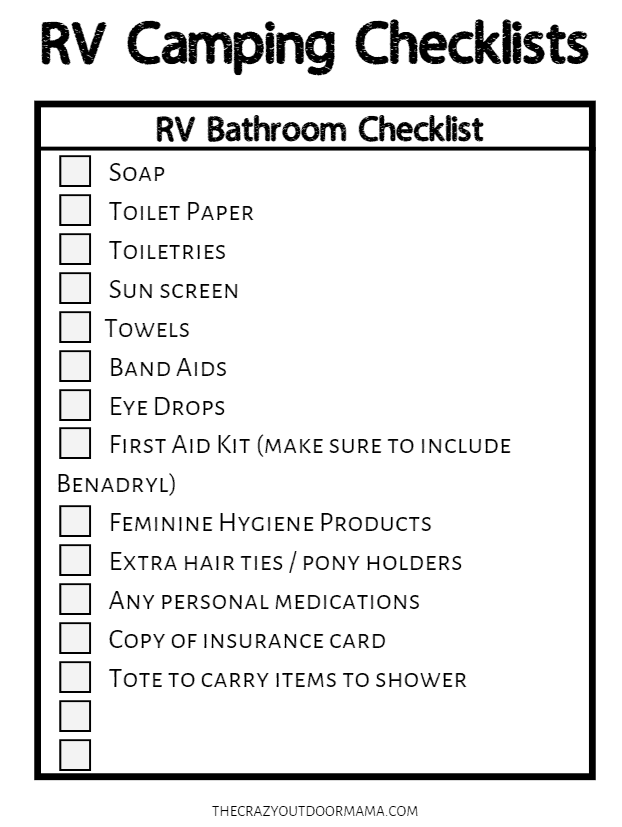
RV Bedroom Checklist
- ⬜ Clothes/pajamas
- ⬜ Outdoor clothes/hiking boots
- ⬜ Water shoes
- ⬜ Swimsuits
- ⬜ Beach towels
- ⬜ Hats/Sunglasses
- ⬜ Flip flops for shower
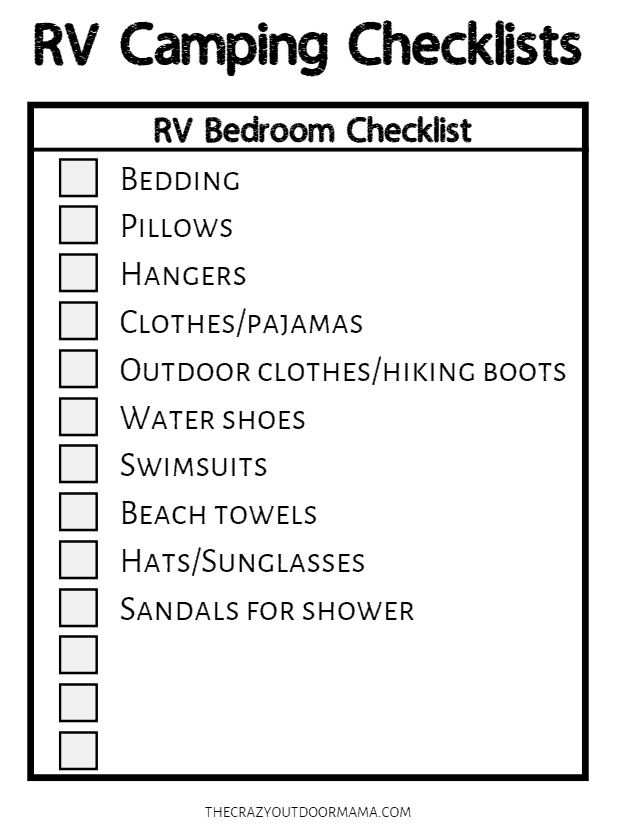
Other RV Needs
Here are some miscellaneous things to think about bringing to your camper!
Two things I want to point out – the surge protector you’ll need for your RV when hooking up to campsites is NOT the one you use at home! RV Surge Protectors like this are built for RVs that often plug into new power sources. They monitor for spikes and will auto shut off if they detect something dangerous!
Secondly – Always bring a checkbook! A lot of campgrounds don’t accept credit cards (especially the ones out of cell service) and you never know if you’ll be out of cash (ATM machines are hit or miss in small towns). We have used it as a last resort a couple of times when our other methods of payment fell through!
- ⬜ Surge protectors
- ⬜ Batteries – various sizes
- ⬜ Extra Plastic Bags
- ⬜ Card/Board Games
- ⬜ Small laundry soap/dryer sheets
- ⬜ Paper/Pen
- ⬜ Broom / dust pan
- ⬜ Throw rugs
- ⬜ Checkbook (in case campgrounds don’t take cards and you don’t have cash)
- ⬜ Copy of insurance papers
- ⬜ Rope/clothes pins
- ⬜ Command strips
- ⬜ Extra fuses
- ⬜ Spare bulbs indoor & out
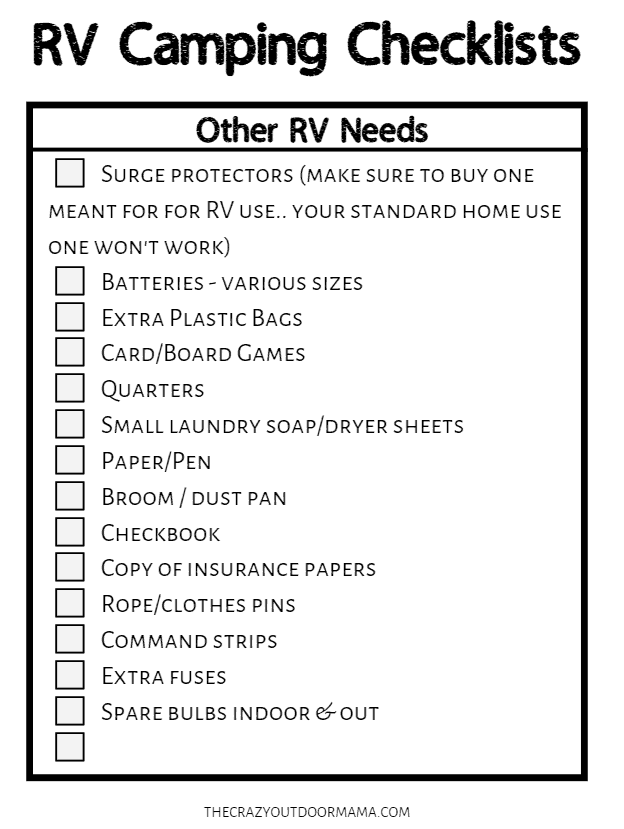
RVing with Babies/Toddlers
There’s going to be way more gear now than when they get older, but it’s worth it to still go out and adventure! At the time of writing this, I have a four year old and two year old twins!
Try to keep in mind that there’s a minimal amount of baby stuff you need to bring on a camping trip with young kids. But you can usually pack a few extra items that will make camp life waaaaay easier with your young child!
All you REALLY need are the meds + diapers and wipes… but after camping with three babies now, I will say that all the stuff below that helps ALOT!
Here we go!
- ⬜ Diapers and Wipes
- ⬜ Rash Cream
- ⬜ PJS / Daytime Clothes
- ⬜ Thermometer
- ⬜ Infant Tylenol
- ⬜ Safe Sleep Situation (Bassinet, cosleeper etc)
- ⬜ Favorite toy or lovie
- ⬜ White Noise Machine
- ⬜ Bottles and/or Formula
- ⬜ Bottle Cleaning Gear
- ⬜ Hat and/or Sunglasses
- ⬜ Potty Chair if applicable
- ⬜ Camp Highchair
- ⬜ Camp Bouncer
- ⬜ Camp Pack N Play / Containment Area
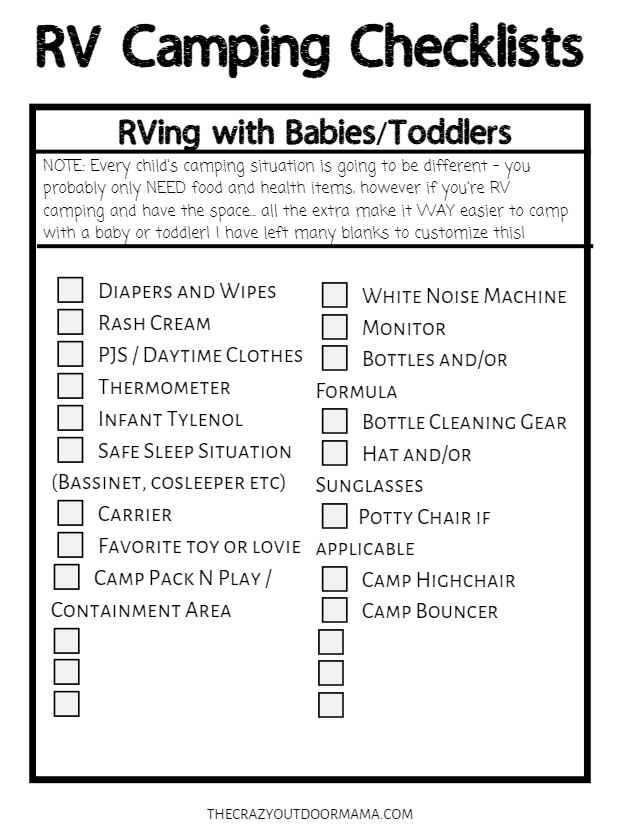
RVing with Pets Checklist
We don’t have any, but have camped with A LOT of dogs! Here’s a list of things you don’t want to forget if you want a successful camp trip with the pets!
- ⬜ Stakes/lead
- ⬜ Poop bags
- ⬜ Food/water bowl
- ⬜ ID tags/Vaccination tags
- ⬜ Copies of vacs records
- ⬜ Fencing/gates
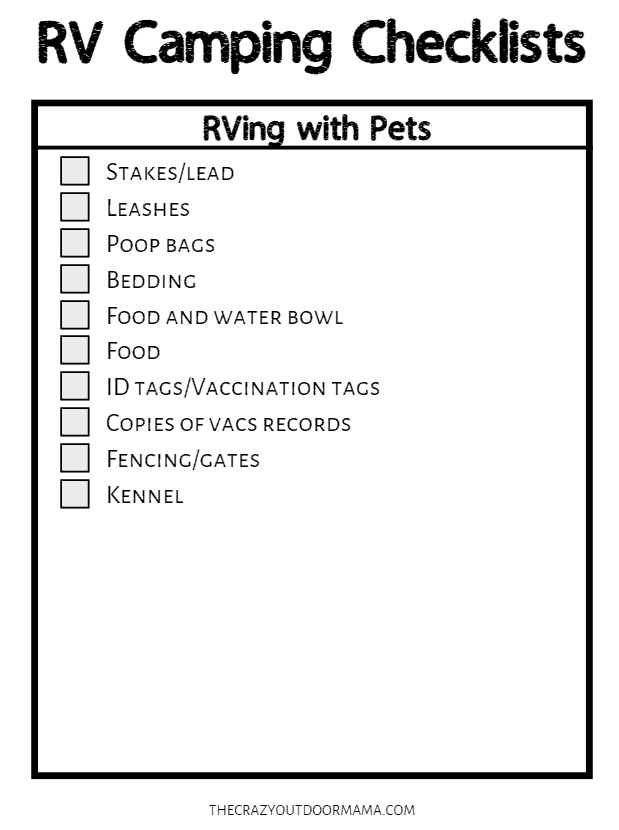
Leave in the comments any items you think I should add to these checklists!
I want these to be the absolute most helpful RV checklists around, so help me improve them by letting me know in the comments anything I’m missing!
Sign up on the form below to download your 9 RV Camping Checklists today! Plus you’ll get access to my ENTIRE Resource Library with tons of other fun printables!
Whether you’re a first-time camper or a seasoned expert looking to get more organized, these camping checklists have everything you could need!
This includes camping with babies/toddlers and animals!
Alternatively, copy and paste the checkbox list I created for each section and make your own custom checklist that’s perfect for you!
Lastly, if you prefer not to share your email or just want it now (with some cover options, meal plan and updated font!) you can purchase it on Etsy!
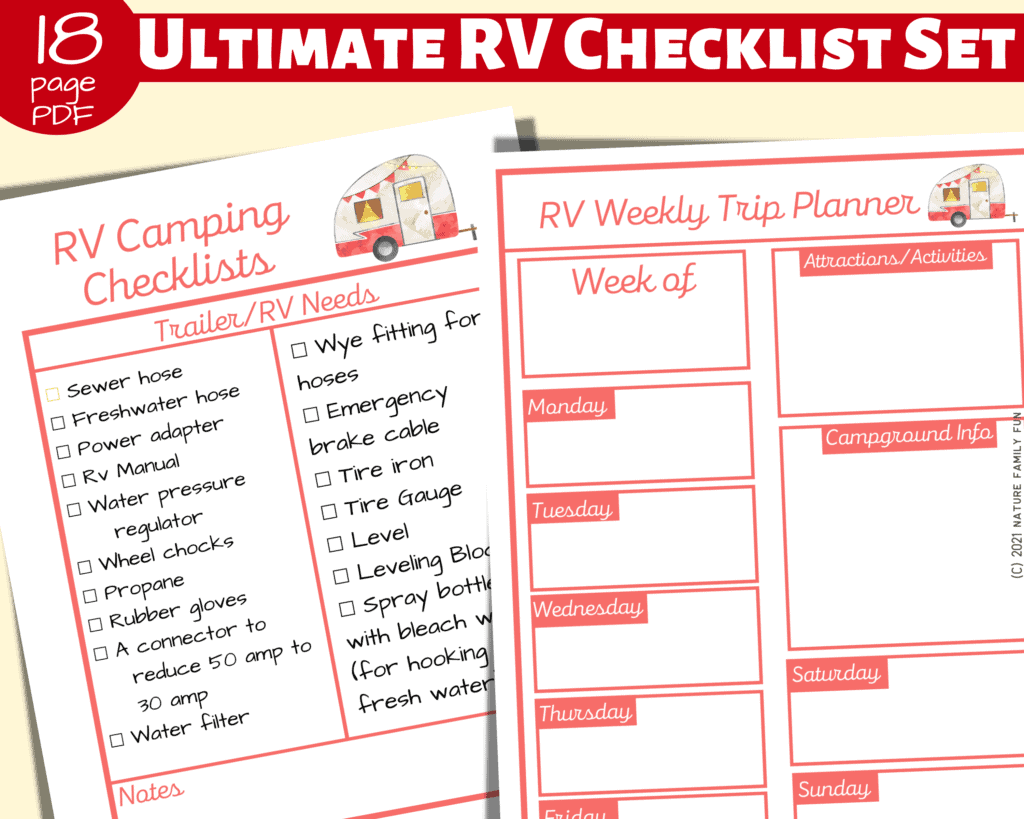
Here are some other RV-related articles you’ll love!
- Make sure you have the tools you need to fix almost anything in your camper for your next trip (so you don’t have to go back home!)
- And even if you have to get something big fixed, check out this Guide to Mobile RV Repair .
- Ready to indulge? Check out the best indoor RV items that you don’t need.. but will thoroughly enjoy!!
- Patio mats are a great addition to your RV camping kit. Check out the top 5 RV Patio Mats here.
- Check out these top RV Backup Cameras . Avoid a messy accident!
- Bake some decadent dutch oven chocolate cupcakes at camp (it’s not as hard as you think!)
- If you’re freaked out at how easy it is to clutter small spaces, then you gotta read my interview with a professional organizer… turned full-time RVer! She gives 41+ tips on how to organize the clutter in your camper !
- Make camp life easier with your travel trailer with these awesome outdoor RV products !!
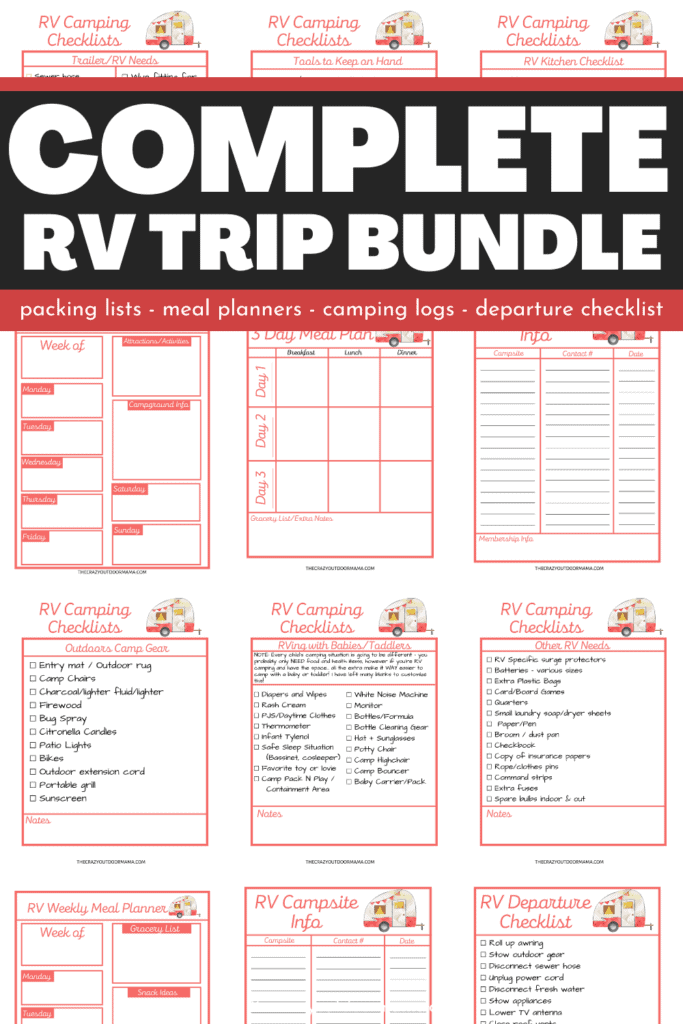
- Latest Posts
- DIY *Giant* Taylor Swift Friendship Bracelet Banner (from Pool Noodles!) - May 30, 2024
- Adorable Dandelion Stems Hedgehog Craft for Kids - May 15, 2024
- Dandelion Banana Slug Printable - May 15, 2024
122 thoughts on “The Ultimate RV Camping Checklists for 2024 [9 Free Printable PDFs]”
can’t seem to find where to download PDF in order to print the camping checklist?! We don’t need the babies or pet one!
Hi Ireee! You need to sign up (the form is near the bottom of the post) and then you will be able to access the resource library where it (and a TON of other camping printables!) are stored. You might even find something else you like there! – Stacy
How do I download the PDF’s? I signed up already. I see the pages on the website but no where to download them. Thanks, Suzy
Hi Suzy! When you sign up, you’ll get a password to be able to access the “Resource Library” where all the printables are at (including the 9 page RV checklist one!) I’ll just send it over to you though to make it easier. – Stacy
Very well made PDFs. Definitely helpful, even for a single experienced RVer. Safe travels.
David, Thank you, it makes me so happy that you’ve found them helpful! Safe travels to you too! – Stacy
Sandy, Your welcome for the 9 RV camping checklists.. hope they make your packing less stressful! – Stacy
Marci, You’re welcome, I hope the rv camping checklists help ya out! – Stacy
I have signed up 3 times with 2 different emails and still can’t receive the password that I need to print the checklist. Please help
Hi Kathy, I’m so sorry for the hassle getting these RV checklists! I have emailed you the PDF and a surprise for all the hassle! All the best, Stacy
Please send me the check list
Hi Sheila! I’ll send these rv camping checklists over to the email you made your comment from. I hope they’re helpful! – Stacy
Love the camping journals! I will definitely be ordering one from amazon for my kiddos! I would love one of your camping checklists if possible, going camping this weekend ;). Thank you!
Thanks Becky! I hope your kiddos love it <3. I'll send the RV checklists over! Have an AWESOME camp trip!! - Stacy
I can’t find the pdf of the checklists, am I missing it?
Hi Jamie! There is a sign up form at the bottom of the post (I changed the text to have a green backing so it’s easier to see). I’ll send them over the camping checklists, but if you ever need anything else you should sign up! you might find some other printables you like! =) – Stacy
Please send me the checklists
Please Emil the RV lists as I don’t download apps. Had too many issues.
thanks for the rv checklists for a new camper
Hi Stacy! My husband and I are getting ready to take our first camping trip and I would love to be able to download your checklist! We’re a little nervous about our first trip! Thanks!
Lynne, How exciting! It can definitely be pretty nerve wracking to go on that first trip (heck I still forget stuff if I don’t use some of my checklists!) I’ll send it over and then add you to my email list so that you can access some other camping printables you might need! – Stacy
Excited to actually get to go camping and get out of the house!
Awesome! Hope your first trip of the season goes well Jamie! We’ve been on a couple camp trips now, and it’s felt freaking awesome! – Stacy
Looking forward to using these amazing printouts with grandkids.
Thanks Tommie! I hope the rv checklists help you have a smooth trip with the grandkids! What an awesome grandpa you are! – Stacy
I look forward to using the camping list~
Hey Connie! I hope the checklists help with your next RV trip <3 - Stacy
So glad someone thinks lists are great. Thanks for putting this together
Hi Carrie! YES! Lists are life! If I don’t have one I just completely space! Your welcome, hope it helps with your next camp trip =D – Stacy
We are seasoned camper / boon dockers. We camp for weekends, or vacations. We have been from OR to OK and to IL and all states traveled in between We keep most of the stuff on your lists in the travel trailer all the time. i just like to look at lists to see what other people pack in their RV’s. One of these days I will make a list of my own. I would like to shorten our loading time by being a little more organized and save time. Maybe we can take a long vacation after I retire in a few years. Maybe a snow bird one winter. I did enjoy your writing and lists. .
I would love to have your checklists! On the page for the PETS, it would be good to have recent good photos of your pet in case it runs away. and gets lost. Make sure your pet has a tag with phone number on it as well.
Thank you for providing the lists!! They will be very helpful.
Hi Cheryl! I think that’s a great idea! I hope you enjoy the RV checkllists – they are in the resource library (the pw is in the email that was sent to ya!) – Stacy
Hi Penny! Your welcome (thanks for commenting!) I hope the RV checklists help ya! – Stacy
best list i have seen
Hi Charles! Thank you so much for your kind words! =D I hope these RV camping checklists help you out during your next outing! – Stacy
please send checklists. just brought our first rv trailer.
Hi Glenda and Paul! There’s a sign up form at the bottom of the article – just put your email in there and you’ll get the password to use here https://www.thecrazyoutdoormama.com/resource-library/ and type in the password. You’ll be able to find the rv packing list in the top section!! – Stacy
I’d like to print out the checklists, how do i get access to them?
Hey Stacy, I’ve tried several times to download the RV list and it won’t. I signed up with my email like it said to but can’t get it to do anything else. I have the password but don’t know where or when to use it.
Could you send me the download for rv packing list
Hey Sandra! There’s a sign up form at the bottom of the article – just put your email in there and you’ll get the password to use here https://www.thecrazyoutdoormama.com/resource-library/ and type in the password. You’ll be able to find the rv packing list in the top section!! – Stacy
Your welcome Teresa! – Stacy
Your welcome Sharon! Hope it makes camping packing easier! – Stacy
Hi Stacy, My wife and I are new to the Camper world and would love to begin right with your checklists.. Cheers Paul and Dyana
Hi Paul! Welcome to the camper world! I think you’re going to love it! You can sign up here https://www.thecrazyoutdoormama.com/the-crazy-outdoor-mama-library/ to get my email and all the checklists you need! I hope your first camp trip goes well! – Stacy
Looking for the password to use to receive the checklist. Thank you so much.
Hi Karen! It should be at the bottom of the email you received. Please let me know if you can’t find it! – Stacy
Thank you for shari g your lists. I cannot wait to use them thank you again.
Your welcome for the RV checklists David! =D
I would love to get your camping lists. Thank you so much.
Thanks! As a newbie these will be very helpful.
Your welcome Cindy! It makes me so happy you found them helpful!! =D – Stacy
New to RV world and this will be my first trip out on the road. Going to travel from Florida to Houston TX.
Congrats Andy!! Have a safe and fun first trip!! – Stacy
Hi Jack! No problem! I can’t wait for you to try them out (I hope winter goes by fast!) – Stacy
Thanks for posting these
check lists please
Please send check lists. I am a newbie. You are awesome
Hi Iris! Check out the sign up form so that I can send them over to you! – Stacy
Please forward the URL/password to the checklist downloads. Thanks so much!
Will be retiring this year and looking forward to happy trails! Looking forward to seeing your checklists- I need all the help I can get 🙂
AHHH congrats Joann!!! That’s so exciting! I hope they help, they help me still and I’ve been camping for awhile now! – Stacy
Thanks Steven! I hope they’re helpful for your next RV trip! – Stacy
They look outstanding. I will use them
Just starting the RV process, getting ideas
Congrats on starting the journey, Amy! It’s a great feeling getting that first one and knowing you can sleep almost ANYWHERE now in your own mini him! – Stacy
Thanks for the lists. We are new at this. Appreciate the help
Your welcome David! What’s your rig? Let me know if you have any questions! – Stacy
Thank you for sharing your lists.
Youre welcome Melissa! I hope they help with your next RV trip! – Stacy
9 free camping lists please
I did sign up and confirmed my subscription , however; I never received anything to download the sheets
Hi Molly! There should be the pw to my resource library in the email to confirm. That is you’ll find the rv checklists and other camping printables =) – Stacy
Thank You from a newbie
Thanks for the info…from a newbie
Your welcome Jan! Welcome to camping life!! =D – Stacy
We appreciate the list, so that I don’t have to create one!
Your welcome! I’m so happy you’re finding the rv checklists helpful! – Stacy
This looks great
Thank you Marian! I hope these are helpful for your next RV trip! =D -Stacy
Thank you for the list
Your welcome Tiffany! Happy camping! – Stacy
Thanks bunches!
You’re welcome Pamela! Let me know if you have any questions about how to get your rv checklists! – Stacy
Just getting started so looks like a good list to use
Welcome to the RV camp life Tony! Nice to have ya! They should help you out quite a bit – heck, they help me out years later still! – Stacy
This looks great. Thank you!!
I’m happy you love the RV checklists, Linda! I hope your next camp out is even more organized now! =D – STacy
Thank you for the check list!
Your welcome Wyvonna! Thank you so much for commenting, and I hope the rv checklists help you during your next camp trip! – Stacy
COnsidering an RV and want to know what we are in for
Looking forward to getting these list. Thanks,
Just bought our first travel trailer. I know this will bw very helpful.
cannot find download for lists
Hi Melissa! Once you’ve signed up, you should get an email from me with the password. You can type that here and get the lists (and a whole lot of other fun RV stuff!)
We will be picking up our RV in 10 days. Your checklists will be very helpful?
We are new to camping so appreciate all the checklists! Thank you!
would like checklist
Thanks for the RV travel list, newbies here.
thank you for the lists they will be so helpful
I would like to print the lists out. thank you!
I would love to have these lists!! Thank you!!
Looking for lists. Thanks.
I would love to be able to print out the lists you have available.
Thank you, Barbara
Hi Barbara! You can sign up at my resource library and I will email you the password to be able to download it yourself whenever you need it! Or, if you prefer, you can just purchase the checklists and some bonus covers/list here from my Etsy . I’m finding some people prefer to get it that way instead of using their email address, so I like to have both options available! – Stacy
Thank you ~ I think these will be very helpful as first time travel trailer owners…
Your welcome Michelle! I hope these help your next RV trip be more organized! =D – Stacy
Hello, Your checklists are easy to read and detailed! Thanks for taking the time to put these together! As we wait for our first RV to arrive, these checklists make our first few trips do able and not so overwhelming! I’m having trouble downloading them, can you direct me to an easier way to download them? Thanks for your time, Scott
Hi Scott! I’m happy you’ve found them helpful! So if you were able to download the checklists from the resource library here , I would just save the PDF file somewhere easy to access like your desktop or on your favorite cloud drive (I use dropbox and cloud) and then print from there each time. That way, you won’t have to come to my website and deal with logging in and all that stuff. I hope this helps! -Stacy
I would love more of your information on camping!!!
Hi Shelly! Thanks for reading – make sure to sign up for my email list to receive more info on camping! – Stacy
Thanks a lot!
Leave a Comment Cancel reply
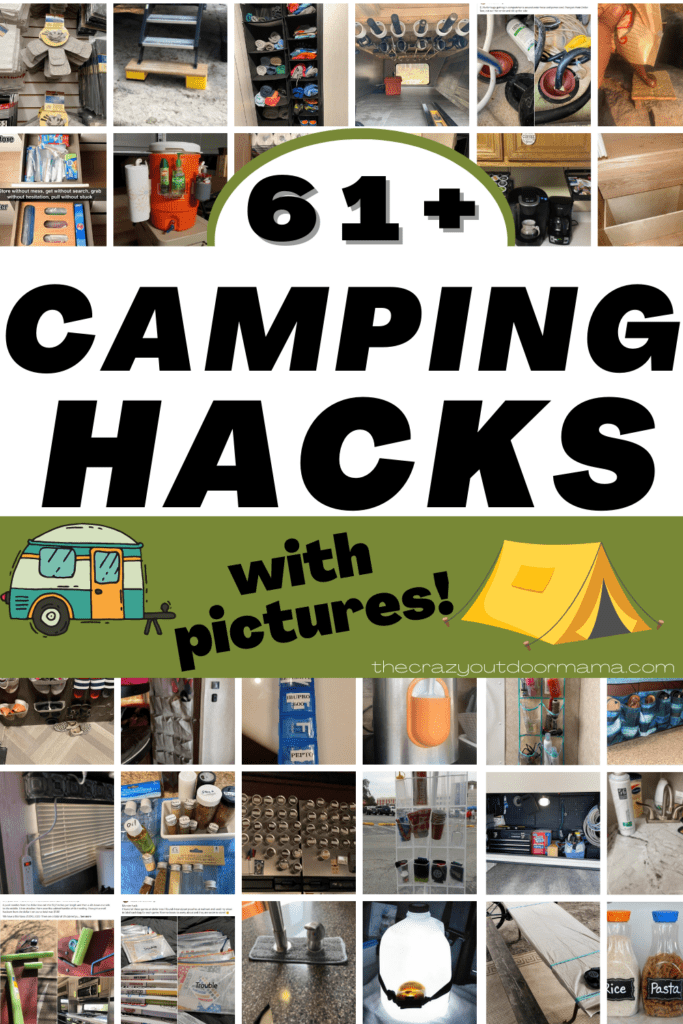
HI! I'm Stacy, AKA “The Crazy Outdoor Mama”
I'm the voice behind the website, and I hope you've found what you needed! I'm an outdoorsy married mother of three from Wyoming, and I LOVE creating resources that make camping and other outdoor activities easier!
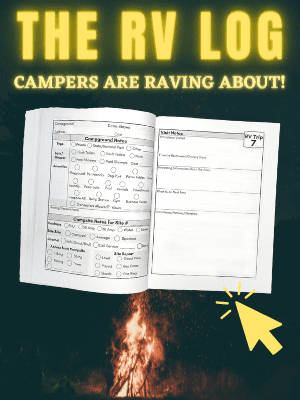
Save up to 50% on self storage
- Self Storage
A Complete RV Setup Checklist
You’ve finally arrived at your favorite campground, and you’re ready to set up your home away from home. Setting up camp doesn’t have to be cumbersome. In fact, with an RV setup checklist, it can be a smooth ride that takes you from travel mode to camp life in an instant.
Now, how exactly you set up your campsite is up to you. You may decide to add some notes to this checklist, and that’s fine by us. Make it your own!
This checklist hits the major points that every RVer needs to take care of before the relaxation begins.
Your Essential RV Setup Checklist
Forming a habit of adhering to a systematic setup process helps you avoid frustrations and turns this task into a simple, efficient routine.
#1: Choose the Right Spot for Your RV
Before you even get to your campsite, be sure you’ve booked the proper campsite for your size and type of RV. Note that not all campsites can accommodate RVs over 40 feet . Because it’s better to be safe than sorry , check with the campground to confirm your spot will fit your camper. While you’re at it, you’ll also want to check the distance to hook-ups (and other site amenities).
- Confirm campsite dimensions with the campground
- Confirm distance to hookups
#2: Position Your Camper Properly
When you first roll into your campsite, the excitement of a new adventure can be electrifying. However, before you start enjoying the RV life, make sure to evaluate your site thoroughly.
First, ask yourself: where are the hookups? You’ll want to park close enough for your chords and hoses to reach. (While there are extensions you can use, it’s easier not to.)
Next, are there obstructions that might get in the way of your slide-outs and awnings? Avoid those when backing up.
When parking, you want to find the flattest spot that’s within reach of the hookups (and far enough away from any obstacles).
If you need help parking your camper, check this out. In the meantime, be sure to check off these to-dos.
- Assess your site
- Locate hookups and potential obstacles
- Find flat ground
- Park your RV
#3: Secure and Level Your RV
Once you’ve parked, you need to break out the RV chocks (Check out this list of 2024’s best RV wheel chocks ). These handy plastic accessories keep your trailer or camper from accidentally rolling away –with you still inside.
Pro tip: For dual axle trailers, X-chocks like these are best . Place them between the two sets of wheels, and they’ll prevent the trailer from rolling forward or backward.
Be sure to place your chocks in front of and/or behind your wheels before you disconnect your trailer from the tow vehicle.
Then, lower the stabilizing jacks and level your camper front to back and side to side. (From one RVer to another, do yourself a favor and keep a yard or meter level in your pass-through storage for easy access).
The longer level works best because it tells the continuity of the length of the level, whereas a shorter level can only tell you the continuity of that smaller length.
Here’s how to level your camper properly.
- Position wheel chocks
- Place support blocks
- Disconnect the trailer
- Lower the stabilizer jacks
- Level the camper
#4: Hookup Your Camper
Once you’ve leveled your RV, it’s time to connect your lifelines . That’s your water and electrical connections (and sewage and propane, where applicable).
Let’s start with the power cords. Here’s how to connect to power:
- Before plugging in, switch off the breaker at the power supply box to protect against electrical surges.
- Plug a surge protector into the pedestal
- Plug in the RV power cord
- Switch on the pedestal breaker and check the power
To hook up your RV’s water supply, you will need to :
- Use a drinking-water-safe hose.
- If you prefer, install an inline filter to ensure the water is safe and flowing properly.
- Connect the hose to the campground’s water supply hookup.
When hooking up your RV to the sewer, follow these steps:
- Connect your RV sewer hose to the waste outlet on your RV. Then, connect the other end to the campsite’s sewer connection.
- Open both the black and gray water discharge valves.
Now that your RV is secured and your essential lifelines are connected to shore power, you have the option of dividing your checklist into two parts for a more efficient setup . One person can work on the interior setup, while the other can focus on the exterior setup.
#5: Interior Setup
Once your RV is secured, unfold the stairs and walk inside. Naturally, some things may have shifted during the journey. Fix what has fallen out of place and then proceed with the following…
- Check water and electricity to make sure they’re functioning properly
- Extend the bump outs. After ensuring there are no obstacles and extending the bump outs, set up any furniture that was folded and secured during travel, such as the dining table, chairs, or foldable bunk beds.
- Power on essential appliances . Namely the coffee maker.
- Distribute/rearrange any gear that was packed over the axles , moving it to the proper rooms
- Check electrical connections to entertainment centers that may have come loose during travel.
- Connect your router or extender for internet access . Technology can greatly enhance your camping experience . From providing entertainment to keeping you connected, it’s important to ensure your tech equipment is functioning properly.
- Check the battery voltage on the control panel
- Troubleshoot converters and inverters as needed
Of course, the amount of indoor setup depends on your RV and your style. You may want to add “open windows,” “organize shower door,” “unpack belongings,” or “make beds” to your set-up checklist–but that’s, ultimately, up to you.
#6: Create Your Outdoor Space
Yes, you’ve parked and hooked up your RV utilities. But now it’s time to set up a comfortable outdoor living area, perfect for unwinding post-adventure. Outdoor furniture not only adds a comfort element–but also gives you extra storage space and allows you to inject your own personal style into your campsite.
Pro tip : If you’re in an area that is prone to severe weather, you may need to break down your outdoor living room quickly. To prepare for any incidents of severe weather, keep your pass-through storage available for your exterior accessories. Easy access to your pass-through storage will make the take-down process easy.
- Protect yourself from the elements: If your camper doesn’t have an awning, there are several pop-up canopies and tents that you can extend over your outdoor dining spaces and use as conversation areas. Some of these canopies come with mosquito netting, too (like this one ), which is a huge plus if you plan on camping in the south. Many RVs come with the option of adding an awning to one side.
- Roll out the welcome mat: Having a large outdoor rug defines your space and reminds people to wipe their feet before coming inside, cutting down on the dirt that enters your camper.
- Set up your camp chairs and end table for afternoon drinks. If you’re the creative type, you might want to bring a hammock along for all of your outdoor reading and sketching.
- Add outdoor lighting: Should you need extra outdoor lighting, consider hanging a string of warm lights. Keeping the lighting warm allows your eyes to adjust to the darkness more easily.
#7: Invite the Neighbors Over!
You’re all set! With your RV fully set up, it’s time to shift focus to one of the most enjoyable aspects of RV camping…your neighbors!
Camping means living in close quarters with other folks who enjoy swapping stories over the campfire (almost as much as you do). You get to know each other over a few days or weeks. With each campfire conversation, you’ll grow closer. Before long, you’ll realize that we’re not all that different from each other.
But What about Breaking Camp?
Well, if you look back through our checklist, you’ll notice it’s not just an RV setup checklist. It functions as both an RV setup and take take-down checklist. All you have to do is read it in reverse with special attention to a few areas.
- Double-check all hatches to be sure they’re secured for travel – including your shower doors.
- If you don’t want your air conditioner running on battery power, be sure it’s switched off.
- After shutting off the water, turn on your faucets to remove the excess.
- Dump gray water
- Dump sewage at the dump station on your way out, if necessary.
When breaking down camp, you may want to draft up a separate checklist. That way, you don’t forget to test trailer lights before you pull out or overlook crucial elements like the breakaway cable (if you pull a travel trailer). It will all depend on your personal setup.
Do you know the single most important step in setting up your RV? Having everything you need, when and where you need it.
I know it sounds like a pipe dream. But it’s possible!
After you get back from your trip, store your RV properly, and your next adventure is already off to a smooth start. That means finding a place that is covered, nearby, and preferably not going to break the bank.
That’s where Neighbor Storage can help.
Neighbor is a peer-to-peer storage marketplace where you can find safe, affordable storage close to home.
And if you’re an RV beginner who’s excited to embrace RV life, check this out.

Related Posts
- RV Ownership
RV Electrical Hookups 101: Tips for a Safe and Efficient Power Connection
Top 20 travel trailer essentials for stress-free adventures on the road, hit the road with confidence: top 7 essential rv basics for beginners, how to level a camper: the simple step-by-step guide, best 5 las cruces rv parks, top 6 grand canyon rv parks.

Justin earns $650/mo on Neighbor. Find out how you can too!
Stay in the loop ↓

The Only FREE Printable RV Camping Checklist You Need (+ In PDF & Excel)
Welcome, intrepid explorers one and all!
If you’re like me, you have an unquenchable thirst for adventure. Your ears are finely tuned to the call of the wild. You believe that life is too short to be stuck behind a desk, doing some uninspiring office job 5 days a week for the next 30-odd years.
No matter where this finds you in the world, there are new places to explore and new experiences to be had. But you already knew that!
If this sounds like you and you happen to have an RV: this checklist is for you.
The article that is about to follow offers a comprehensive rundown of everything you need to know when planning for your next RV camping getaway. The following are the topics that will be covered:
- RV-Trailer Hookup
- Camping Essentials
- Outdoor Camping Essentials
- Leaving the Campsite
- Camping with Kids
- Camping with Pets.
And just when you thought this blog post couldn’t get more helpful – I also have a PDF version and Excel version of the checklist for you at the end of the blog. Let’s get started!
Table of Contents
Pre-check rv conditions (exterior):, pre-check rv conditions (interior):, rv trailer hook-ups checklist, rv camping essentials checklist, outdoor camping essentials checklist, safety checklist, leaving the campsite checklist, camping with kids checklist, camping with pets checklist, pre-trip rv checklist.
The pre-trip: Arguably one of the most important parts of any adventure!
This includes all of the research into the region/s you’ll be traveling through, any paperwork/permits you may need to fill out or acquire, ensuring your driver’s license is valid, and more.
Luckily for you, everything you’ll need to get sorted out before your trip begins is listed here.
- Vehicle registration and insurance Arguably the most important paperwork you will need to tend to the entire trip. Make sure you have these two things sorted out – you never know what might happen
- Driver’s license This one goes without saying, doesn’t it? No driver’s license, no driving!
- RV owner’s manual By all means, bring a book or two on your trip. However, this will be the most important piece of literature you could hope to have out there
- Maps and navigation tools Absolutely vital! If you’re not into the physical map experience, make sure you have maps saved on your phone of the areas you will be traveling to
- Campground reservations It’s important to book ahead! I know from experience; there’s nothing worse than a long day of driving, only to get to your campsite someone (me) forgot to book. Don’t be like me. Be smarter
- Emergency contact information If something goes wrong, you need to be able to get in contact with the right people! Have a look for the numbers of the appropriate emergency services in the areas you’ll be traveling through, just in case.
- Tires and tire pressure You will need to get your RV weighed at each tire position to establish the correct PSI for each tire. The best way to do this is to go to a dedicated vehicle weigher. If you aren’t able to do that, The maximum cold tire pressure will be inscribed on your tires. This is the maximum pressure they can be before you start driving; as tires heat up, the air inside them will expand and the pressure will rise further
- Wheel lug nuts These should be as tight as possible. Have a professional to see to this if you don’t know how
- Exterior lights (headlights, brake lights, turn signals) These should all be working; it is vital that they are, for the safety of others on the road (not just you!)
- Hitch and towing equipment (if applicable) If you’re towing cargo, make sure it is connected securely and safely
- Roof and seals These should be secure
- Windows and windshield Check for any small chips or cracks; these could expand in the blink of an eye
- Awning condition and operation Make sure this is working as it should be
- Propane tank and connections Make sure this is full and secure
- RV exterior cleanliness For your sake, take pride in your vehicle! Even if it’s a rental, it’s still a good idea to keep it tidy
- Slide-outs and their seals (if applicable) Should be secured
- Spare tire and jack (if applicable) Should be present and secure
- Mirrors and wipers Make sure these are clean and functioning as they should be.
- Interior lights Working as they should be
- Appliances (fridge, stove, oven, microwave, etc.) Working as they should be
- Plumbing (sinks, faucets, toilets, showers) Working as it should be
- Electrical systems (outlets, circuits, breakers) Working as it should be
- HVAC system (heating and cooling) Your HVAC will keep you comfortable in all weather conditions. If you have one in your RV, it pays to make sure it is working as it should be. If you don’t have an HVAC system, it would pay to look into getting one installed before you head off!
- Carbon monoxide and smoke detectors Important – these should be working properly
- Fire extinguisher This should be present, working, and securely fastened
- LP gas leak detector Vital – working as it should be
- Slide-outs and their interior condition These should be cleaned and secure
- Furniture and upholstery Should be clean and secure
- Flooring and carpets Make sure it is in place/lying flat to avoid a tripping hazard
- Cabinetry and storage areas Should be clean and tidy
- Bedding and linens Very important – make sure you have this clean and ready to go!
- Kitchen utensils and cookware Pack everything you should conceivably need given your storage capabilities
- Bathroom supplies Toilet paper is a must!
- Entertainment systems (TV, radio, DVD player, etc.) This could be crucial if you’re traveling with kids
- RV cleanliness and sanitation Don’t overlook the importance of cleanliness!
- First-aid kit Vital. Make sure you have one packed
For the duration of your trip, chances are your RV is going to be your home away from home.
As such, the following are considerations that should not be overlooked! Doing so could at best cause considerable discomfort, and at worst get you and your fellow campers into some potentially dangerous situations.
- Water, electricity, and sewer hookups Your lifelines for the extent of your trip. These must be in working order
- Propane and gas systems Important – working as they should be
- Trailer leveling and stabilization If you have a trailer, this is an important safety precaution
- Hitch and safety equipment Make sure the hitch mechanism and light connectors are working as they should be
- Trailer maintenance and inspection This should be an ongoing occurrence throughout your trip; aim to do this at least once a day
- Emergency tools and documentation : You never know when you might need them!
- Campground reservation and site check Make sure the campsite knows you have a trailer with you.
Camping is like blue cheese – you either love it or you hate it!
Luckily for you, if glamping is more your thing, you have every right to kit your RV out in a manner fit for royalty.
Taking these things into account will allow you to maximize comfort and minimize hassle, because, let’s face it: you’re worth it.
- Blankets/sleeping bags
- Coffee maker ( French Press or Pour Over )
- Personal items Like me, you may like to travel with items that hold special sentimental value to you; make sure you bring them along for the ride
- Toiletries Top tip: don’t scrimp on the toiletry!
- Clothing,weather-appropriate Make a note of the weather where you’re going and any more general weather systems in place
- Shoes for camping Depending on the conditions, you will most likely need a good firm pair of closed-toe shoes – maybe even boots
- Towels and washcloths Very important!
- Food and snacks This goes without saying, right?
- Camping gear You may want to switch it up at some point. Why not bring a tent and camping tools just in case?
- Entertainment As far as I’m concerned, you can’t look past a good old-fashioned pack of cards!
While a trip away in an RV is a world of fun, having the option to set up camp wherever you please (within the region’s rules and regulations of course) can take the experience to the next level.
- Outdoor furniture A simple folding camp chair can go a long way. Make sure you have at least a couple to whip out for your companions
- Camping gear I’m thinking sleeping bags, torches, insect repellant, warm clothes, portable stoves, the list goes on. Feel free to tailor this to your wants and needs!
- Tools for camping At the very least, you’ll want to bring a hammer, pegs, a Swiss army knife, and some cutlery.
If I’ve said it before, and I’ll say it again: this isn’t an area you want to gloss over!
You’ll be very fortunate to get through a trip without needing to use any of these things – and if you do, you’ll be extremely glad you packed them.
Put your and your family/friend’s safety first.
- First aid kit If you already have one, make sure it’s stocked up. If you don’t, go and get one!
- Emergency whistle You never know when you might need one
- Fire extinguisher The same applies
- Maps of the area Either physical or saved on your phone – but why not both for good luck?
- Communication devices (cell phone, radio) A must-have. Have emergency contact details ready as well
- Extra food and water In the best-case scenario, you won’t need it. Worst case, you’ll be very glad you packed it
- Flashlight or headlamp with extra batteries I know from experience: it pays to invest in a good headlamp!
Campsite etiquette is extremely important; it’s what can make or break a camping trip for you or anyone else!
Everybody wants to camp alongside other friendly, tidy, like-minded campers. Don’t forget these important things when leaving a campsite.
- Check for trash and clean up litter It’s the least you can do! Think of the lovely people who will be using your spot after you
- Extinguish campfires completely This is an extremely important one. Pour water on any embers before you leave, and make sure they’re fully extinguished
- Pack up and secure all food items To avoid clutter, it can be good to keep track of what goes where in your kitchenette
- Take down and store camping gear These days, tents can cost a pretty penny. Make sure you take yours with you
- Dispose of wastewater properly The campsite you are at should have the facilities for this. If not, there will be public ones dotted around the place; make sure you know what you’re doing with your wastewater!
- Remove tent stakes and fill in any holes Standing on a camouflage tent stake is a great way to ruin anyone’s camping trip. What’s more – you’re going to need them!
- Check for any personal items left behind I’ve almost left some bizarre things at campsites – it always pays to be vigilant
- Double-check that the campsite is clean and tidy Leave the campsite in the same condition you found it
- Ensure the campfire area is cold to the touch Once you’ve confirmed this, you’re ready to go!
Camping with your kids can be one of the most amazing experiences for them and you; it’s an adventure, after all!
Cultivate their wonder and imagination as they witness places and experiences for the first time (or for the 10th time, for that matter).
Kids love camping. And if they don’t yet, they will after the camping trip you’re planning!
This list covers things you may need to take into consideration for kids of all ages.
It goes without saying these are equally as important as everything else on this checklist – if not more.
- Child-specific sleeping gear and bedding If you have a young child, they may have different bedding needs to you. Make sure you keep them in mind
- Baby essentials (diapers, wipes, baby food) Vital, vital, vital. Make it a pleasant trip for your little one!
- Sun protection and bug repellent for kids There are gentler alternatives on the market that you may want to look into
- Outdoor toys and games for entertainment Because, why not? Chances are you’ll get as much out of them as the kids will!
- Safety supplies and childproofing items Make sure any potentially hazardous items in your RV are securely out of reach of little hands
- First aid supplies for children Again, you may want to look into gentler or smaller alternatives
- Bedtime routine items and comfort items Being somewhere new can be unsettling for the bravest of us. Make sure your little ones feel as comfortable as possible! It could be the difference between a good night’s sleep and a not-so-good night’s sleep.
Hey, you’ve come this far – why not bring Buddy along for the ride?
Make sure you pack all the things necessary to make your pet’s time as enjoyable as yours.
ID, vaccination records, and medication are some of the most important things to consider from this list; It pays to be prepared!
- Pet food and treats Your pet is going to get hungry. Make sure you feed them. Your pet is also a good boy/girl – make sure they know it!
- Food and water dishes They need a bowl, too
- Leash and collar/harness If you’re planning on roaming, these are essential
- Poop bags and waste disposal Goes without saying!
- Pet bed or blanket Make sure you pack their bed and/or favorite blankie
- Towels for cleaning and drying pets Just make sure you don’t get them mixed up with your ones!
- Pet medications and health records This means flea and tick prevention, vaccinations, a first aid kit, etc. You can never be too careful
- Current ID tags and microchip information In the unfortunate event of your pet going astray, make sure you have the means to find them again!
- Portable pet crate or carrier (if needed) May be needed, depending on the pet
- Toys and entertainment for pets Those long days on the road can make pets fairly restless; make sure they have something to keep them occupied, just like the kids
- Secure pet restraints for vehicles (car seat or harness) In case of windy roads, or elderly pets – this one is your call.
Congratulations! You’ve reached the end of this little adventure in preparation for your upcoming RV camping experience!
If you’ve followed along closely, as I’m sure you have, you’ll be set to start your journey.
But, before you go (I think you know what’s coming): as promised, here is your printable version of the checklist – PDF or copy this sheet and take it with you.
You never know when you might need a checklist as comprehensive as this one on your travels. Happy trails!
Leave a Comment Cancel reply

We’re Emily and Ian, outdoor lovers and trip planning nerds who live in Boulder, Colorado. We’ve explored over 30 countries, mostly on two feet or two wheels. When we’re not adventuring abroad, we spend our time enjoying the amazing camping, hiking, and biking destinations in our home state of Colorado. Learn More About Us
Tour du Mont Blanc
West highland way, laugavegur trail, walker's haute route, coast to coast walk, national parks.
TOP 5 CAMPING FAVORITES FOR 2024
1. Rumpl Puffy Blanket - The coziest camp blanket out there.
2. Solo Stove - Elevate your campfire with this smoke-free fire pit.
3. Solar Power Bank Charger - Keep your gadgets charged with the power of the sun.
4. Yeti Tundra 45 Cooler - The ultimate camping cooler.
5. Gaia GPS - Download offline maps for easy navigation! Get 20% here .
Finding our Guides Useful? Consider Buying us a Coffee!

RV Checklists: 6 Printable Packing Lists
Rv maintenance & safety checklist, rv camping essentials checklist, rv kitchen checklist, rv grocery checklist, rv bed & bath checklist, make your own rv checklist.
- Download All RV Checklists
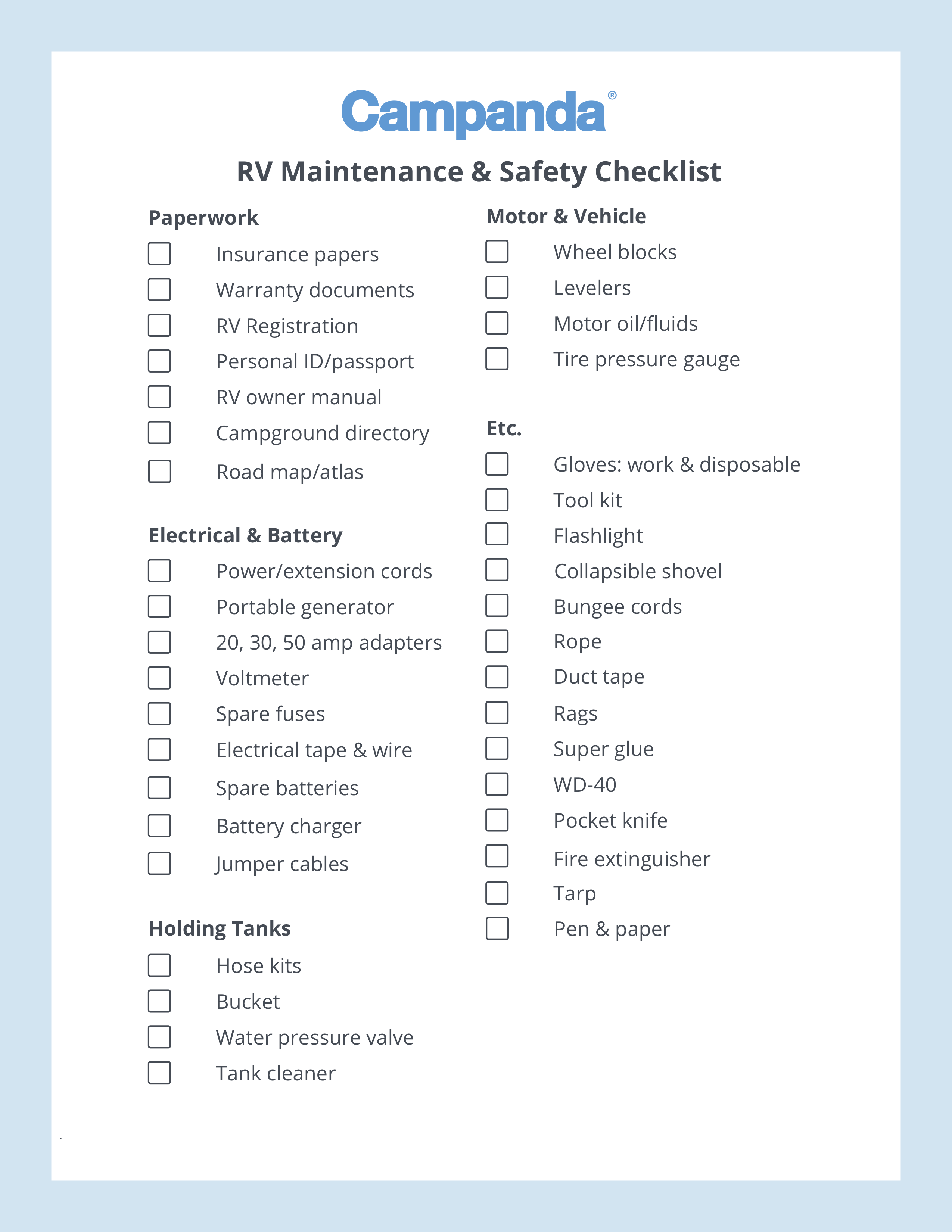
All RV Checklists
- Download RV Maintenance & Safety Checklist
- Download RV Camping Essentials Checklist
- Download RV Kitchen Checklist
- Download RV Grocery Checklist
- Download RV Bed & Bath Checklist
- Download Blank RV Checklist
Click Here To List Your RV
You May Also Like

This just in...
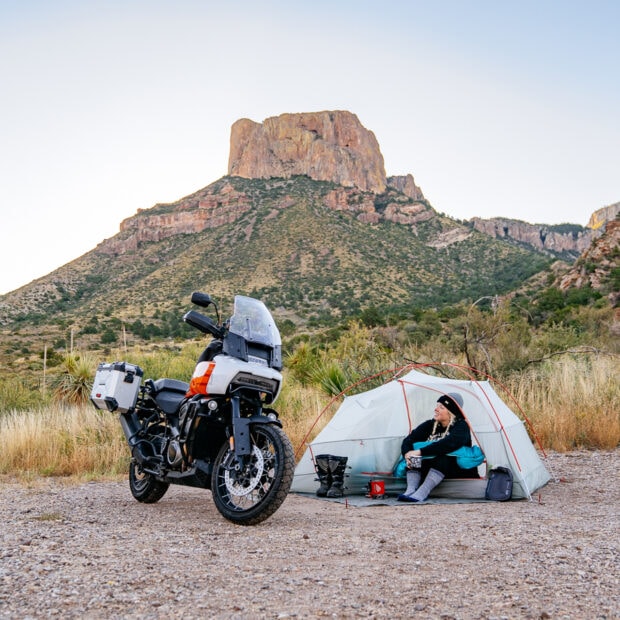
Camping checklist for your next trip
By Roadtrippers
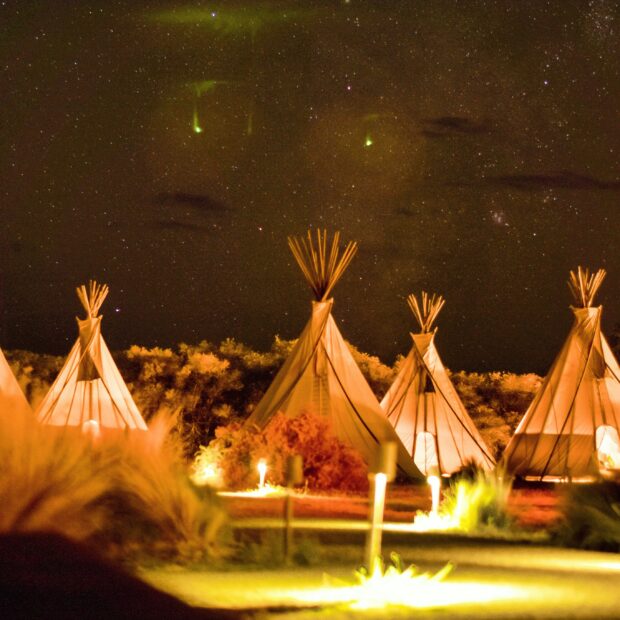
What is glamping? Your guide to luxury in the outdoors
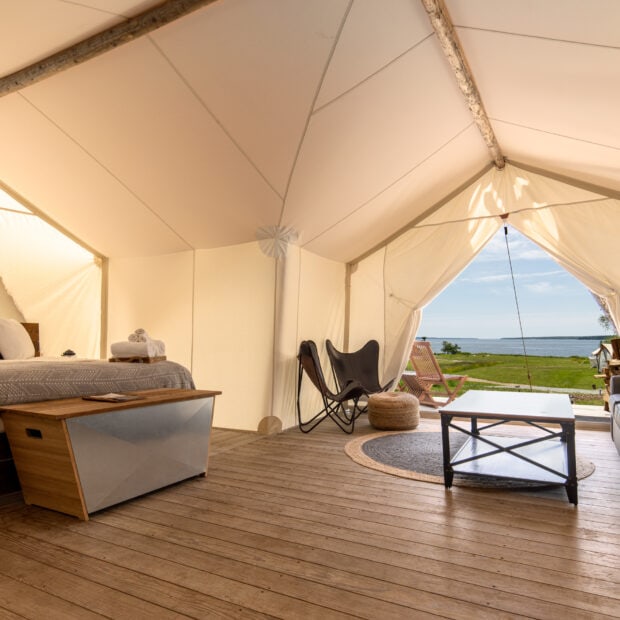
Unique ways to glamp: Airstreams, cabooses, teepees, and more
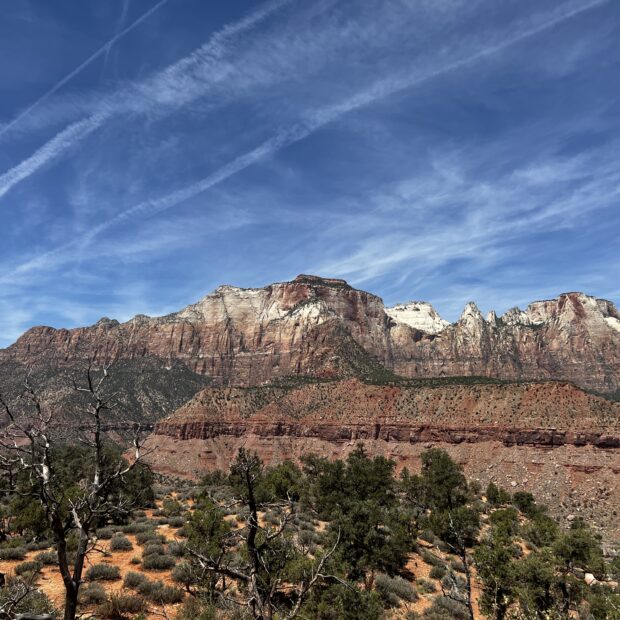
Free Camping Near Zion National Park
By Nathan Paul Swartz
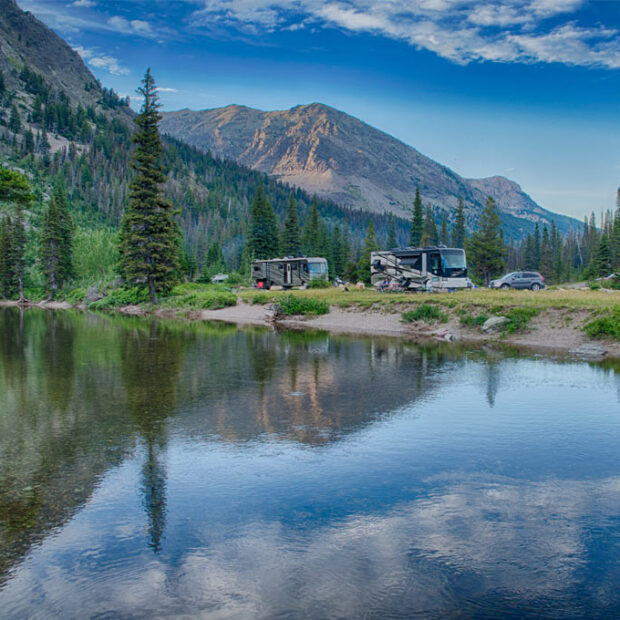
All the Best Camping in and Near Glacier National Park
By Sara Sheehy
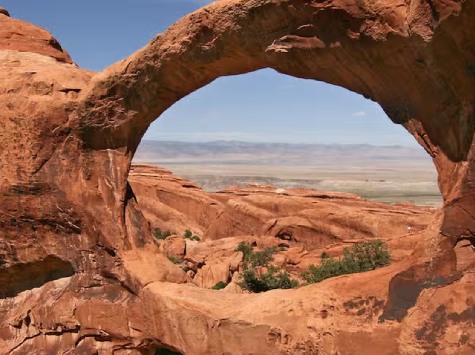
All the Best Camping Near Arches National Park
By Mitchell Reifenrath
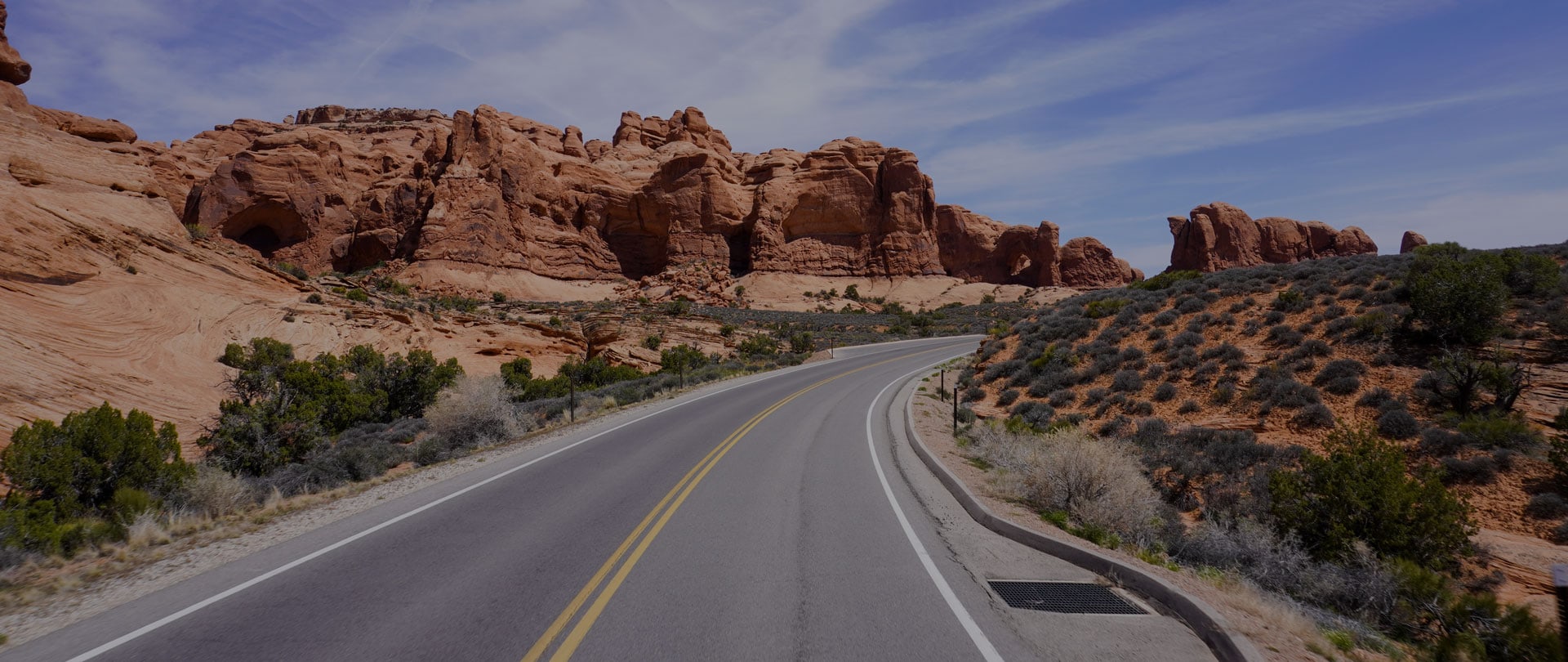
Plan a road trip
Everything you need to know to plan, prepare, and pack for a fun adventure—while still leaving room for spontaneous detours.

Itineraries and ideas for your next road trip
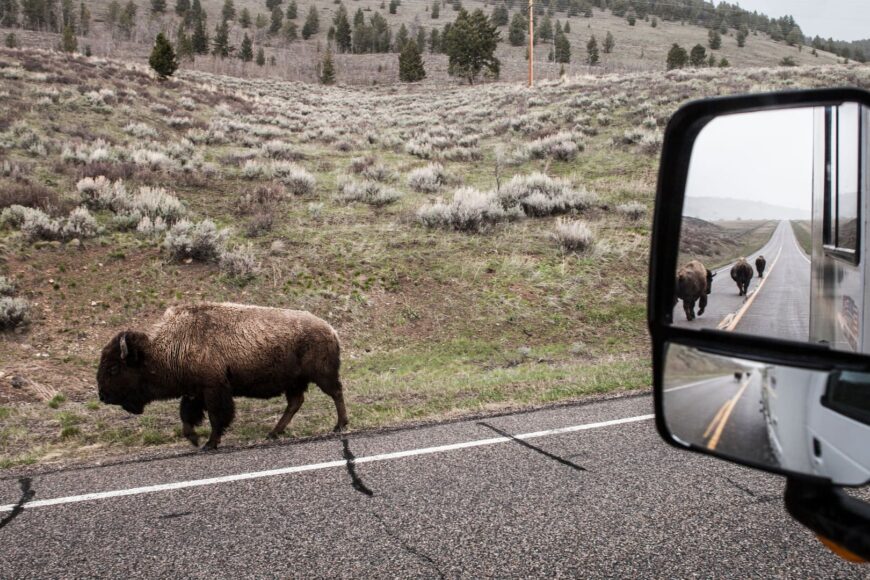
Tips for Planning a Yellowstone RV Trip
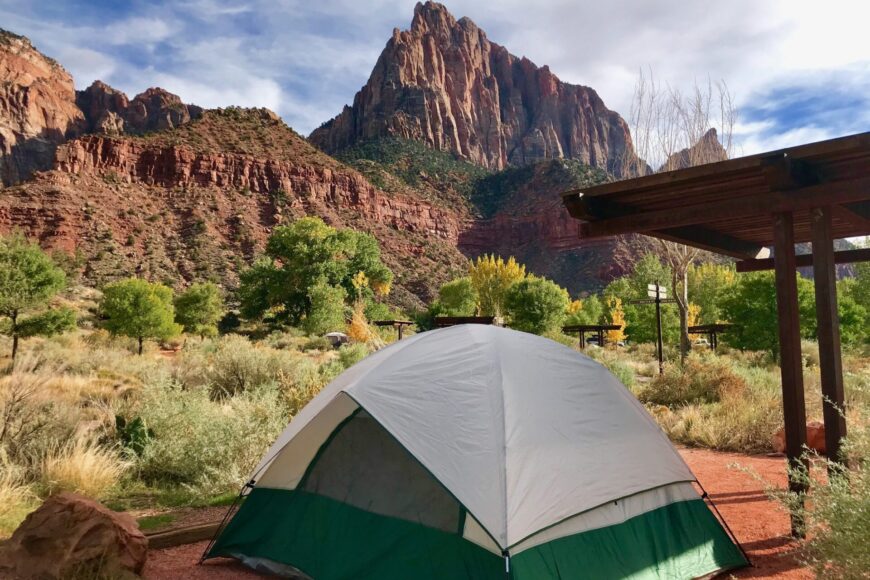
Where to find national park campgrounds with RV hookups
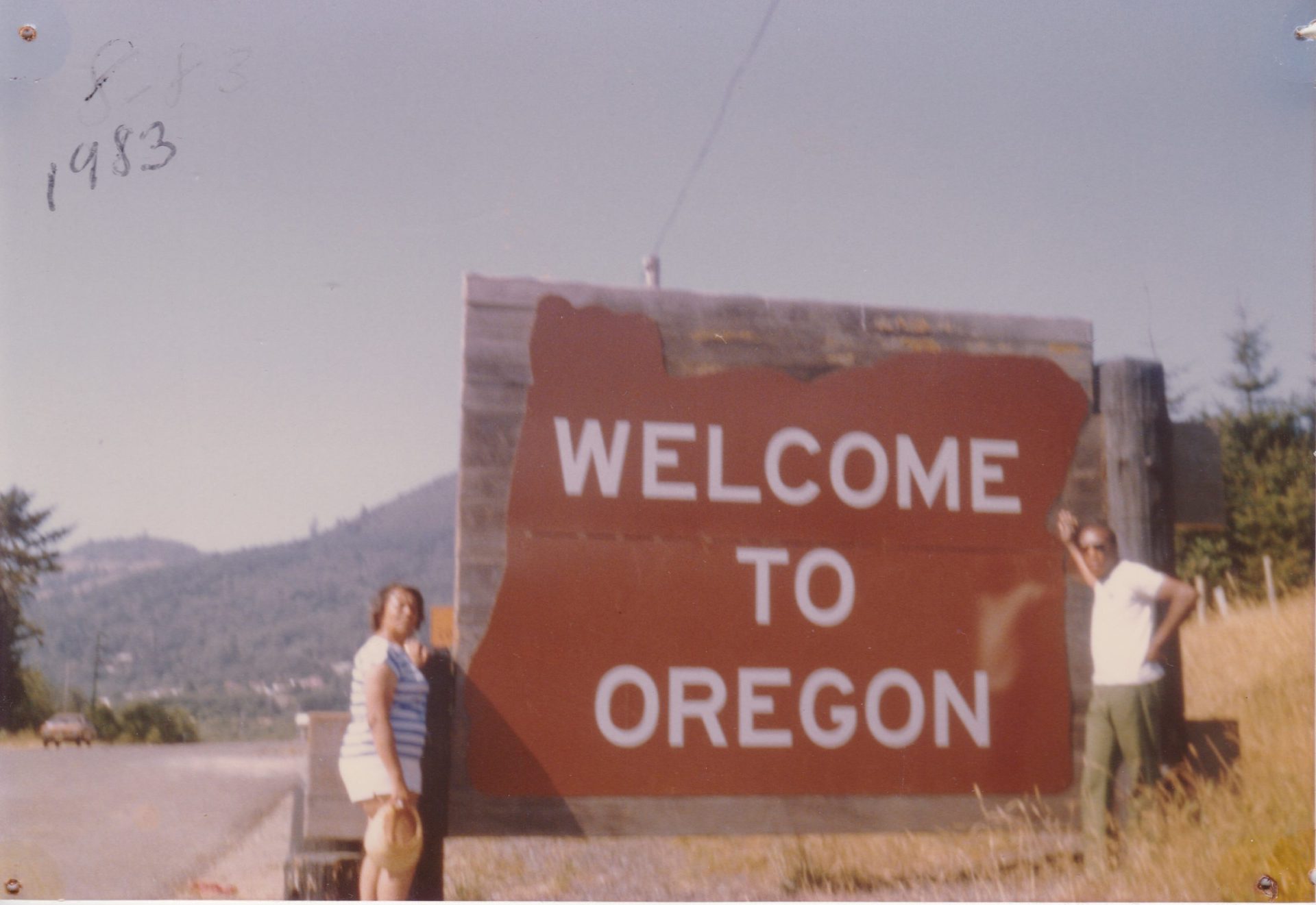
This Black couple spent 35 years traveling 96,000 miles by RV—now their granddaughter is sharing their story
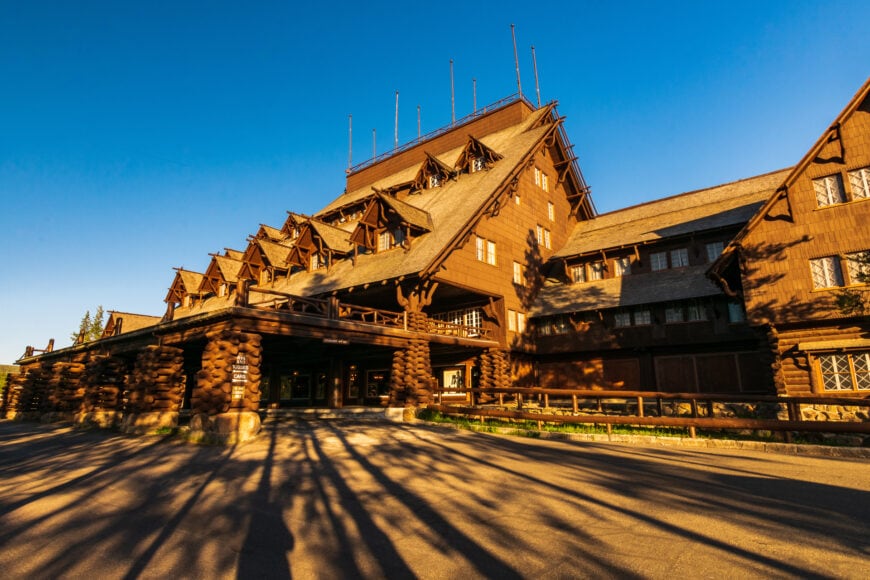
These 20 National Park Service lodges showcase ‘parkitecture’ at its finest
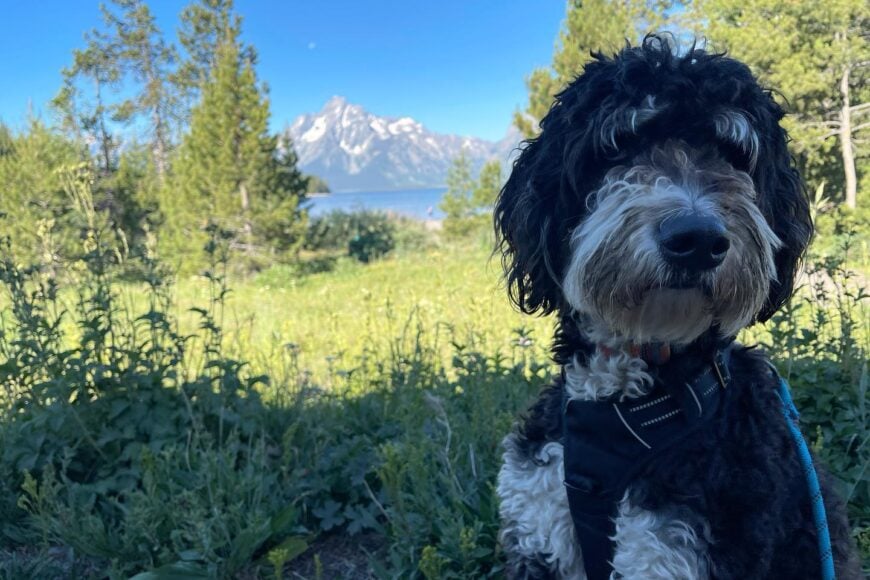
Your pup can be a BARK Ranger at these dog-friendly national parks
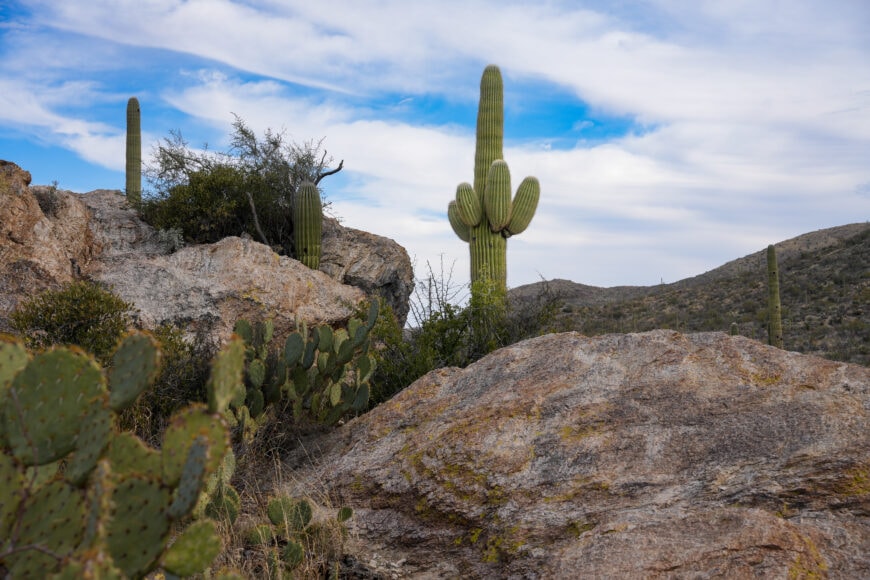
Video: Guide to Saguaro National Park
Extraordinary places.
Epic natural wonders, weird roadside attractions, and meaningful monuments

Monument Valley

Hearst Castle
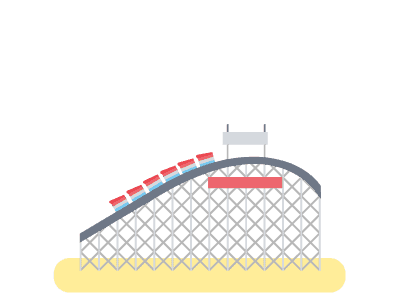
Coney Island

Blue Whale of Catoosa

Weeki Wachee Springs State Park
National parks.
With insider tips from real park rangers
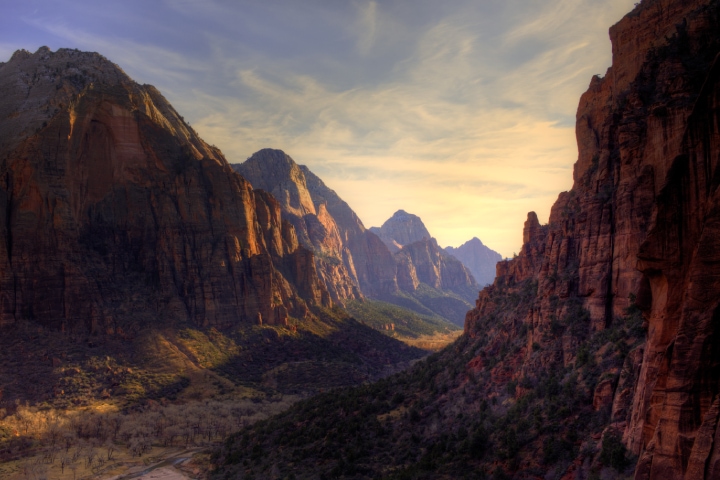
Zion National Park
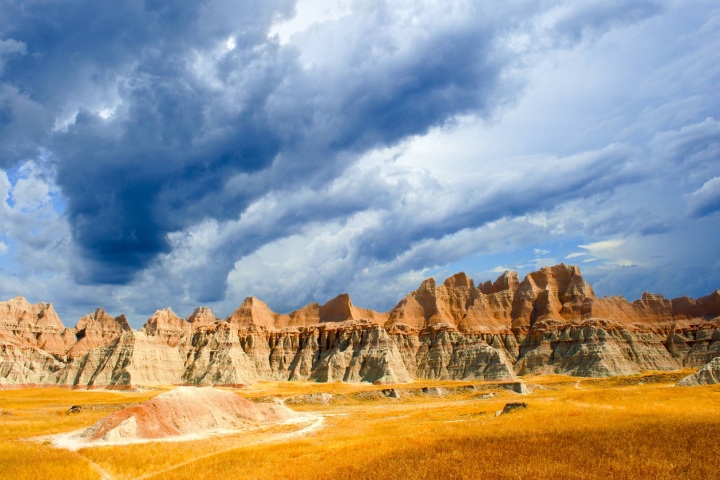
Badlands National Park
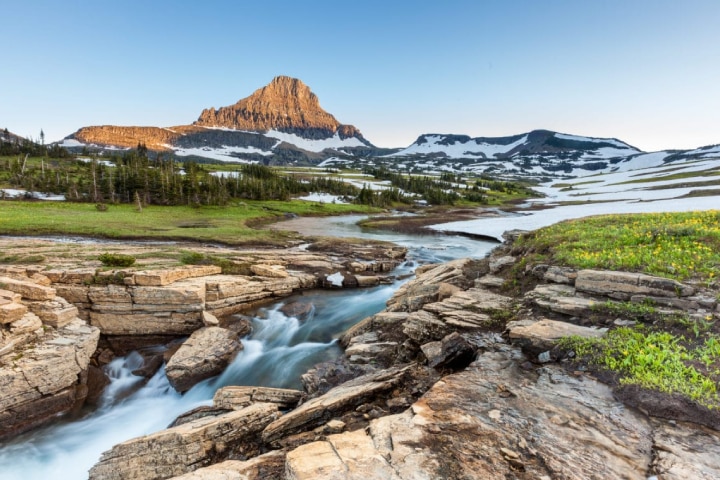
Glacier National Park
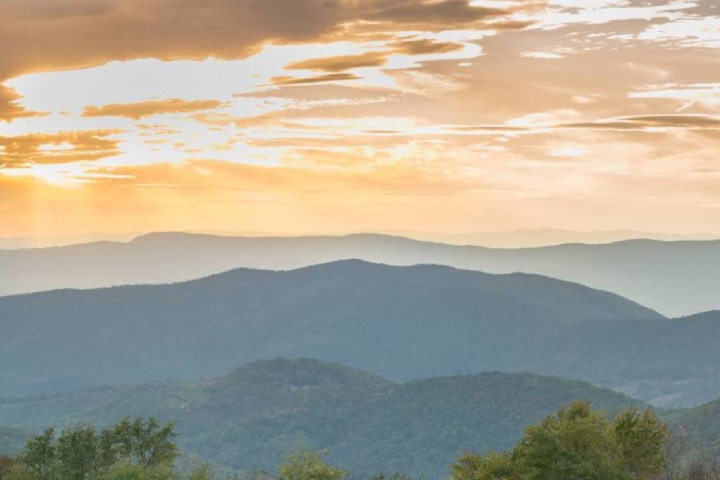
Shenandoah National Park
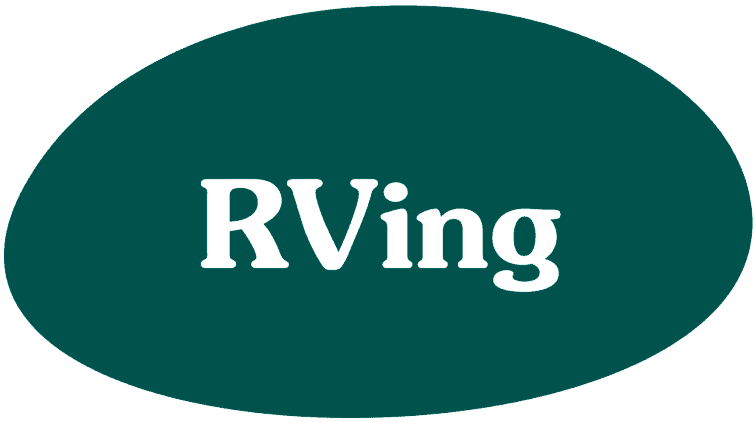
The latest on the RVing lifestyle, travel tips, and more
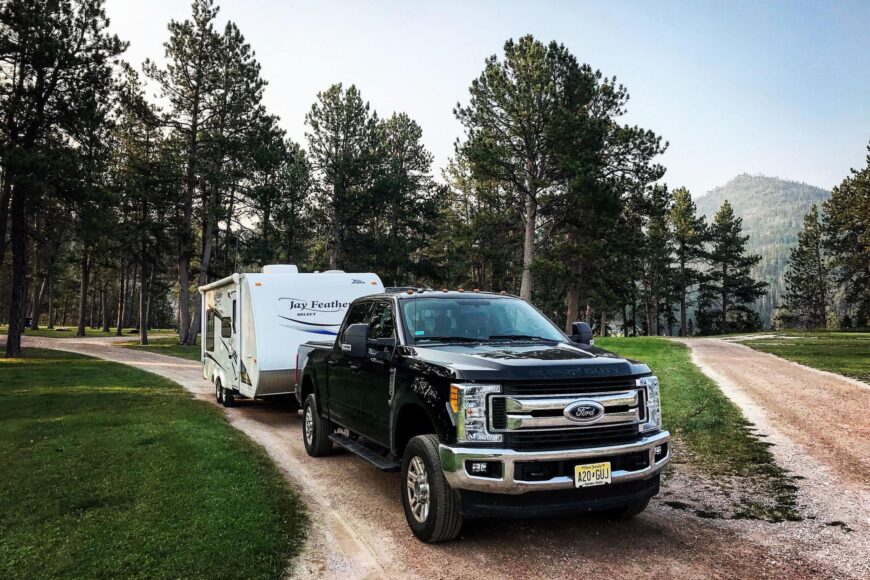
6 steps to planning a successful RV road trip
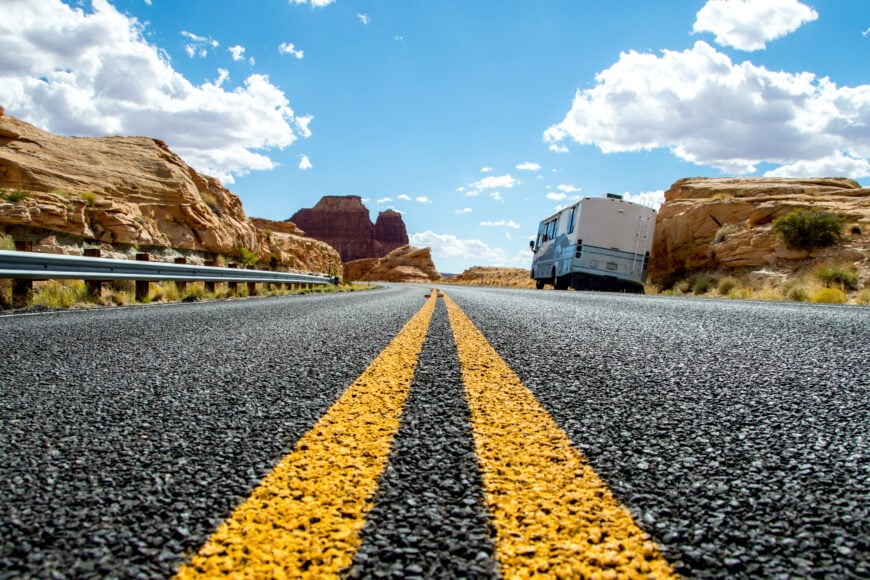
How to avoid dangerous roads in your RV
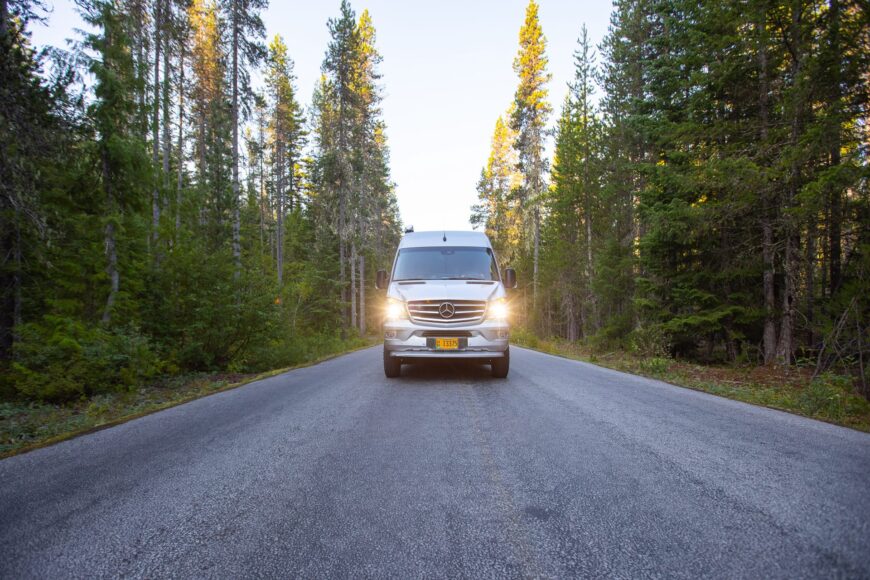
The best apps for planning a safe and fun RV route
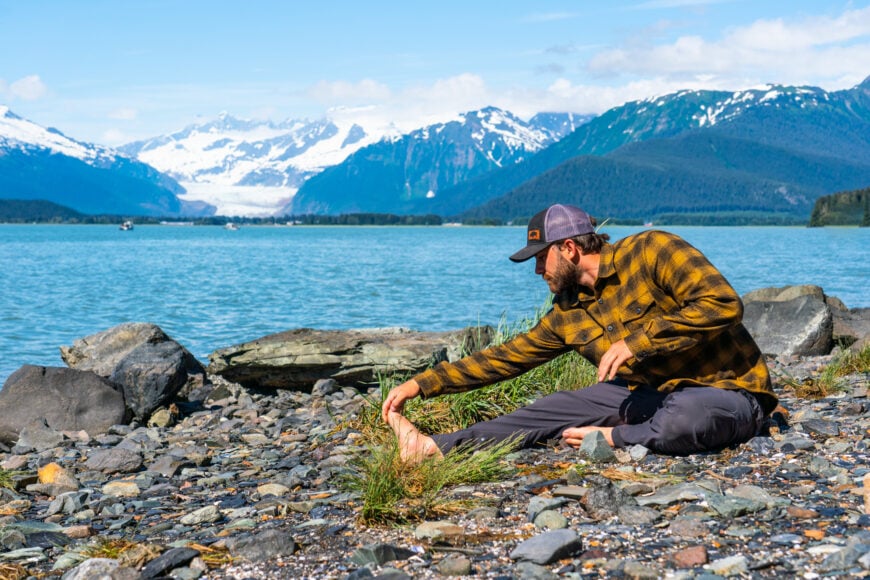
5 things I wish I knew before starting vanlife
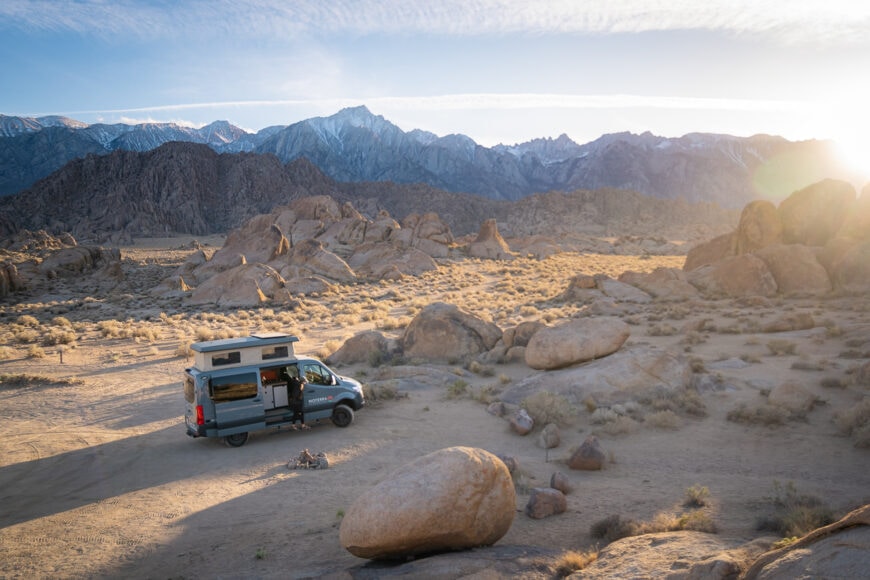
How to rent a campervan for your next road trip

Interesting destinations and road trip inspiration
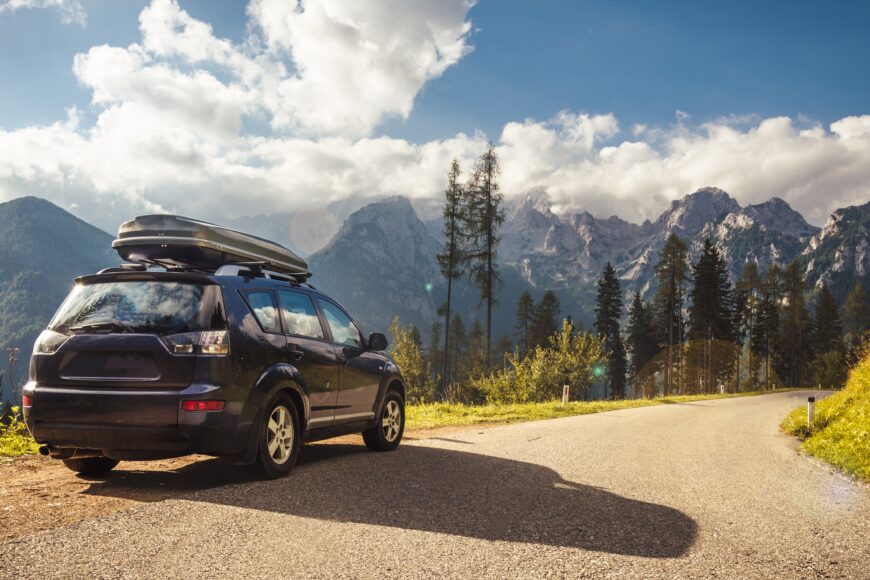
What’s the best roadside assistance?
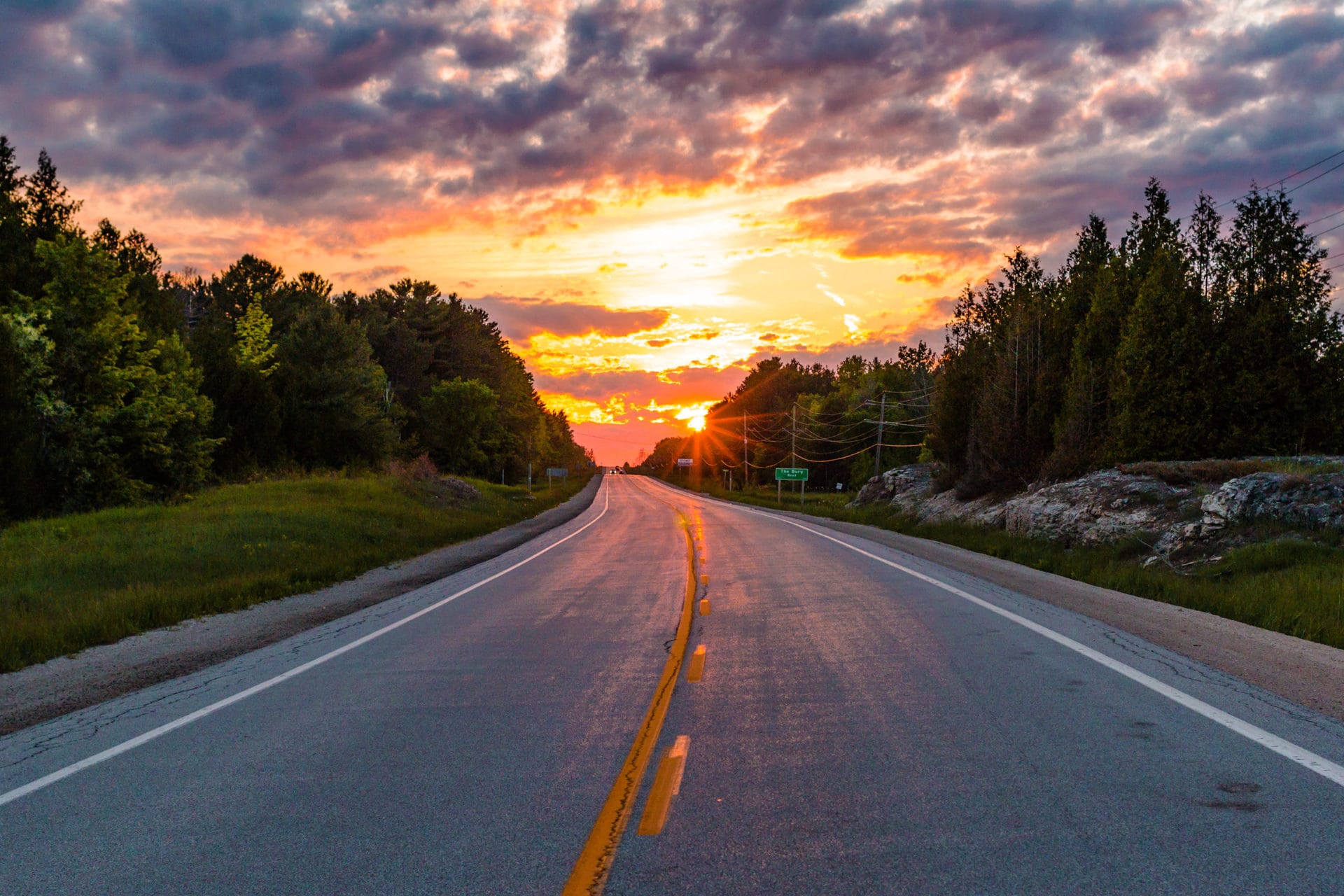
Happy National Road Trip Day: Here’s where the Roadtrippers team has traveled
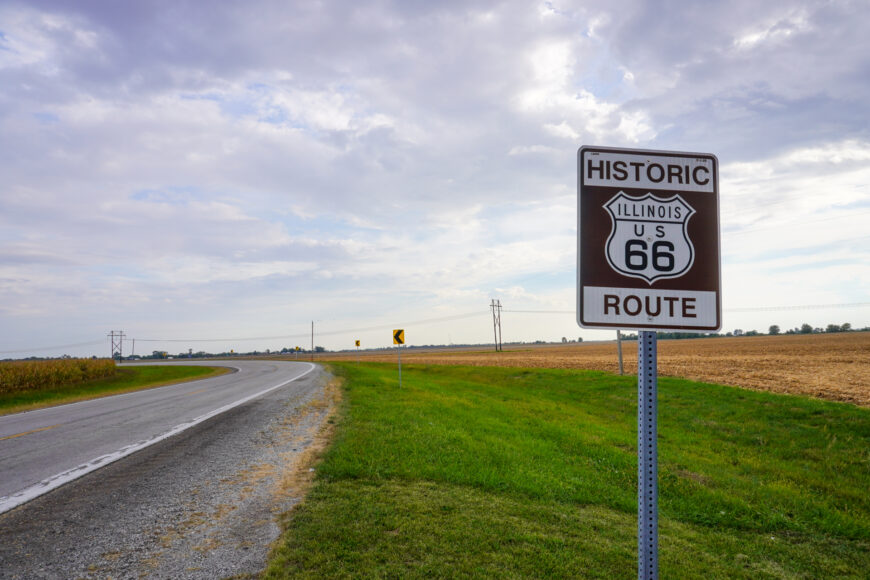
Route 66 goes electric: Meet the people and initiatives bringing the Mother Road into the future
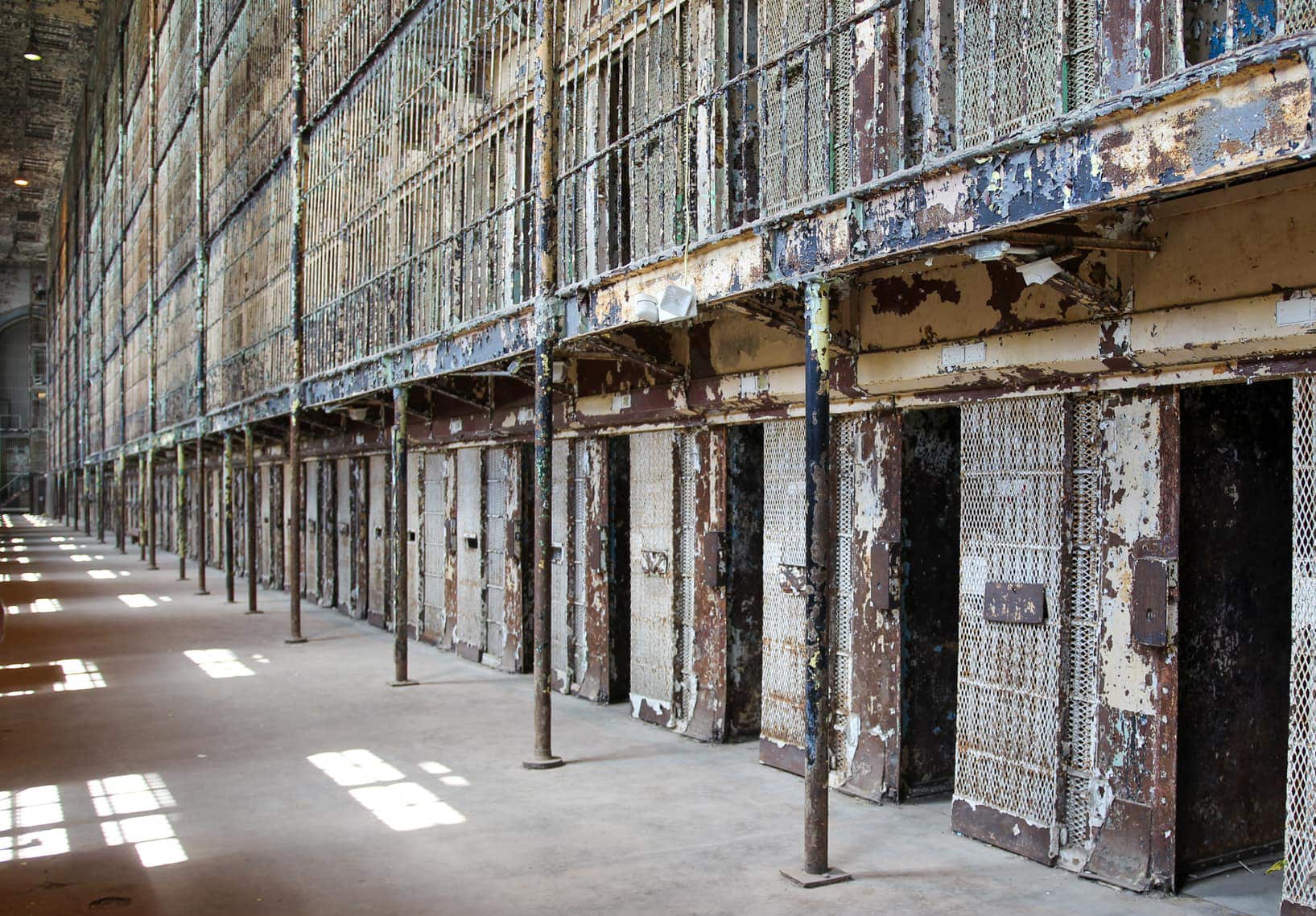
30 years after ‘Shawshank Redemption,’ fans still flock to the Ohio State Reformatory

The shoe must go on: After one owner’s sudden passing, the Haines Shoe House changes ownership

Here’s where to find the best neon signs across the U.S.
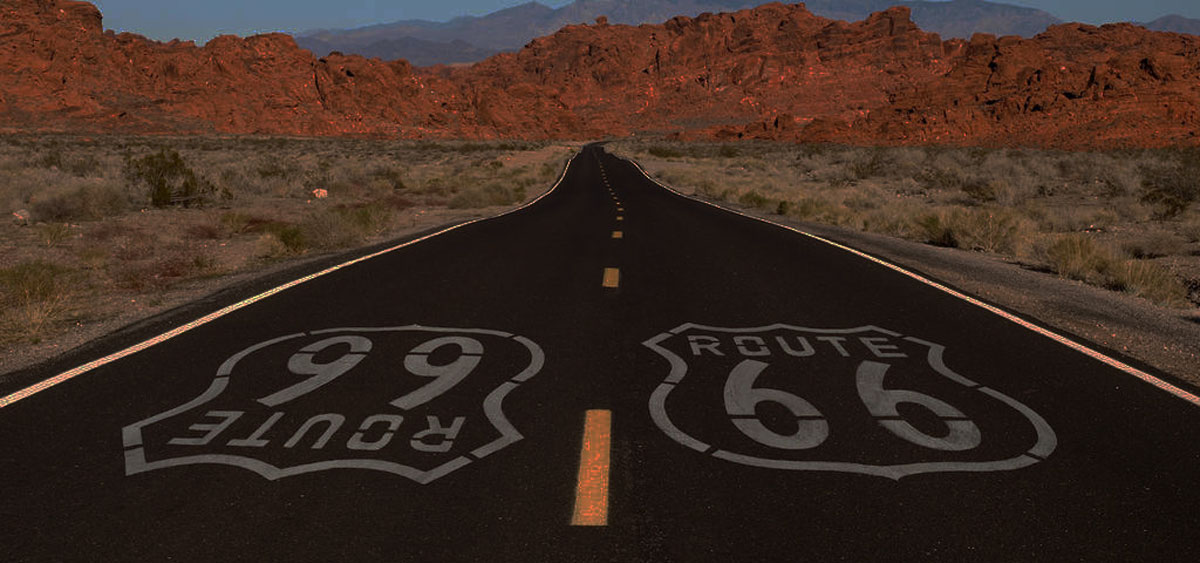
From flashy neon to roadside kitsch, here’s everything you need to know about the Mother Road, complete with interactive maps.

National parks, hiking, and outdoor adventures
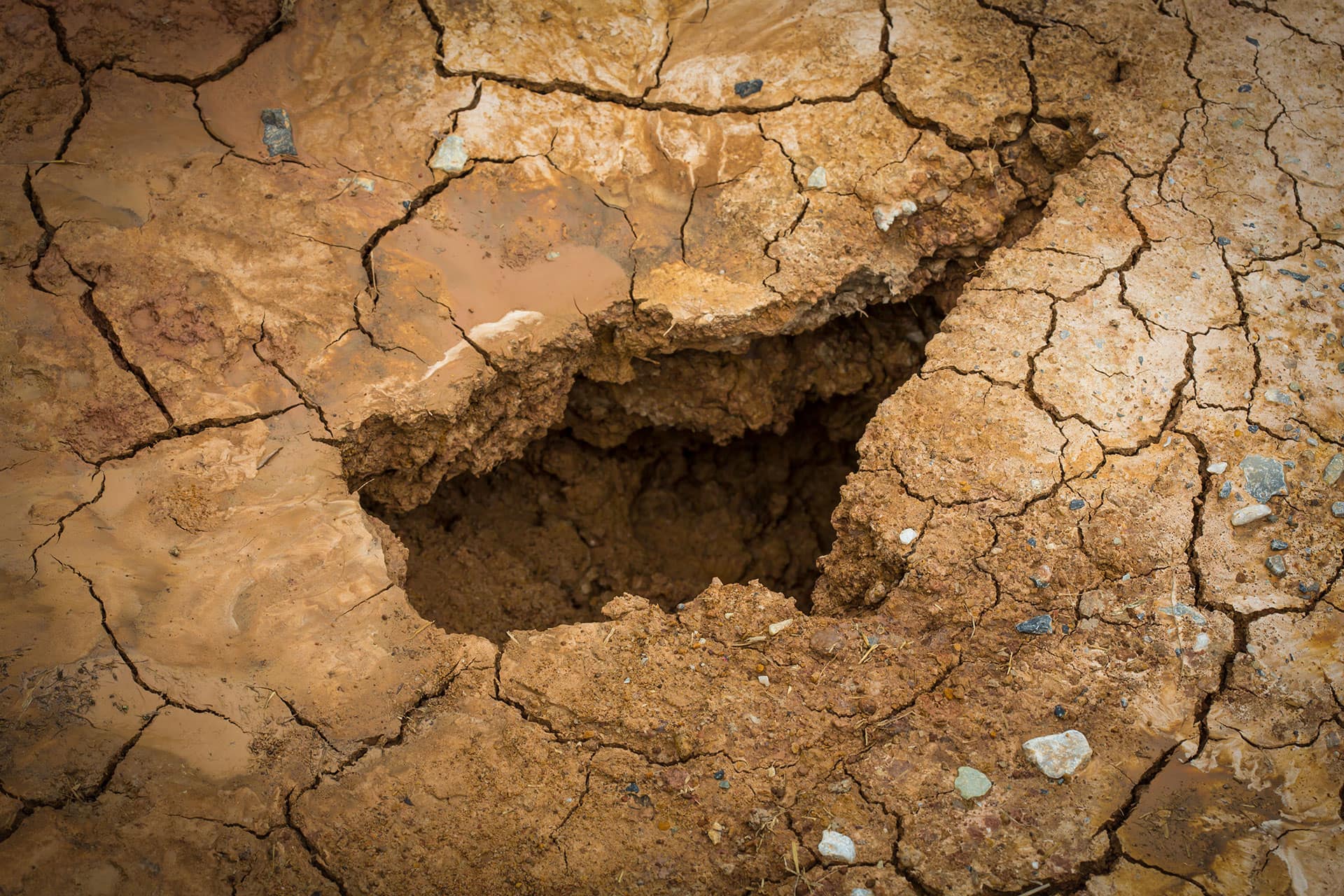
Nature is calling: Here’s how to poop properly in the great outdoors
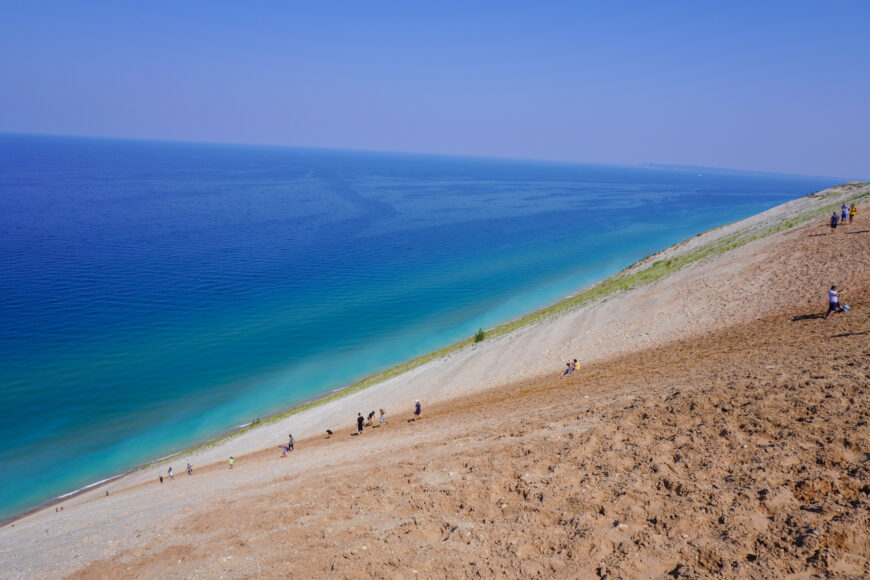
A guide to all 3 national lakeshores in the U.S.
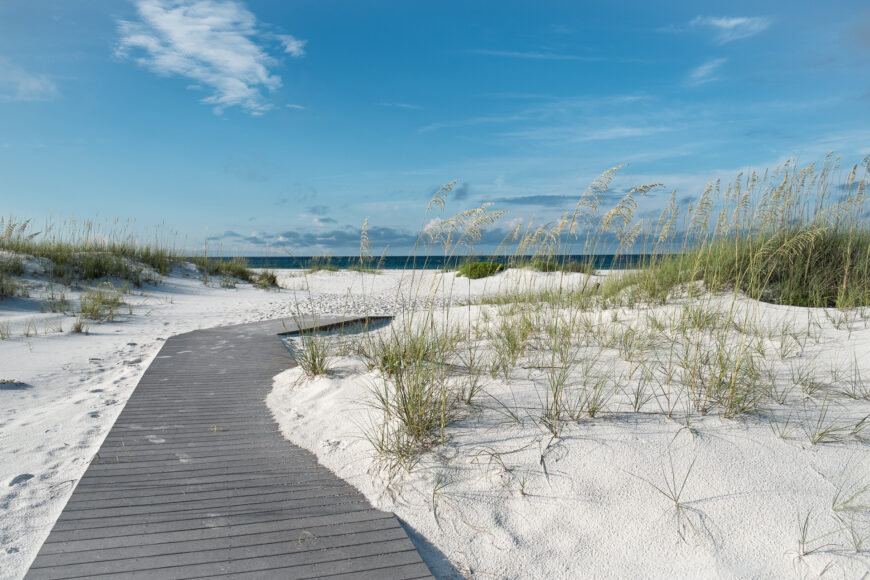
A guide to all 10 national seashores in the U.S.
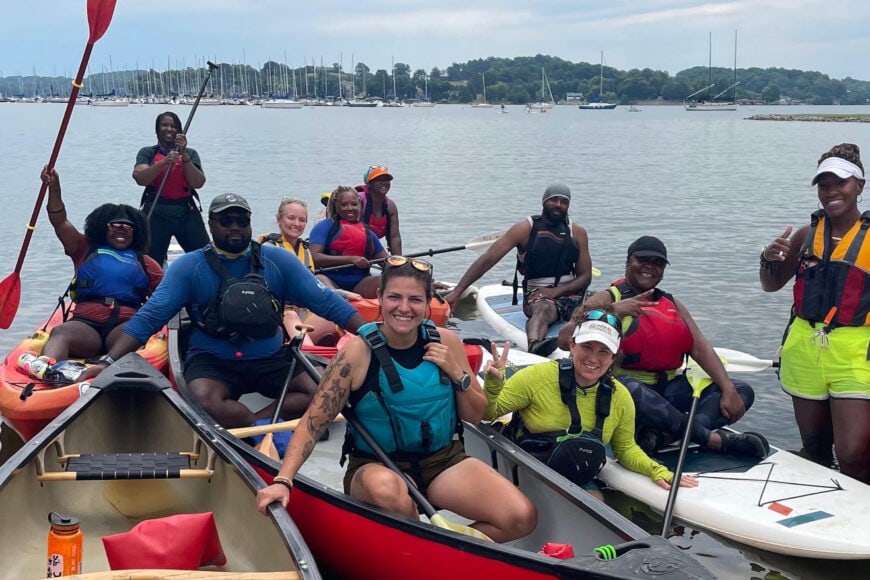
How to make the outdoors great for everyone
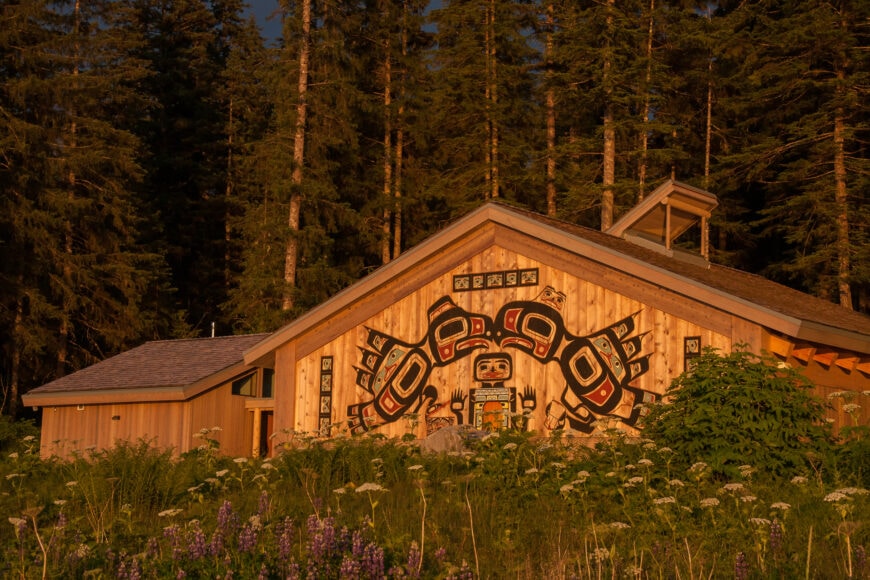
These national park sites work with local tribes to recognize Indigenous history and culture
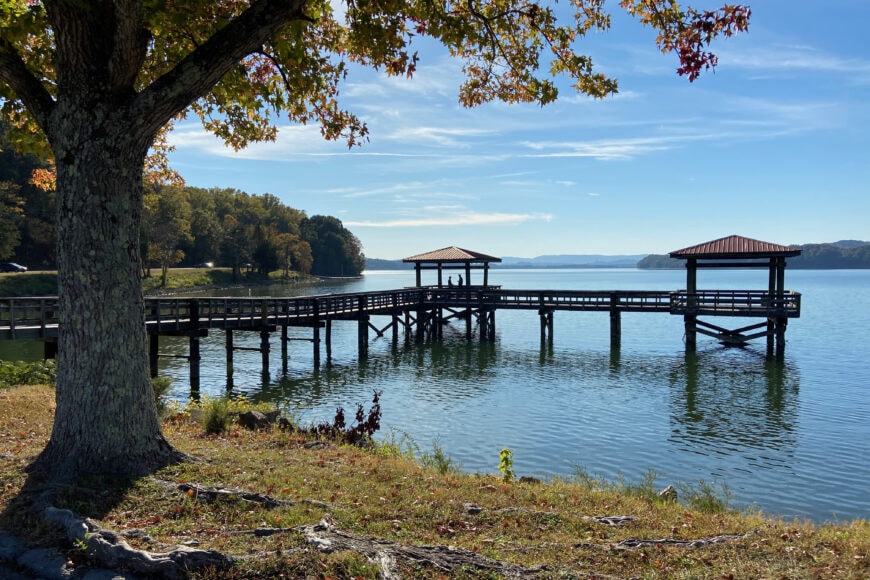
These formerly segregated state parks feature beautiful scenery and Black history
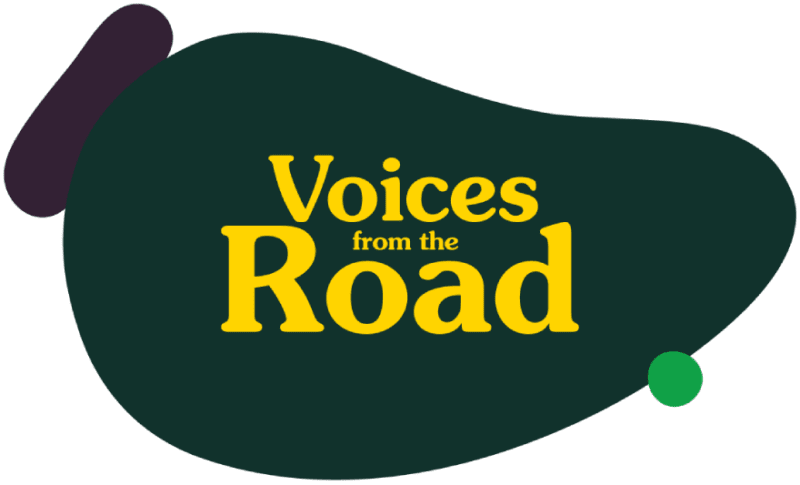
Real stories from real road trips
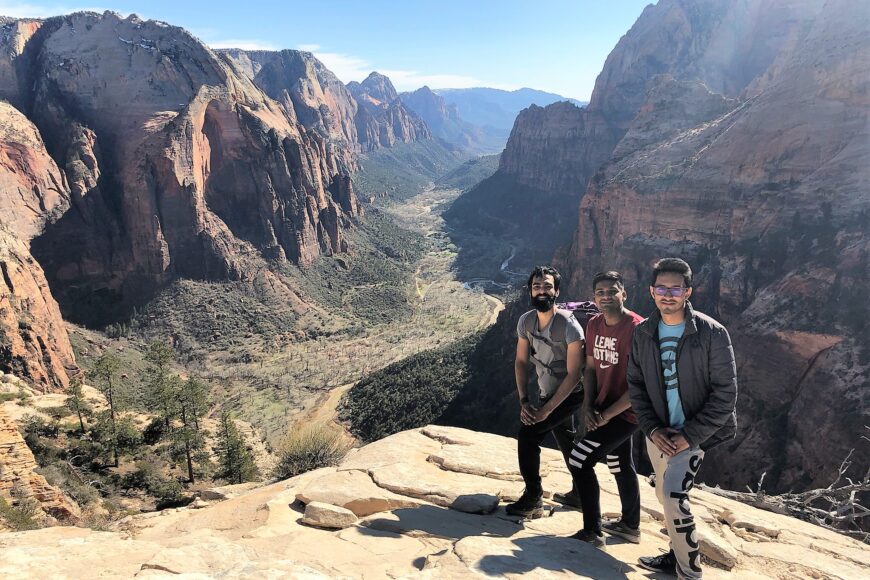
The road to Holi: Driving 800 miles to celebrate the festival of colors

A month and a minivan: My 8,000-mile summer road trip

How I spent last summer driving across the country to shoot a documentary about bookstores
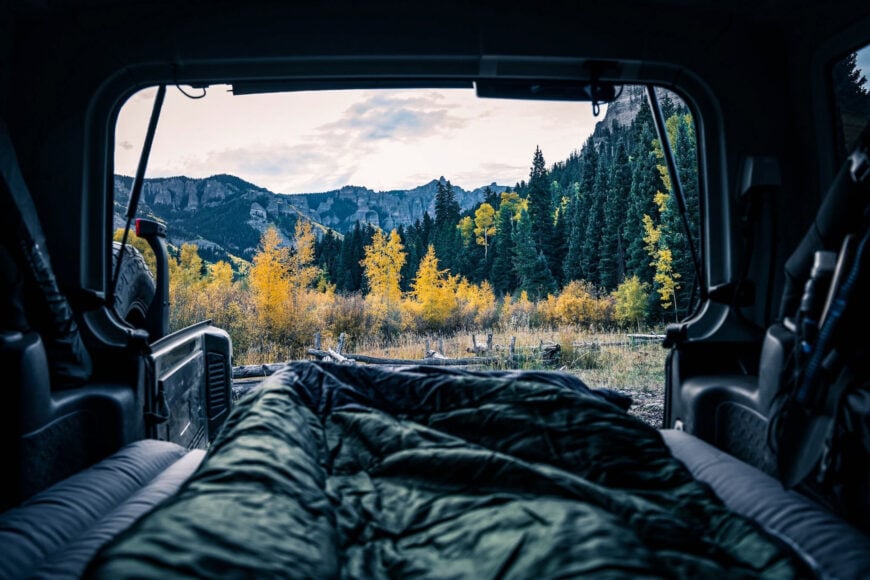
Embracing the unexpected: A leaf-peeping road trip from Georgia to Colorado
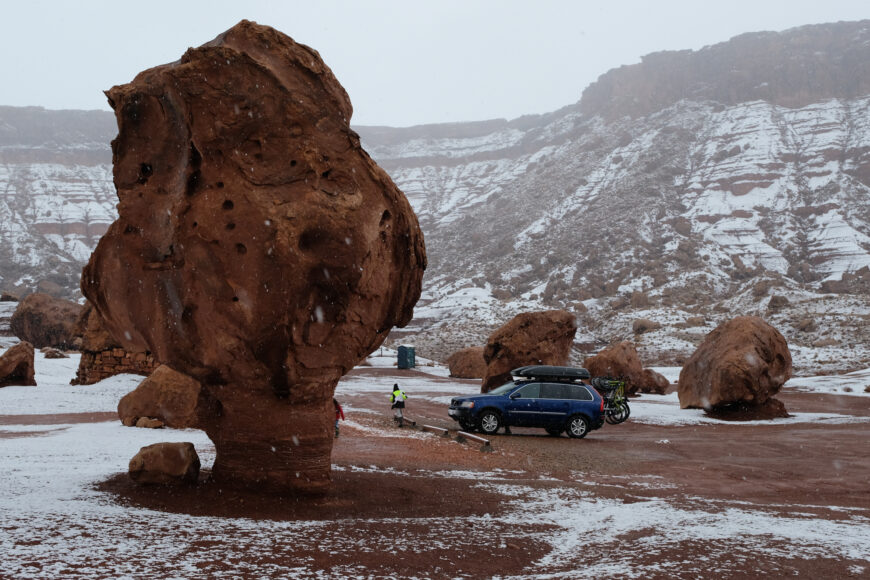
Retracing our newlywed road trip 15 years later with a bigger car, 3 kids, and a lot more snow
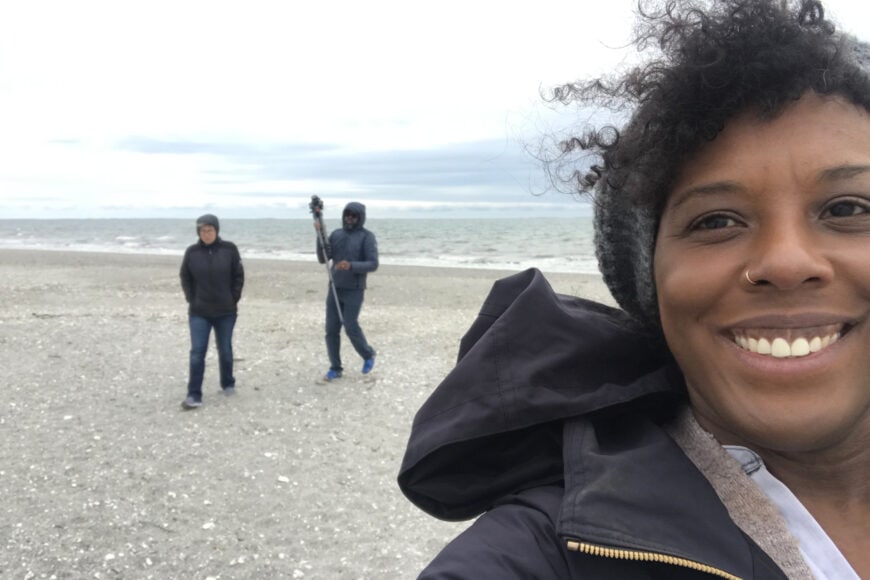
From Maryland to Maine: Retracing my grandparents’ first road trip
Get the most inspiring stories from the road sent directly to your inbox..

More stories
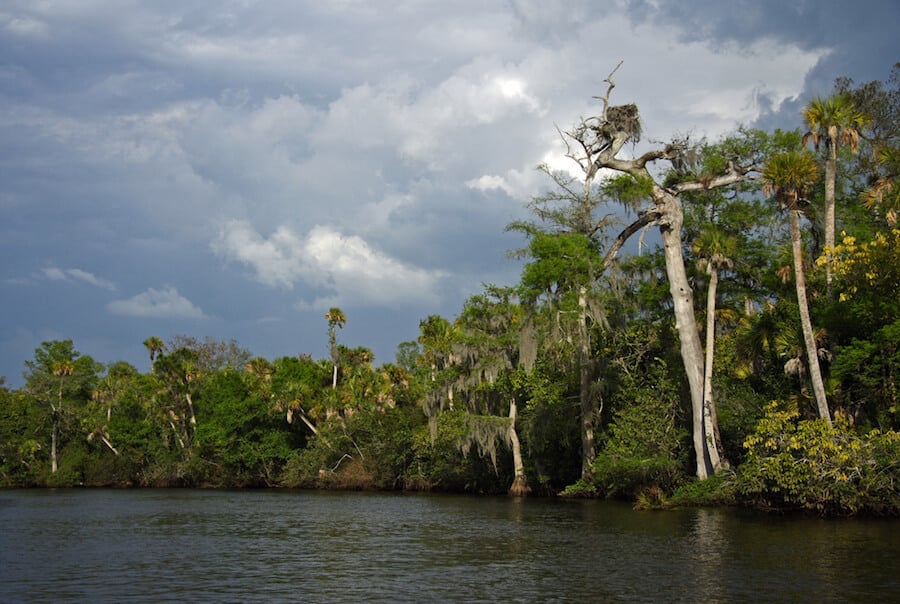
The Complete Guide to Free Camping in Florida’s Water Management Districts
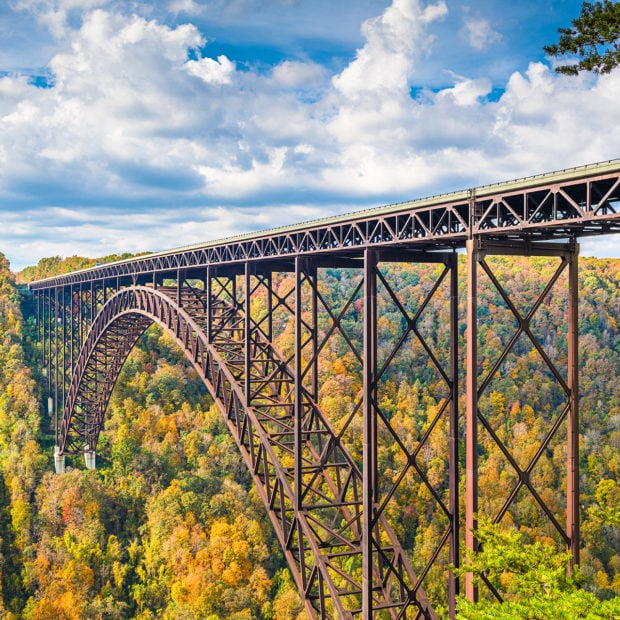
A Campers Guide to The Newest National Park – New River Gorge

The 8 Best Tucson RV Parks

Try this travel inspiration app for your next roadtrip

Road trip essentials: How and what to pack for your road trip
By Britany Robinson & Roadtrippers
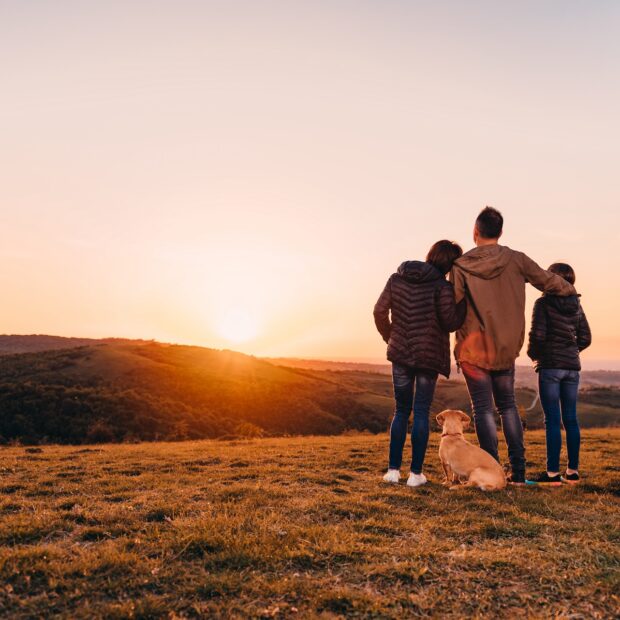
Ideas for dog friendly road trips
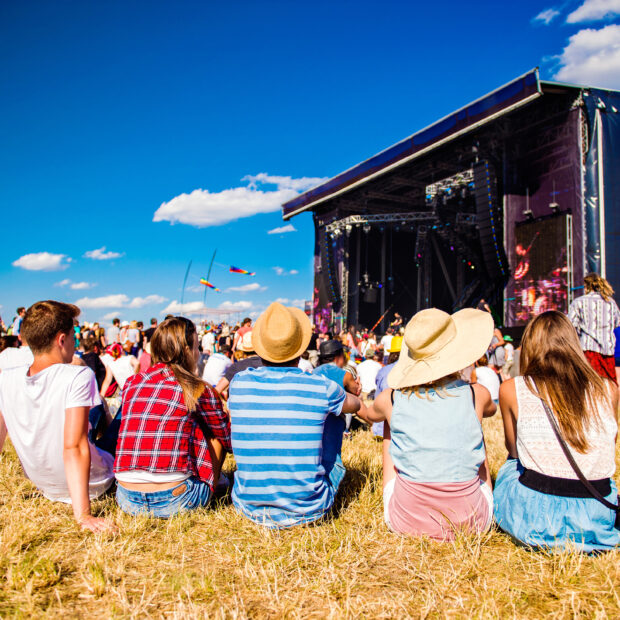
The best festivals in the U.S.
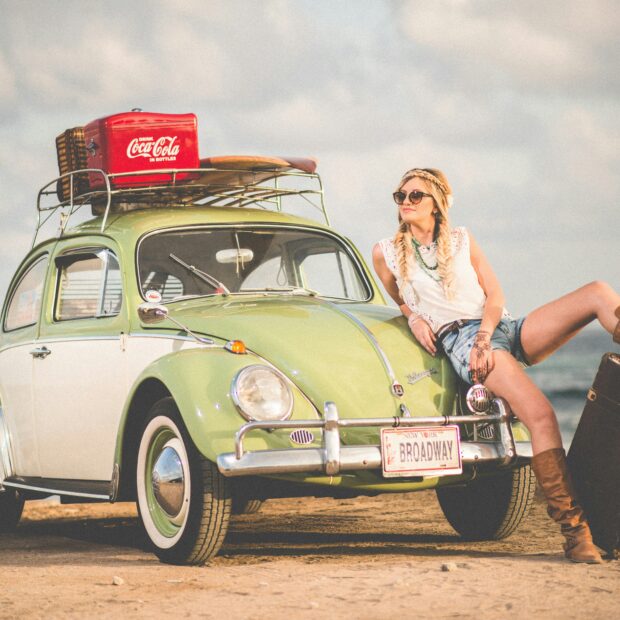
What’s the Best AI Trip Planner?
- Trip guides
- Trip Planner
- Sign up Log in Sign out
- Log in Sign out
- ROADTRIPPERS MEMBERSHIP
- RV RESOURCES
Plan your journey, find amazing places, and take fascinating detours with our app.
If you used to sign in with Roadpass, you should now use the same username and password to log in directly with Roadtrippers above.
We couldn't find an existing Roadtrippers account using that service. Please try signing in with another option.
We need your email address to send you trip itineraries and other updates.
How do you want to plan your trip?
With just a few questions, our newest Premium feature, Autopilot, will plan your next adventure.


Hacks That'll Make Hooking Up Your RV Trailer Even Easier
H ooking up your RV trailer at the start of your vacation, and unhitching it at the end, should be a hassle-free experience. There are a few hacks to help make the process smoother and less stressful, like tips for connecting your RV trailer to your tow vehicle, connecting your RV to power, and marking your hitching point. Knowing your RV inside and out is crucial to planning the most successful RV trip.
Before hitching up your RV trailer, it's best to be well-prepared. Create a comprehensive checklist of items and tasks to ensure you don't overlook anything important. Safety gear should include your roadside emergency kit with flashlights, a fire extinguisher, and more. When it comes to the hitch and tow vehicle, ensure the hitch is clean and lubricated and that the tow vehicle's tires, brakes, and lights are in perfect working order when connected to the RV trailer. Take the time to check the water, propane, and electrical systems for any leaks or issues.
Using a checklist eliminates the chance of overlooking essential tasks and items, reduces the stress of preparation, and helps you hit the road with peace of mind. Checking that you have all of your RV hookup equipment, like chock blocks, levelers, and a basic tool kit, will also come in handy for a fast and easy setup. When it comes to hooking up your RV trailer, it's essential to know the proper techniques as well as these few time-saving hacks.
Read more: The 75 Top RV Parks In America With The Most Amenities
Combine Chock And Leveling Blocks
One of the first challenges you face when hooking up your RV trailer is preventing it from rolling or shifting, which should always be done before disconnecting your tow vehicle. If you can arrive at your site before dark , the light will allow you to see potential slopes and level your RV more easily. When on a level grade, place two chock blocks in front and behind a tire. This ensures your RV stays securely in place, even on uneven terrain. Invest in high-quality chock blocks made from durable materials like rubber or urethane, as they last longer in the elements and provide a better grip.
Parking on a level surface is ideal, but if that's not possible, use leveling blocks to even out the ground beneath your tires. Doing so will prevent your RV from tilting or leaning to one side, making it less stable during your stay. To combine the two tools, place the leveling blocks in front of and behind the tires, then chock the wheels on both sides.
Curved leveling and chock combinations are also available to purchase. These designs conform to the shape of your tires, provide a tighter grip, and include a chock and leveling block in one system. Regardless of what you use, it is important to regularly inspect and replace chock blocks that show wear and tear so they continue to provide optimal stability for your RV.
Mark The Height Of Your Tongue Jack With A Carabiner
Once you chock and begin to level your RV, you'll likely lower the tongue jack to ensure stability. But when it's time to pack up and head out, you may have to spend additional time trying to raise it back to the correct height. Avoid this hassle by marking the ideal height on your tongue jack using a carabiner.
After raising your tongue jack to unhook your tow vehicle, extend one of the safety chains to the ground and attach a carabiner to that link. Your setup will involve adjusting the height of your tongue jack to level and stabilize your RV. With the height marked, you can easily and accurately reposition your tongue jack to the correct height in seconds without any guessing or testing.
When it comes time to hook it up to leave, simply adjust the tongue jack's height until the carabiner is off the ground. You'll be able to back up and hook it onto your tow vehicle in a fraction of the time. This will save you time and effort when it is finally time to pack up and leave, and you're dreading the laundry list of things to do before heading home.
Invest In A Backup Camera
One of the most significant challenges when hooking up your RV trailer is ensuring a seamless alignment between your hitch and the trailer's coupler. You can mark the height of the tongue, but without a spotter or backup camera, you're still relying on guesswork to get the angle right. Investing in a backup camera will make hitching up your RV trailer much more manageable.
Your tow vehicle may come equipped with a backup camera or backup assistance; but if not, there are plenty of aftermarket cameras to choose from. Backup cameras are available in various styles, from wireless options to those that integrate into your existing display. They save you time and eliminate the frustration of repeated trial and error while parking or hitching up your RV trailer.
These cameras are mounted on the rear of your tow vehicle or RV, depending on which you choose, and display a live feed on your dashboard. Cameras mounted to tow vehicles make it easy to align your hitch and coupler accurately, and cameras mounted to the rear of your RV make it easier to back into your camping spot to hook up your RV. Not only does this save time and frustration during the hookup process, but it also improves safety by reducing the chances of damaging your vehicle or RV due to improper alignment.
Use A Cordless Drill For Stabilizers And Leveling Jacks
Stabilizing and leveling your RV trailer is a vital part of the setup process. It can also be physically demanding if you manually operate jacks and stabilizers. A cordless drill with the appropriate attachment can make this task significantly easier and faster. You'll be able to raise and lower jacks and stabilize your trailer with minimal effort, allowing you to start enjoying your destination sooner.
Impact drills are preferred for this task due to their increased power and torque. However, if you don't have an impact drill, a regular cordless drill will still do the job. Just be wary of the potential damage to the motor if you frequently use it for this task. When using a cordless drill, make sure it's fully charged before starting. It's also essential to have the correct attachment that fits your jacks and stabilizers securely.
When you're parked on soft or uneven surfaces, your RV's stabilizing jacks can sink into the ground and cause damage to both your RV and the surface underneath. Jack pads distribute your RV's weight more evenly and prevent this from happening, and they'll ensure safety when using your drill to raise the stabilizers. Jack pads come in various shapes and sizes, including stackable options. Keep them stored near your leveling blocks for easy access when needed.
Use The Right Surge Protector
Once your RV is stabilized, it is time to hook your RV up to an external power source. Using a surge protector is a must to protect your RV's electrical system from any sudden power surges or low voltage. These devices protect your electrical system from surges and power spikes that can cause damage. Regularly check the condition of your surge protector and power cord to avoid potential safety hazards. Testing the RV site pedestal can be a simple step many RV users miss. Bring along a multimeter to test the voltage of the pedestal for abnormally high or low readings.
Most RV sites use a 30- or 50-amp power supply, as smaller RVs typically have a 30-amp plug, while larger, more luxurious models may require a 50-amp plug. The key difference in the amperage of your electrical system is the number of prongs on your plug. 30-amp plugs have three prongs, and 50-amp plugs have four. Getting a surge protector that matches your RV's amperage is crucial. If not, it could cause electrical failures and potential damage.
Adapters can also be used if needed, but it's important to use the correct adapter for your specific RV and power source. Additionally, always carry a backup generator with you in case of emergency power outages or sites without external power sources. Carrying a heavy-duty, RV-specific power extension cord is also a must in case the power source is farther away from your RV.
Read the original article on Explore .


IMAGES
VIDEO
COMMENTS
After connecting the surge protector to the panel to ensure the proper lights, turn the panel off and connect the power cord to your RV. Then turn the panel back on. Putting the filter on the RV side may filter any bacteria in the hose from sitting in the sun. I used to have a 90 degree elbow to connect the water and put less strain on the RV ...
Level RV: Use leveling blocks or your RV's built-in leveling system to ensure a stable and even living area. Connect to Shore Power: Plug in your electrical cord to the site's power supply to run your RV's electrical systems. Connect Water Lines: Hook up your water lines to access fresh water. Connect Sewer Hose: Attach your sewer hose to ...
For most trailers, this means that 60% of the weight should be in the front half of the RV and about 10% of this weight should be on or near the tongue of the trailer. Because of this fact, you need to be careful where you put your gear and other items. For example, many people store their batteries and propane tanks on the tongue of their camper.
Connect a surge protector and your electrical cord to shore power. Use the appropriate surge protector, electrical cord, and/or adapter for your RV's electrical system. Check that the breaker on the power pedestal is turned on for your 30 or 50-amp outlet. Attach a potable drinking water hose, water pressure regulator, and water filter.
Here are just a few of the items on our checklist: Plug Surge Protector into pedestal watch for E-0 code. Wait for RV level. Turn pedestal breaker on. Plug in the power cord. Verify jacks are down. Observe opening slides. Check slide seals are not tucked in slide. Disconnecting the Sewer Hose during Break Down.
10. Roll Out Your Awning. Now that your RV is level, it's time to roll out the awning. If you have an electric awning, extend it all the way. If you have a manual awning, extend it about halfway. Make sure the awning is locked in place and that the arms are secured. If you have an awning topper, put it on now.
Here are the steps to follow: 1. Position the tow vehicle . Align the tow vehicle to your trailer and check that the trailer jack is high enough so the ball can slide under the trailer tongue with enough clearance when you back the tow vehicle up. Back the tow vehicle up and position it so the ball is right under the trailer coupler.
This comprehensive article will serve as a beginner's checklist, providing valuable dos and don'ts for a successful RV hookup experience. From essential equipment to safety precautions, maintenance tips, and an exploration of different hookup types, this guide will equip you with the knowledge necessary to confidently navigate the world of RV hookups.
Pre-Departure Checklist. Exterior. Check all fluids (coolant, electrolyte, hydraulic, oil, power steering, transmission, windshield washer) Check generator oil level. Disconnect city water, if applicable. Reset coach's freshwater controls to onboard water, if applicable. Fill coach freshwater tank ( add a capful of bleach ), then stow the hose.
Use a printable RV & Travel Trailer setup checklist to help you setup in a fast, efficient manner. There's a lot going on with RV setup. Use a printable RV & Travel Trailer setup checklist to help you setup in a fast, efficient manner. ... Level and Stabilize your Travel Trailer. It might sound odd to hook up the utilities, then level and ...
The Complete RV Camping Checklist. Air mattress or sleeping pads. Auto/Truck Parts (fuses, filters and fluids) Basic kitchen supplies like aluminum foil, plastic wrap, and storage containers. Basic toolkit (screwdriver, pliers, hammer, wrenches, and a tape measure) Bedding, pillows, blankets.
Checking In. 1. Before arriving, first confirm that the GPS directions are correct and big rig accessible, if need be. Take a look at the route and view the campground entrance on the Google Maps app so that you know exactly what to watch for. 2. Arrive at the campground. 3.
Here are the steps to follow: Lower your tongue jack. You may use a big block of wood or a trailer jack block . Unhook your chains and breakaway cable. If you have an electric tongue jack, leave the electrical wire hooked up for now. Remove the sway bar and weight distribution bars. Set these somewhere out of the way.
Follow these five steps to unhitch and finish leveling your travel trailer. Extend the tongue jack until pressure begins to be taken off the hitch ball. (Use a tongue jack stand or support block to protect the pad of your jack and reduce the amount of extension required.) Unplug the 7-pin electrical connector.
The first step when connecting a sewer hose is to put a sewer adapter on the RV's tank drains. Then you measure the distance between the ground and the bottom of the adapter and minus 2 inches and cut. To the end of the sewer hose adapter add a rubber with 3 inches diameter and put it together.
This is probably the only checklist RV owners will have to buy new, and pretty darn quick - a lot of these items are necessary for RV travel. ⬜ Sewer hose. ⬜ Freshwater hose. ⬜ Power cord adapter. ⬜ Black/dark color hose for black tank. ⬜ Rv Manual (You won't have internet access everywhere should you have a question!)
Plug in the RV power cord. Switch on the pedestal breaker and check the power. To hook up your RV's water supply, you will need to: Use a drinking-water-safe hose. If you prefer, install an inline filter to ensure the water is safe and flowing properly. Connect the hose to the campground's water supply hookup.
But you already knew that! If this sounds like you and you happen to have an RV: this checklist is for you. The article that is about to follow offers a comprehensive rundown of everything you need to know when planning for your next RV camping getaway. The following are the topics that will be covered: Pre-Trip. RV-Trailer Hookup.
That's why we created this printable RV setup checklist. Your company account is blocked and you cannot place orders. If you have questions, please contact your company administrator. Starting April 1st, the Customer Care Center will have new operating ...
Make sure you're not leaving anything behind with our free, printable RV packing lists. Whether you're a first-timer or veteran RVer, these 6 RV checklists will make packing for your next trip a whole lot easier! There's a lot to remember before hitting the road. Make sure you're not leaving anything behind with our free, printable RV packing ...
After initial research, it might be a good idea to confirm your choice with a call to the campground. Be prepared with your rig's length! Printable RV Setup Checklist. Get our FREE downloadable and printable RV Setup Checklist by signing joining our email list. We use this RV setup checklist for every trip we take!
The best apps for planning a safe and fun RV route By Sarah Cribari & Roadtrippers. Magazine. 5 things I wish I knew before starting vanlife By Michael Clark. Magazine. How to rent a campervan for your next road trip By Robert Annis. More RVing. Interesting destinations and road trip inspiration.
Insert the pin in the latch. -Raise the tongue back up and ensure it pulls the back of the TV up with it. If you have a weight distribution hitch you need to do this anyway to connect the tension bars. -Connect the tension bars,sway bar, tow chains, breakaway cable, and the 7-pin cable.
There are a few hacks to help make the process smoother and less stressful, like tips for connecting your RV trailer to your tow vehicle, connecting your RV to power, and marking your hitching ...